WORK / REST / PLAY
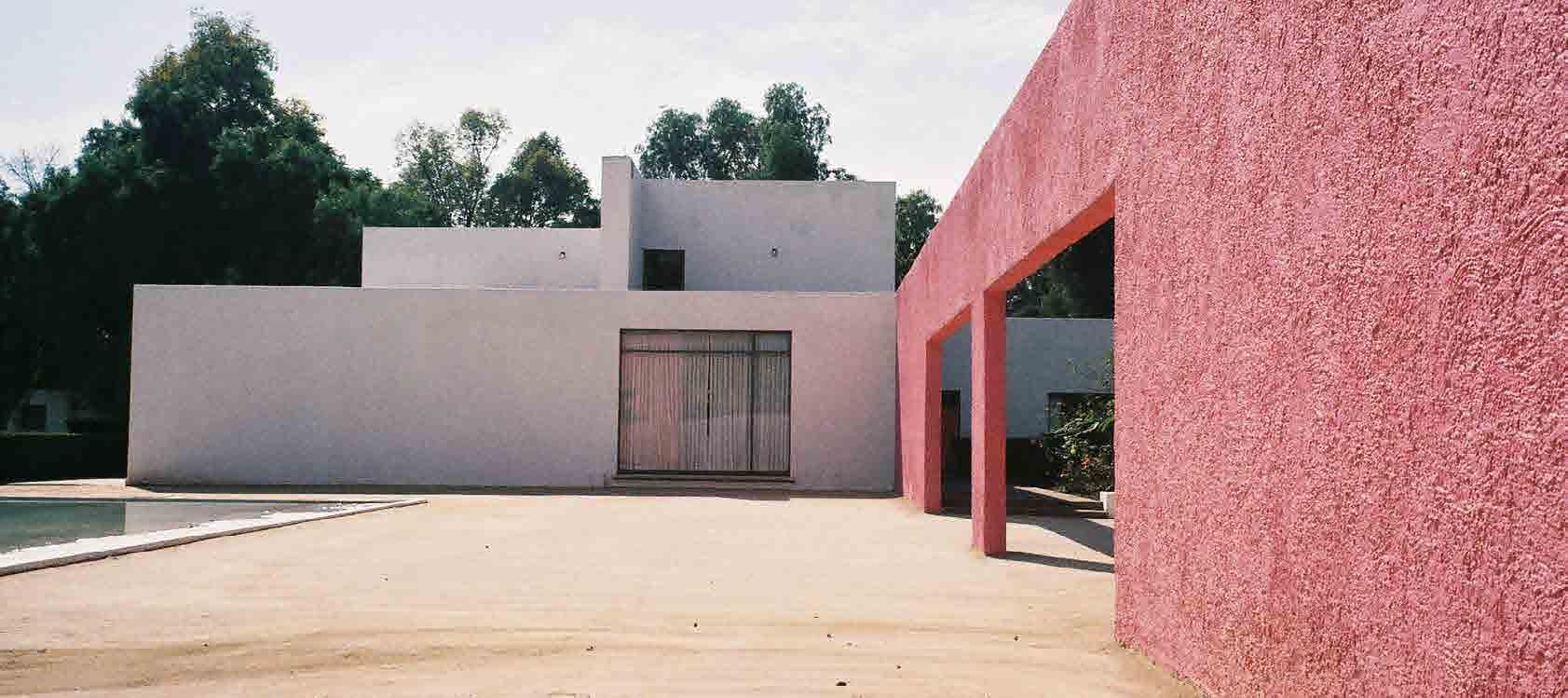
AUTUMN / WINTER 2017
SHOWROOM
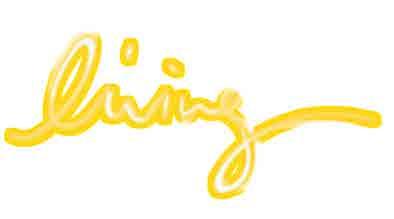
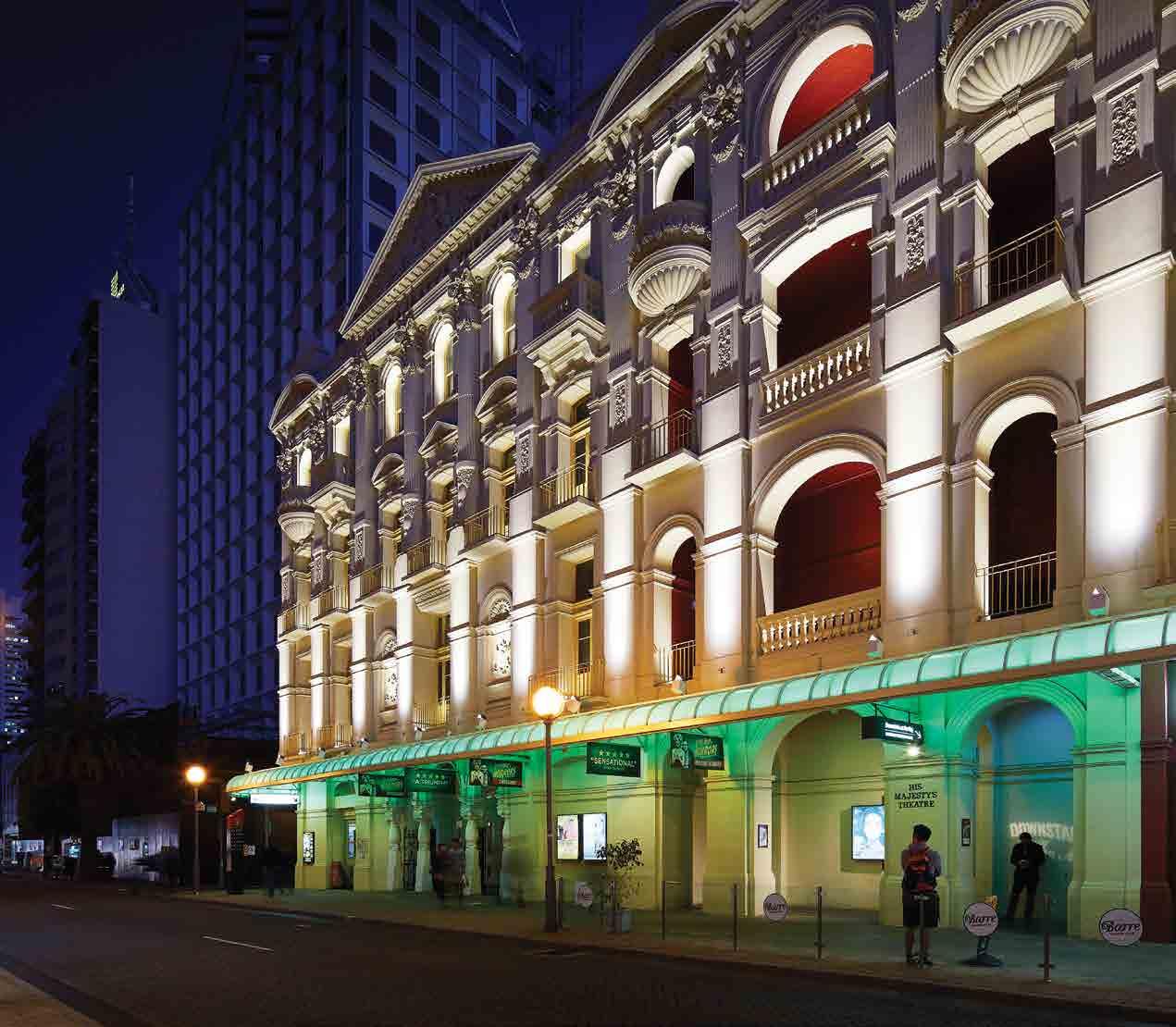 Mondoluce is the sole importer and distributor for iGuzzini in Western Australia.
Mondoluce is the sole importer and distributor for iGuzzini in Western Australia.

His Majesty’s Theatre in Perth is one of Perth’s oldest and most iconic heritage buildings and one of the key buildings in Heritage Perth’s “Light up the City” program. After a near 5 year long design and implementation process the façade lighting was recently unveiled with much media fanfare and to great acclaim from the general public. Using low energy consuming LED technology, the lighting design fully complies with the sustainable guidelines of the Light up the City program and has managed to validate the buildings architectural features without compromising the buildings heritage façade.
From the outset the lighting design was developed to bring out the architectural features of the building while keeping the origin of the light (the light fixtures) as “invisible” as possible. The ornamental balconies and columns determine very much the architecture signature of the building and hence dedicated and localised lighting to enhance those was conceptualised with careful positioning and coverage.
CLIENT Perth Theatre Trust / Heritage Perth LIGHTING DESIGNER Klaasen Lighting Design –Martin Klaasen / Stan White ELECTRICAL CONSULTANT ETC
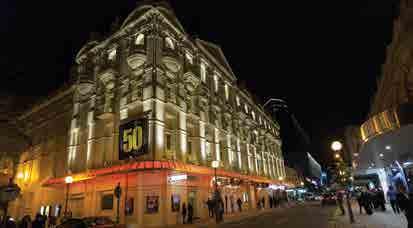
Klaasen Lighting Design – Martin Klaasen / Stan White LIGHTING DESIGNER For more information speak to one of our lighting application specialists or visit the online project page using the QR code reader on your smart-phone. +61 8 9321 0101 mondoluce.perth mondoluce.com.au
HERITAGE CONSULTANT Phil Griffiths ELECTRICAL CONTRACTOR Tech Works – Electrical Solutions PHOTOGRAPHER Ron Tan



DESIGN BEGINS WITH THE LINE

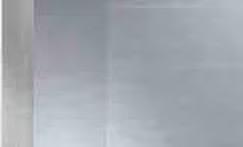

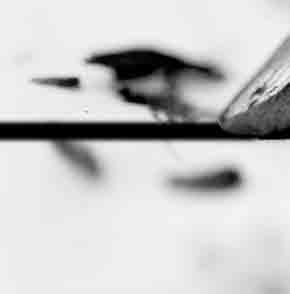
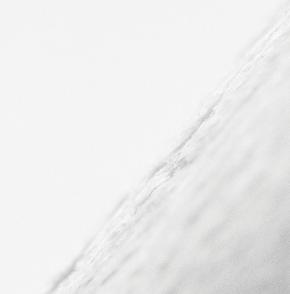
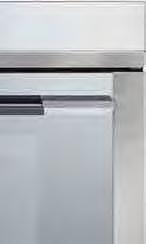

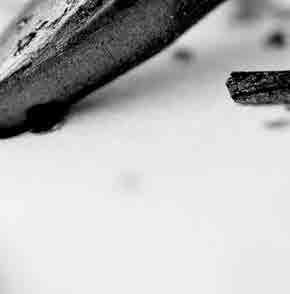

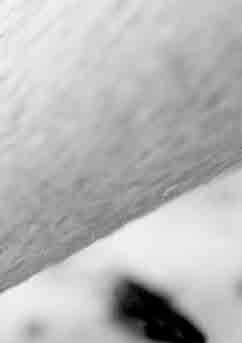
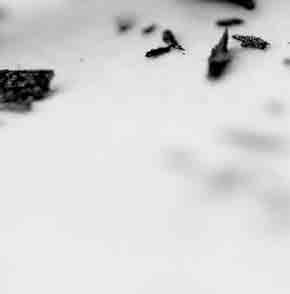
MINIMAL, MODERN AND ELEGANT. UNSURPASSED COOKING TECHNOLOGY.

OVENS •
•
•
•
COMPACT OVENS
WARMING DRAWERS
COFFEE MACHINE
COOKTOPS
smeg.com.au SMA17034




The Official Journal of the Australian Institute of Architects: WA Chapter
CONTENTS
4 contributors
5 editor’s message
7 WA chapter president’s message
work
12 woods bagot at the palace
18 EHDO
20 yolk property group + harris architects
22 lumos property
24 graduates’ work-readiness?
rest
28 white house / meaghan white architects
34 family retreat
36 boonooloo road grouped housing project / CODA studio
42 step house / david barr architect
46 alex hotel / spaceagency
52 the value of the sabbatical
play
56 JSRACS kindergarten / brooking design
58 a playground away from home
64 north perth apartment / simon pendal architect
68 jungle g ym
72 i’ll meet you at the bar
78 festivals and the architecture of the city
82 playing skittles
work
/ rest / play
86 artists in residence
90 ise secret sushi
96 barragan’s mexico
114 a word from the wise
116 ten from ten
. . .
128 is there a place for playfulness in architecture?
The Architect has been in circulation since 1939 and is highly valued by both Institute members and the broader design professions. Generous financial contributions from architects over the years have helped sustain the magazine and we thank the following practices:



- 3 -





Dr Lynn Churchill
‘White House / Meaghan White Architects’.
Lynn is an academic at Curtin University.
Reece Currey
‘Boonooloo Road Grouped Housing Project / CODA Studio’.
Reece is a graduate architect at Taylor Robinson Architects.
Sarah McGann
‘Step House / David Barr Architect’.
Sarah is an architectural researcher and a Professor at the University of Notre Dame in Fremantle.
Beth George ‘North Perth Apartment / Simon Pendal Architect’.
Beth is a practitioner in architecture and Assistant Professor at The University of Western Australia.
Tess O’Brien ‘Barragan’s Mexico’.
Tess is a graduate architect at CODA Studio.
Tenille Teakle and Stirling Flectcher
‘Woods Bagot at the Palace’. Tenille is an Associate and Stirling the Workplace Interiors Leader, both at Woods Bagot.
Dimitri Kapetas
‘EHDO’. Dimitri is co-Director of EHDO.
Pete Adams and Jono Harris
‘Yolk Property Group + Harris Architects’. Pete is co-Director and co-founder of Yolk Property Group. Jono is Design Director at Harris Architects.
Ben Caine
‘Lumos Property’. Ben is an architect at Hames Sharley and co-founder of Lumos Property.
Jonathan Lake and Hew Roberts ‘Graduates’ Work-Readiness?’
Jonathan is Senior Associate and Practice Leader of Interior Design at HASSELL. Hew is a graduate architect at BVN Sydney.
Fiona Giles
‘Alex Hotel / spaceagency’.
Fiona is an English architectalmost new to Perth - and has enjoyed the welcome of the WA architectural community.
Kelwin Wong
‘The Value of the Sabbatical’. Kelwin is an architect, writer and graphic designer.
Hayley Curnow
‘JSRACS Kindergarten / Brooking Design’. Hayley is an interior designer at Geyer Perth.
Gerry Kho
‘A Playground Away From Home’. Gerry is Principal at Gerry Kho Architects.
Warranty: Persons and/or organisations and their servants and agents or assigns upon lodging with the publisher for publication or authorising or approving the publication of any advertising material indemnify the publisher, the editor, its servants and agents against all liability for, and costs of, any claims or proceedings whatsoever arising from such publication. Persons and/or organisations and their servants and agents and assigns warrant that the advertising material lodged, authorised or approved for publication complies with all relevant laws and regulations and that its publication will not give rise to any rights or liabilities against the publisher, the editor, or its servants and agents under common and/ or statute law and without limiting the generality of the foregoing further warrant that nothing in the material is misleading or deceptive or otherwise in breach of the Trade Practices Act 1974.
Important Disclaimer: The views expressed in this publication are those of the individual authors and do not necessarily reflect the position of the Australian Institute of Architects. Material should also be seen as general comment and not intended as advice on any particular matter. No reader should act or fail to act on the basis of any material contained herein. Readers should consult professional advisors. The Australian Institute of Architects, its officers, the editor and authors expressly disclaim all and any liability to any persons whatsoever in respect of anything done or omitted to be done by any such persons in reliance whether in whole or in part upon any of the contents of this publication. All photographs are by the respective contributor unless otherwise noted.
Finn Pedersen
‘Jungle Gym’. Finn is a Director of iredale pedersen hook architects.
Jess Beaver
‘I’ll Meet You at the Bar’. Jess is a graduate architect at MJA Studio Perth.
Brett Wood-Gush
‘Festivals and the Architecture of the City’. Brett is Director Urban Design at the Metropolitan Redevelopment Authority.
Sarah Foley
‘Playing Skittles’. Sarah is an architect and Director at Bosanquet Foley Architects.
Michelle Hovane, Koral (Island) Ward, Daniel Aisenson and Stripe ‘Artists in Residence’.
Michelle is Artistic Director at Sensorium Theatre. Koral is an escaped academic and life-long writer of momentary texts. Daniel is a Director at donaldson+warn. Stripe is a poet, performer and bee keeper.
Brett Mitchell ‘Ise Secret Sushi’. Brett is a creative practitioner working between academia and various small practices.
Brad Wetherall and Mary Ong ‘A Word from the Wise’.
Brad is a graduate architect at Slavin Architects. Mary is an architect at Morley Davis Architects.
Peter Bruechle ‘Is There a Place for Playfulness in Architecture?’
Peter is a structural engineer, author of Egotecture? (2016) and Honorary Fellow of the Australian Institute of Architects.
Editor Olivia Chetkovich
Managing Editor
Michael Woodhams
Editorial Committee
Emma Brain
Jaxon Webb
Kelwin Wong
Magazine Template Design
Public Creative
Proofreading Martin Dickie
Publisher
Australian Institute of Architects WA Chapter
Advertising Kim Burges kim.burges@architecture.com.au
Produced for Australian Institute of Architects WA Chapter 33 Broadway Nedlands WA 6009 08) 9287 9900 wa@architecture.com.au www.architecture.com.au/wa
Cover Image
Cuadra San Cristobal/ Egerstrom House by Luis Barragan. Credit: Tess O’Brien.
Internal Covers
work: Woods Bagot office by Woods Bagot. Credit: Dion Robeson.
rest: Alex Hotel by spaceagency. Credit: Anson Smart. play: Skittles by Bosanquet Foley Architects. Credit: Clyde Yee.
work / rest / play: San Miguel de Allende. Credit: Tess O’Brien.
Price: $12 (inc gst) AS ISSN: 1037-3460
- 4 -
CONTRIBUTORS
editor’s message
Author Olivia Chetkovich
In putting together the previous issue of The Architect (Spring 2016) on the theme ‘EQUITY’, we had a pretty clear focus, although tried to explore this through various experiences and concerns. We received a wealth of feedback on the content – I think reflective not only of the timeliness of the theme, but also the distinct nature of the insights shared. It was an interesting and rewarding experience to delve so specifically into one theme. For this issue however we have pulled our focus back out to a broader theme of ‘WORK / REST / PLAY’. A common triplet (thanks perhaps in most part to the Mars Bar), WORK / REST / PLAY offers the opportunity to explore different projects, practices, experiences and approaches, and the intermingling of work, rest and play within these.
In examining WORK we sought pieces exploring how architects work and the different expectations of the modern architecture office. What we received are a collection of stories reflecting the changing workforce: from designing for the agile workplace, to working outside the ‘traditional’ bounds of the profession, to expectations of graduates.
For REST we examine places for, and the value of, this pursuit. In examining where and how we rest, we reveal the many forms this may take: from the sabbatical, to a family retreat, to establishing boundaries within one’s own home, to encouraging interactivity, and even play, with others.

And so onto PLAY, where we examine spaces, events and endeavours for a variety of users: from children through to adults and the community at large; each type embracing play with different measure. From the experimental, to the considered, to the whimsical, to the performative, each story reveals the element of play that architects seek and can bring to a variety of projects and endeavours. (Although, as our back page piece questions, is there a place for playfulness in architecture at all?).
What is clear throughout the issue though is that rarely does one project or endeavour sit solely under one of these headings - as noted by several of our contributors in their reviews, interviews or essays. Is it perhaps that the richness in any of these initiatives comes from the influence of, or veering towards, another element of WORK / REST / PLAY?
Indeed some projects by their very remit aim to draw these elements together, mirroring not only distinct elements in society where this has
a rich heritage (such as artistic communities), but also the wider phenomenon of the intermingling of these elements in the changing understanding of modern work practices. Outside of the office, travel, be that for business or leisure, offers an opportunity to expand and reflect upon one’s own experience of architecture, and travel prizes in particular have a certain fluidity in their definition between work, rest and play. As the blurring of these boundaries poses challenges for many professionally, travel offers the opportunity for this to be explored with curiosity and often unanticipated reward.
As technology brings work more and more into rest and play, how we negotiate this new territory is an area of both concern and potential –reflective of a profession typified by passion, initiative, commitment and adaptation.
As a final note, this will be my last issue as editor of The Architect. The assembling of this journal, for the members of the editorial committee and our contributors alike, itself sits across the three fields of work, rest and play. The generosity of time and energy of all involved each issue has seen the continued production of this important and hopefully persistently relevant publication. My thanks to all involved, Olivia •
- 5 -


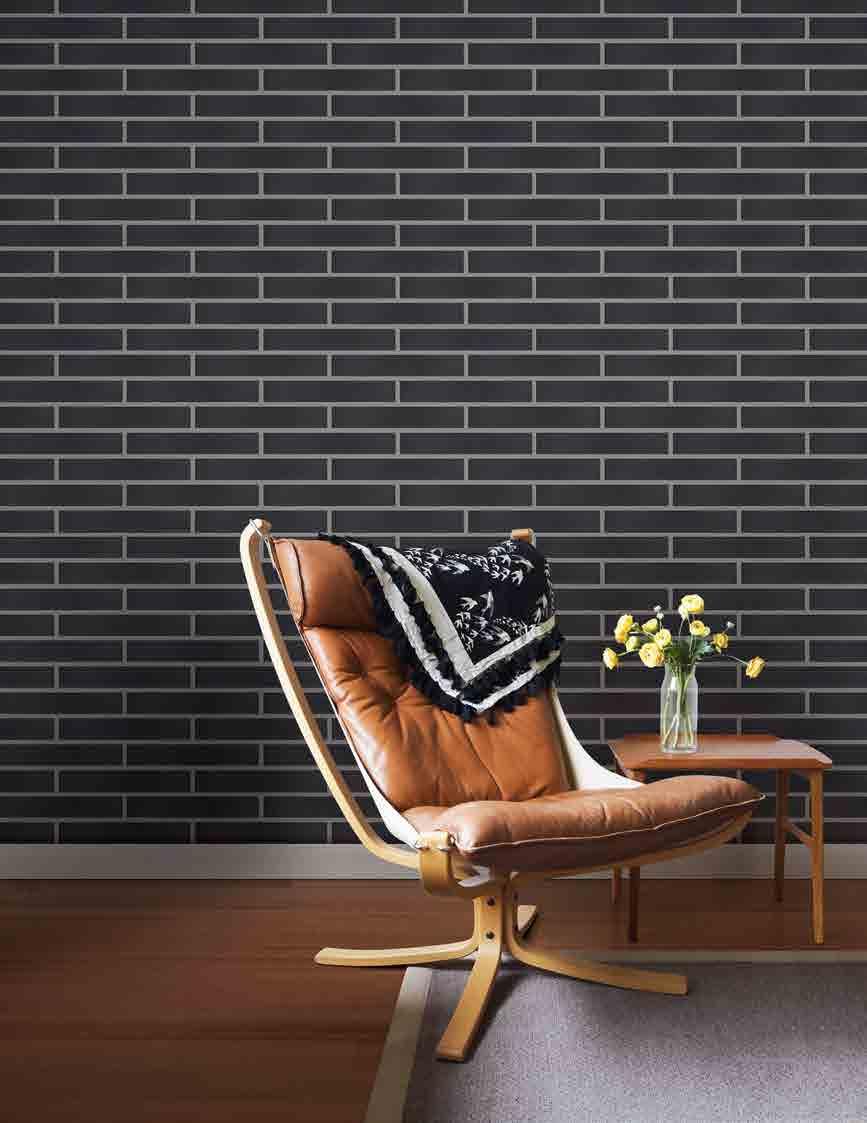

wa chapter president’s message
Author Suzanne Hunt
I was honoured to be elected President of the Australian Institute of Architects (WA) earlier this year, a role I am enthusiastic about and one that brings enormous responsibility helping to deliver practical reforms to the architecture profession.
As a mother of four, director of a busy practice and board member, there are few other issues I feel more qualified to comment on than the elusive mix of work, rest and play. With 30 years of experience behind me I’ve seen the best and worst of how our profession responds to lifestyle and social issues. Today’s architects face a barrage of challenges to stay in the game and the Institute has never had a bigger role to perform.
Architecture as a profession is changing and the Institute, as the peak representative body, is also going through a period of significant change. There was a perception over a long time that it was a bit of an ‘old boys club’, something that was preventing it from embracing the more contemporary issues facing members. As the first female President I take this very seriously and I am delighted that our Council is now in its second year of gender parity. We are a relevant and progressive organisation and our members are the heart of the organisation.
In fact, we are evolving into a very strong advocacy body with a multidimensional focus: advocacy - arguing for important changes in architectural standards, government policy and public awareness about the value of architects; education – helping to

raise standards in university courses; member services – the provision of events and activities to assist members in the management of their careers – things like targeted continuing professional development (CPD), mentoring and networking opportunities to help build contacts.
Members tell us everyday that their priority is addressing the undervaluing of our expertise and the effect that has on work opportunities. As such we are providing targeted advocacy to government and the public about our experience as university trained, registered and insured professionals. Part of our vision is to become more influential, something akin to the Chamber of Commerce and Industry or the Australian Medical Association – organisations that are the first port of call for policy makers and respected for their professionalism, knowledge and know-how in their field.
Continuing the work of my predecessor Philip Griffiths we will strive to improve our public profile and become more visible in the media on issues that affect our membership. Personally I want the Institute to be more collaborative
with fellow organisations in the built environment such as the Association of Consulting Architects (ACA), Australian Institute of Landscape Architects (AILA), Design Institute of Australia (DIA) and Planning Institute of Australia (PIA).
We devoted the last issue to ‘equity’ and looked at concerns around gender, many of which feed into ‘work, rest and play’. Access to employment, career stagnation during and after extended leave, and inflexible working arrangements all put considerable strain on someone trying to get ahead. I am asking our committees to consider these things in tandem with their terms of reference. Our Gender Equity Taskforce (GET) and Emerging Architects and Graduates Network (EmAGN) are developing good programs like mentoring and talks to inspire all architecture professionals as their working lives develop. Equally we have established a CPD Reference Group to help us keep pace with industry and you will be very pleased that the price of events has been significantly reduced. No excuses for not coming along!
I would like to finish by remembering the lives of three Western Australian architects who made an outstanding contribution to our built environment over several decades. Vale Noel Ryan, John Lidbury and Darryl (Spook) Way. They would have loved this issue and I hope you do too.
We are always looking for new members to join our committees and reference groups. Please get in touch with the chapter office if you are interested. Details page 4. •
- 7 -
Rawlinsons Australian Construction Handbook and Rawlinsons Construction Cost Guide 2017.
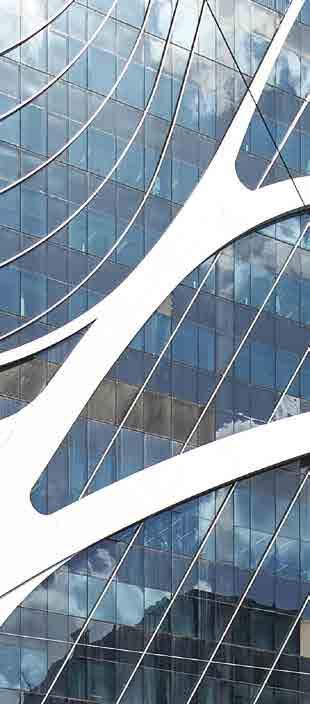
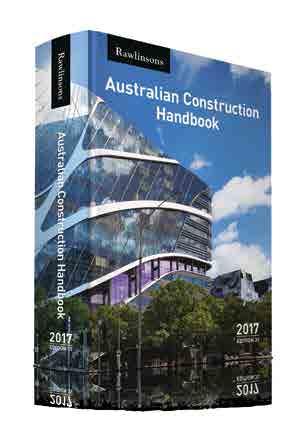
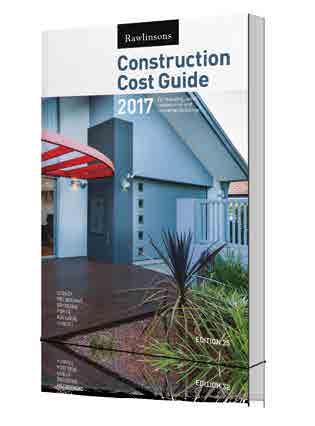
- 8Rawlinsons HAND BOOK $420 INC GST COST GUIDE $285 INC GST Reflect on the budget
PH 1300 730 117 OR WWW.RAWLHOUSE.COM AVAILABLE NOW
1 COSTINGS
ESTIMATING AND CONSTRUCTION COSTS COSTINGS COURTESY OF RAWLINSONS, EDITORS OF RAWLINSONS AUSTRALIAN CONSTRUCTION HANDBOOK
ESTIMATED BUILDING COST PER SQUARE METRE, PERTH – FEBRUARY 2017
PRICES PER SQUARE METRE GIVEN UNDER THIS SECTION ARE AVERAGE PRICES FOR TYPICAL BUILDINGS AND, UNLESS OTHERWISE STATED, EXCLUDE FURNITURE, LOOSE OR SPECIAL EQUIPMENT AND PROFESSIONAL FEES. IT MUST BE EMPHASISED THAT ‘AVERAGE’ PRICES CAN NEVER PROVIDE MORE THAN A ROUGH FIRST GUIDE TO THE PROBABLE COST OF A BUILDING. PRICES QUOTED ARE FOR THE METROPOLITAN AREA. THE MEASUREMENT OF THE SQUARE METRE AREA OF A BUILDING IS IN ACCORDANCE WITH THE METHOD ADOPTED BY THE NPWC: THAT IS, LENGTH AND WIDTH MEASUREMENTS TO BE TAKEN BETWEEN THE INNER FACES OF THE OUTER WALLS. COSTS EXCLUDE THE GOODS AND SERVICES TAX (GST) EXCEPT RESIDENTIAL HOUSES AND FLATS.
OFFICES AND BANKS
SUBURBAN BANK
Maximum 2 storeys, including standard finish, air conditioning, bank fittings, no lift
OFFICES
Low rise 3 storeys, air conditioning, lifts, standard finish
Medium rise 4 to 7 storeys, air conditioning, slow lifts, standard finish
Medium/high rise 7 to 20 storeys, air conditioning, medium speed lifts, standard finish
$ per square metre
2,665.00-2,870.00
2,185.00-2,355.00
2,445.00-2,635.00
3,320.00-3,580.00
High rise 21 to 35 storeys, air conditioning, multiple high speed lifts, standard finish 4,410.00-4,755.00
High rise 36 to 50 storeys, air conditioning, multiple high speed lifts, standard finish
CIVIC ETC
CIVIC CENTRE
Main hall 300/500 capacity and suitable for cabarets, conventions, anterooms, small kitchen, no air conditioning
4,870.00-5,250.00
$ per square metre
2,045.00-2,205.00
Main hall capacity 500/750, lesser hall, library and kitchen, including air conditioning 3,095.00-3,335.00
LIBRARIES
Maximum 3 storeys, air conditioning, good standard finishes, excluding loose fittings
2,765.00-2,980.00
SUBURBAN POLICE STATION
Single storey, partial air conditioning, standard finishes, small cell block 2,615.00-2,820.00
INDUSTRIAL
FACTORY OR WAREHOUSE
$ per square metre
Simple single storey with small span, including office accommodation 795.00-855.00
Single storey with large span, for heavy industry, including administration office and amenities area (factory 85% of area)
1,210.00-1,305.00
Multi-storey, maximum 6 storeys, including goods lift and office accommodation 1,580.00-1,705.00
MOTELS AND HOTELS
MOTELS/HOTELS
Motel, single or double storey, standard travellers-type accommodation, individual toilet facilities, dining room, unit air conditioning (cost per bedroom unit $74,600.00–$80,400.00)
Motel, single or double storey, high standard accommodation, restaurant and lounge facilities, swimming pool and other amenities, fully air conditioned (cost per bedroom unit $101,000.00–$108,800.00)
$ per square metre
2,295.00-2,475.00
2,765.00-2,980.00
Tavern, including air conditioning 2,625.00-2,830.00
City hotel, medium to high rise, including air conditioning and lifts, having 60-65% accommodation area (cost per bedroom $345,500.00–$372,500.00)
RECREATIONAL
CLUB PREMISES, SQUASH COURTS, RECREATION CENTRES ETC
5,120.00-5,520.00
$ per square metre
Social/sporting club building, maximum 2 storeys, air conditioned, bars, kitchen and dining area, dance area, club offices, limited carparking
Single storey sports pavilion with toilets and changerooms, minimum finish
Basketball centre
1,650.00-1,780.00
3,475.00-3,745.00
AGED PERSONS’ HOMES (including GST)
Single storey housing units and additional central care units (cost per unit $127,600.00–$137,600.00) 2,125.00-2,295.00
Multi-storey units + min. lift service (cost per unit $125,800.00–$135,600.00) 2,735.00-2,945.00
EDUCATIONAL, SCIENTIFIC AND CULTURAL SCHOOLS $ per square metre
Primary or secondary, maximum 3 storeys, standard finishes, buildings only 1,700.00-1,830.00 Laboratory block, maximum 3 storeys, including fittings 2,270.00-2,445.00
UNIVERSITY
Administration block, including air conditioning 2,330.00-2,515.00
Tutorial staff and lecture rooms block, including air conditioning 3,065.00-3,305.00
Lecture theatre (250 seats), including air conditioning 3,340.00-3,600.00
Library, maximum 3 storeys, including built-in fittings and air conditioning but excluding moveable furniture 3,045.00-3,280.00
4,020.00-4,335.00
2,465.00-2,655.00
HOSPITALS AND MEDICAL CENTRES $ per square metre HOSPITALS District, single storey, 60-bed, operating theatre and partial air conditioning (cost per bed $200,500.00–$216,200.00) 3,715.00-4,005.00
General, multi-storey, 200-bed, including air conditioning and lifts (cost per bed $520,500.00–$561,000.00) 5,780.00-6,230.00
Maternity, multi-storey, 100-bed, including air conditioning and lifts (cost per bed $232,600.00–$250,700.00) 4,650.00-5,015.00
General practitioner medical centre, single storey, consulting rooms, surgery and small theatre, partial air conditioning 1,905.00-2,055.00
SHOPPING CENTRES AND DEPARTMENT STORES $ per square metre
RETAIL PREMISES
Single storey retail/showroom type, standard 'shell' construction, excluding air conditioning and fitting-out work
750.00-805.00 Super market, single storey, air conditioned but excluding fitting-out work 1,575.00-1,700.00
Regional complex, single or 2 storey, medium standard, including air conditioning, malls, circulation areas, excluding shop fitting-out work and carparking
2,070.00-2,235.00 Arcade shops under office tower 3,745.00-4,035.00
2,575.00-2,775.00
2,390.00-2,575.00
1,295.00-1,395.00
$125,200.00–$135,000.00)
Squash courts, basic developer standard (cost per court
1,390.00-1,500.00 Squash courts, high standard (cost per court
$225,500.00–$243,000.00)
Community recreation centre, basic standard
Community recreation centre, medium standard
50 metre x 21.0m wide x 1.0/2.4m deep pool, fully formed, including filtration and pool siteworks but excluding heating and ancillary buildings (total cost $)
1,880.00-2,025.00
1,000.00-1,075.00
1,255.00-1,350.00
1,604,000.00-1,729,000.00
CINEMAS $ per person
Cinema, group complex, inner-city, including seating, stage equipment and air conditioning
CARAVAN PARKS
Basic standard caravan park, including communal facilities, electric power to all bays, small office, roads and parking
12,460.00-13,430.00
$ per bay
20,500.00-22,100.00
Medium standard caravan park, including communal facilities, electric power to all bays, office and retail, laundromat, barbecue areas, small swimming pool, roads and parking 28,880.00-31,130.00
High standard caravan park, including individual facilities and full services to each bay, office and retail, laundromat,barbecue areas, small swimming pool, roads and parking
RESIDENTIAL
HOUSES (including GST)
Suburban store of large chain, single storey with large open-plan sales area, including air conditioning but excluding carparking 1,835.00-1,980.00 City store, low to medium rise, fully air conditioned, served with escalators and lifts, inclusive of shopfronts but excluding shop fitting-out work 2,685.00-2,890.00 Parking areas, bitumen paved including lighting and storm-water drainage (per car $2,675.00–$2,870.00)
81.00-87.00
MISCELLANEOUS $ per square metre
ECCLESIASTICAL Church hall
CARPARKS
Multi-storey, basic finish with slow passenger lift (cost per car $23,700.00–$25,500.00)
1,080.00-1,165.00
860.00-930.00 Basement carpark under office tower 1,685.00-1,815.00
PRICE
- 9 -
39,370.00-42,430.00
$ per square metre
Standard
Medium standard individual house 1,680.00-1,810.00 High standard house, no air conditioning but with built-in furniture and good standard finish 2,400.00-2,590.00 Prestige standard, partly air-conditioned 3,220.00-3,470.00 Townhouse, medium standard, 2 storey 1,815.00-1,955.00
project home (medium standard) 945.00-1,020.00
lift,
standard
per flat
Multi-storey with lift and prestige standard of finish
per flat $660,000.00–$711,500.00)
FLATS (including GST) One and two bedroom units, maximum 3 storeys, no
minimum
(cost
$99,100.00–$106,800.00)
(cost
conditioning
Residential college
Laboratory + science block, maximum 3 storeys, including air
Chapel or church, simple structure 1,495.00-1,610.00 Chapel, church or synagogue, medium standard 2,245.00-2,420.00 Chapel, church or synagogue, high standard 3,190.00-3,435.00
Building Building BuildingBuilding
JuneIndexJuneIndexJuneIndexJuneIndex
June232.39232.97234.71237.06240.61246.63251.55 September232.39233.55235.88237.65241.80247.85252.80 December232.39234.71235.88238.23242.99249.06254.04
– to assess the percentage variation in cost between June 1999
100 = 7.68% 8.99 117.08 1
INDEX This index is not valid for housing, small projects or remote country work.
DatePriceDatePriceDatePriceDatePrice
1994106.041998115.342002126.072006180.45 1995107.631999117.082003133.102007200.20 1996111.422000122.382004147.242008216.14 1997113.652001123.582005163.872009224.46 20102011201220132014201520162017 March228.95232.39234.71236.47239.42245.42250.31255.06(F)
Example
and June 2002: Jun-99=117.08 Jun-02=126.07=8.99x
- 11work
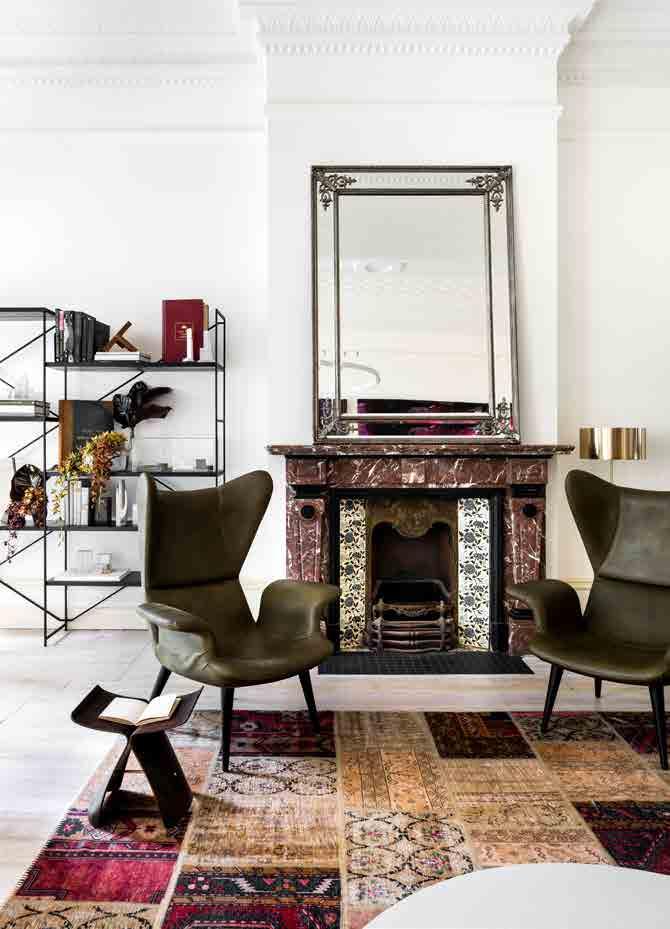
- 12 -
Woods Bagot office by Woods Bagot. Image: Dion Robeson.
woods bagot at the palace creating an agile workspace
An interview with Tenille Teakle, Associate (TT) and Stirling Fletcher, Workplace Interiors Leader (SF)
Your previous studio was located in one of the more interesting pockets of inner city Perth; what prompted the shift to a new space in the heart of the business district?
TT: Woods Bagot inherited a site that was held dear by the community of Perth over a long period: from its early beginnings as the Swan River Colony’s first licensed premises through to its prominent position as the Palace Hotel (and in turn, its protection by the ‘Palace Guards’ who fought for its preservation after the purchase by Alan Bond). The iconography of one of the few historically significant buildings in Perth was particularly attractive to Woods Bagot, giving us the chance to reinvigorate its purpose while still respecting its past.
SF: We believe that over the period of time we occupied our Kings Street address, the city of Perth has become more interesting and vibrant across a broader geography. With precincts like Elizabeth Quay, The Treasury, Brookfield Place and Perth City Link creating greater pockets of diversity, the location of The Palace is now central within all of these districts. In many ways, The Palace demonstrates it has managed to maintain its centrality for over 100 years within greater Perth.
How would you describe the new studio?
TT: By creating a diversity of spaces, the refurbishment provided Woods Bagot the opportunity to demonstrate its ability to design and deliver a non-
hierarchical contemporary workplace environment with a distinctive hotellike aesthetic, in a nod to the building’s previous function. Key to the innovative design response was bringing the curated elements together to deliver an eclectic mix of work settings and social spaces to support a truly agile workplace.
SF: The project emphasized the ambiguity of what an architectural studio could be in a contemporary context. With mobile technology and a broad diversity of experience across the project, it embraces flexibility and user-driven choice with a general calm ambience reflecting on its origins as a hotel.
How important to the design was the concept of 'activity-based working'? What strategies did you employ to build ABW into the design?
SF: In a first for the practice, the move to a fully agile studio model demonstrates Woods Bagot’s deep understanding of the workplace of the future. A combination of free-seating desks, fixed standing bars, lounge areas as well as diversity of experiences in the enclosed meeting spaces introduces a sense of dynamism and autonomy. This approach also afforded us the luxury to test ideas on ourselves and to challenge our own perceptions. The process has allowed us now to be able to share anecdotally our own experiences of such a process and implement our key learnings in other projects.
This studio feels quite different from your offices on the East Coast; how much consideration was given to its West Australian location during the design process?
TT: Woods Bagot saw the opportunity to celebrate the history of the building while being quite overt in the contemporary installations that could complement rather than compete in a balanced juxtaposition. There are references to the past with a hospitality feel that influenced the aesthetic, married with state-of-the-art technology to support a global architectural practice. For us it was more about being true to the strong history of the space as opposed to trying to create a ‘West Australian office’.
Applying a timeless palette, we wanted the shell of the building to read as a purist white canvas, with reflective polished concrete floors, white exposed ceilings and original balcony doors and architraves in respect of the significant history of the building.
SF: Through the process of design, we uncovered some significant West Australian artifacts that lay dormant in the building, some for up to 100 years. By introducing several of these elements including furniture, historical photos and objects we actually re-engaged with how important this building has been to the development of Perth and Western Australia more broadly. The building almost tells the story of the economic history and the influence of mining,
- 13•
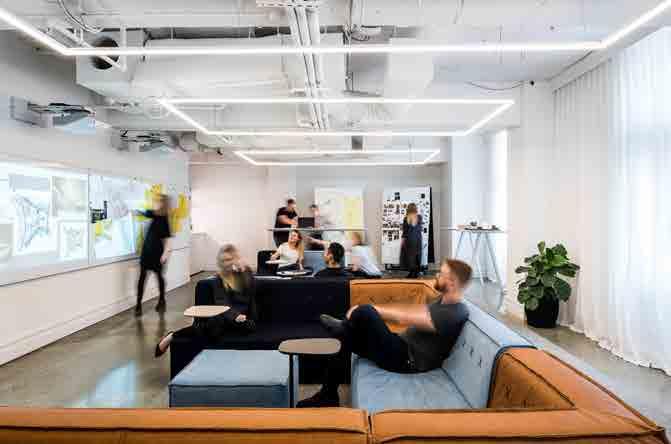
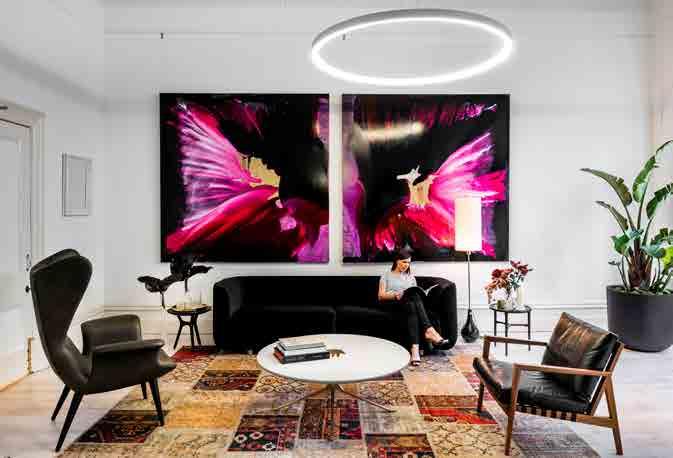
- 14 -
Woods Bagot office by Woods Bagot. Image: Dion Robeson.
Woods Bagot office by Woods Bagot. Image: Dion Robeson.
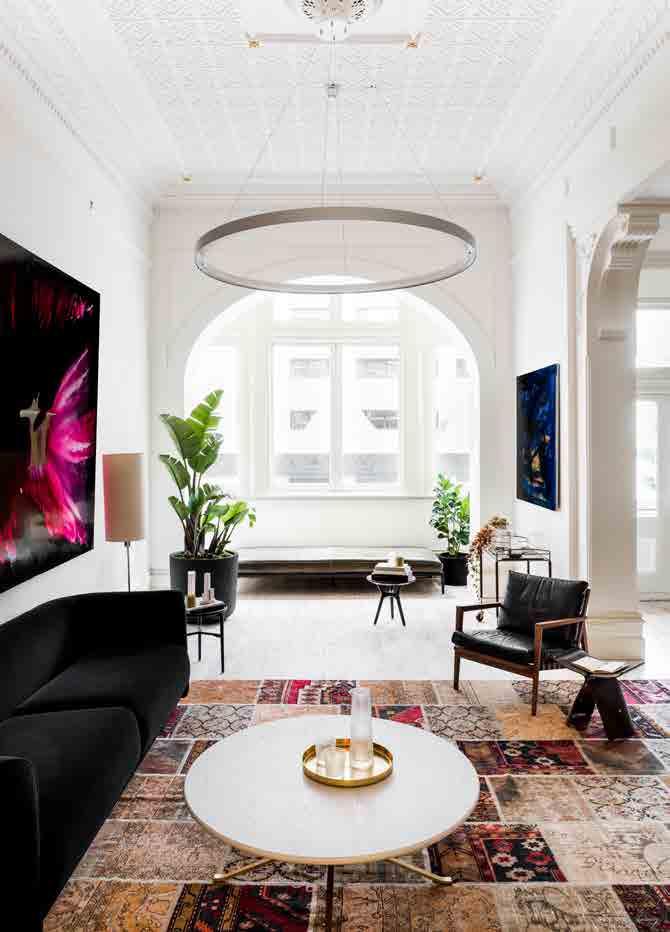
- 15 -
Woods Bagot office by Woods Bagot. Image: Dion Robeson. •
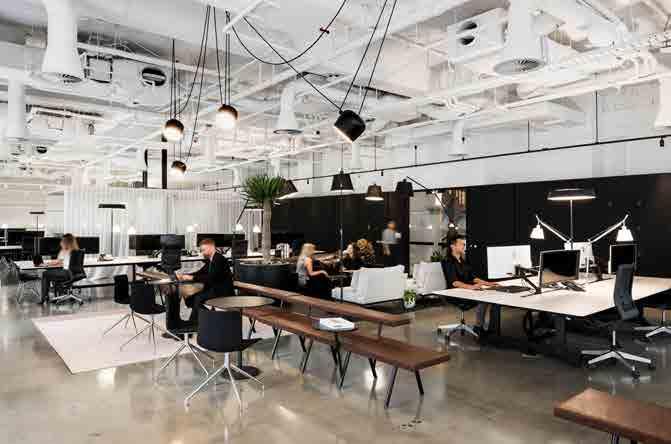
which remains true today, from the Gold Rush origins to the Alan Bond era as well as a previous watering hole for journalists and everything in between.
Have staff inhabited the space as you imagined, or have there been surprises (or even disappointments) as you’ve settled in?
SF: More surprises than anything in the way people have engaged with the environment. Our Dixon Drawing Room acts as an immersive think-tank and has drawn great interest in how we ideate and collaborate both internally and with clients and partners alike. Sharing outcomes through multiple short-throw projection, mobile video conferencing, document cameras and magnetic whiteboards (both fixed and mobile) have created vast and different ways to engage. It was like providing a sand pit and watching how people could manipulate a space to best suit the activity being facilitated and their preferred way of working.
Given your experience in this area, what influence do you think work environment has on productivity and creativity?
SF: Productivity is still a black art in how it is actually measured. However, through freedom of choice we realise the benefits in being able to effectively co-locate teams even for short immediate tasks. Creativity is more dynamic as it responds in real time through our technology and shifting of information across space, rather than static inspiration images that can often lay stagnant for months and become stale unless people are actively curating the material that’s displayed. Having a unique space to retreat as a Woods Bagot family to eat, drink and engage beyond our day-to-day tasks has meant we have built stronger personal relationships and a greater team culture.
Finally, what do you hope the space says about Woods Bagot, your culture and practice?
TT: The key to the design rationale was to reflect and facilitate the evolving paradigm of work to support the
workforce of the future. Responding to the fact that today’s workforce spends more time at work than at home, the Perth Studio design has delivered a tailored experience that supports agile working whilst enriching the firm’s values and culture.
It’s collaborative, collegiate and social. Both the heart of the building and a central meeting place for Woods Bagot staff, clients and guests, the mezzanine level atrium provides an integrated breakout zone while offering the opportunity to host industry and community events. The main circulation stair and lift well run from the ground floor to the second floor, increasing connectivity and fluidity of movement throughout the building and its multiple zones. •
- 16 -
Woods Bagot office by Woods Bagot. Image: Dion Robeson.
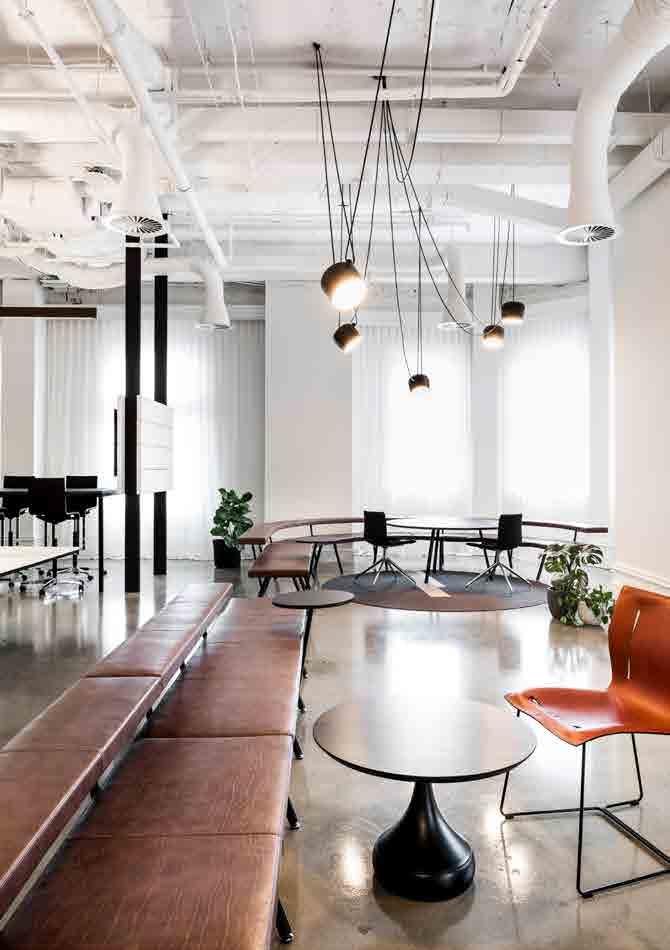
- 17 -
Woods Bagot office by Woods Bagot. Image: Dion Robeson.
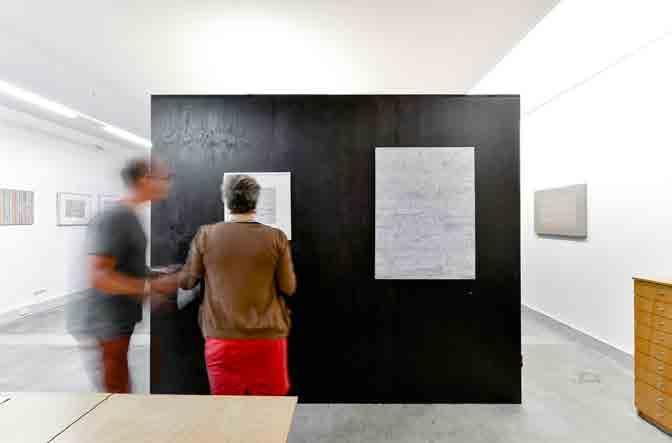
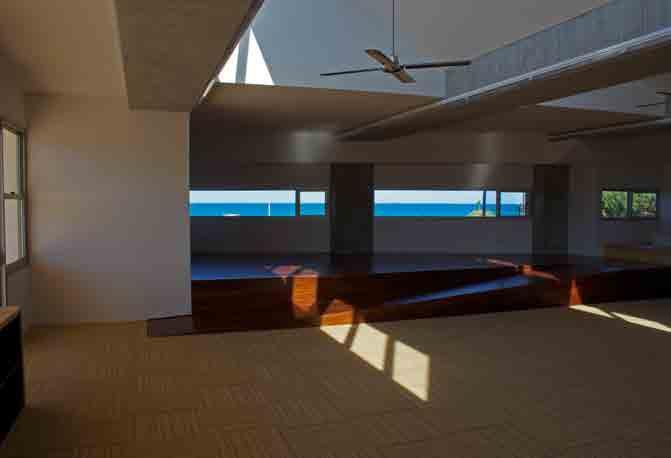
- 18 -
EHDO office by EHDO. Image: Ben Green.
Beehive Montessori School by EHDO. Image: Daniel Cummings.
EHDO working differently
Author Dimitri Kapetas
So, it was a rather haphazard and accidental beginning for EHDO architects. Having quit my architectural degree following an event that took me way off my intended course, I careered around town working three or four unrelated service jobs at a time in a vain attempt to distract myself from myself. After a couple of years Giles Hohnen, the father of one of my best pals, asked if I could help him out with some drafting at his design practice Earth House. I joined him for one day a week which soon became two… three until finally I had dropped all my other jobs and was full-time.
Already an established artist, Giles turned his hand to building in the early 80s in Margaret River and became a world pioneer in rammed earth. Increasingly discouraged by his interactions with architects, Giles began to design his own buildings which in turn led to the formation of Earth House, a design studio focusing on rammed earth construction. His uncompromising approach to the ageold maxim of ‘form follows function’ left an indelible mark upon us and continues to heavily influence our approach to design decisions.
The office had a clear philosophical program for designing buildings centered around simple, practical building methods, transparent and direct collaboration with clients, builders, trades and consultants and, above all, a genuine commitment to environmental responsibility. I saw
that working in the architectural industry need not resemble the one I had imagined: endless late nights in soulless offices, drafting up buildings that I didn’t believe in for bosses who did not appreciate the sacrifice. An egalitarian casualness, something we still hold sacred in the office, made hierarchy almost invisible. Given huge design decisions to make within weeks of joining the office, I remember feeling an instant pride and responsibility in the work I did as well as feeling much more keenly the responsibility for any mistakes. Soon I found myself re-engaged with my passion for architecture. I was particularly drawn to South Asian buildings designed for climates similar to those in which I grew up. Their openness, connection to landscape, modest material choice and casual, permeable spatial arrangements are concepts that still strongly resonate for us.
The Earth House office was also full of beautiful art by Giles, Eveline Kotai and other local artists and it struck me how important good art was in producing a stimulating and happy workplace. In a scene where there are fewer and fewer venues available for artists, we decided to try and promote this concept by hosting free quarterly exhibitions of local artists' work in our office.
After a couple of years of working for Earth House, the rakish figure of Dave Delahunty came into the office in a state of cantankerous disaffection. During the most desultory ‘interview’
imaginable a simpatico between us all was immediately obvious and the deal was done before we finished our second scotch. He started within the week. Giles must have seen this as the opportunity he needed for escape to concentrate on his art and he soon suggested that Dave and I should buy the business from him. In less than a year we found ourselves co-directors of a design firm which has since become an architectural firm.
Going forward we want to take what Giles began and develop it further, pushing into the realm of medium density, mixed use, affordable housing. We have recently obtained a license to do WA’s first Nightingale project and think the Nightingale model is a fantastic way to start to address the major problems facing our cities. We will all need to embrace some major cultural shifts in the way we inhabit our environment during the next ten years.
EHDO sees our challenge as how to address these necessary changes by looking at what is truly important to people’s psychology and finding ways to satisfy these real emotional needs without neglecting our responsibilities to the environment and our communities. With this approach, we feel that these changes will not prove to be sacrifices but instead will improve and enrich our cities and our lives. •
- 19 -

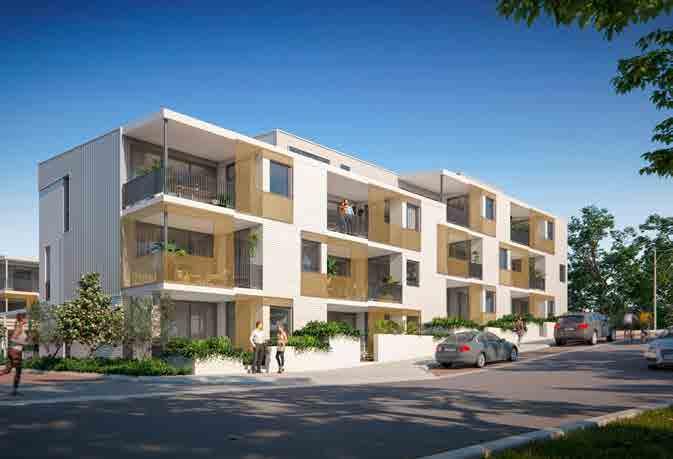
- 20 -
Pete Adams, co-Director of Yolk Property Group and Jono Harris, Director of Harris Architects, sharing a beer back where it all began.
Evermore WGV by Harris Architects. Render by constructive Media.
yolk property group + harris architects working differently
A few beers on a Friday afternoon led to a longstanding friendship between Pete and Jono, as well as a valuable professional partnership between Yolk Property Group and Harris Architects that has resulted in a portfolio of collaborative projects over the past seven years.
Pete Adams, co-Director of Yolk Property Group and Jono Harris, Director of Harris Architects, have been collaborating on projects for almost a decade. Unlike the standard developerarchitect relationship, the men work side by side, both by way of shared office space and in terms of work, resulting in an intuitive and integrated approach to the design development process.
Pete said the concept of sharing an office came about naturally due to their collaborative approach, which starts at the very beginning of project in scouting and evaluating sites.
‘Traditionally, finding a new site falls solely to the developer, but as soon as we finished the first project we’d partnered on, we immediately started searching for potential projects together. I believe to be a design-led developer, design has to be at the core of the business so sharing the office with Jono and his team made perfect sense.’
According to Jono, the co-location offers a number of practical benefits: ‘We can move really quickly on design concepts and bounce ideas around without the usual lag in scheduling client meetings to discuss how projects are progressing – it makes us more “nimble”. ’
Pete said the shared space also allowed for flexibility in terms of being able to make design decisions fast. ‘I come up with an idea and Jono can tell me why it is crap within seconds! The agility with which we can problem-solve because of the office co-habitation is priceless.’
In addition to the positives of proximity, the close-knit partnership and streamlined working style has led to a plethora of other benefits, including an adaptive approach to meet changing market and community needs. ‘We are constantly tweaking our system, so that each new apartment is an evolved version of the last, rather than starting from scratch each time,’ Pete said.
‘Most developers work with a standalone set of consultants on each project and lessons learnt stay purely with the developer to pass onto the next set of consultants; however with the YolkHarris collaboration, this IP belongs to both companies.’
Both agree the partnership has expanded the ordinarily understood roles of architect and developer, resulting in better planning and decision making. According to Jono, ‘Usually the roles and scope of work are quite defined but we’ve added personnel to the Harris team which allows us to provide greater input into projects, taking a far more hands-on approach in areas such as project marketing and apartment styling.’
Demonstrating the strength of the Yolk-Harris collaboration is the Evermore WGV project, due for completion in 2018. An innovative development in White Gum Valley, the project will deliver 24 highlysustainable one, two and three bedroom apartments at Landcorp’s WGV estate. The WGV site was on offer to developers via a request for proposal, with specific and demanding criteria.
‘This is a project full of opportunities and it calls for innovation in both a design and a development sense. It requires a strong shared vision and I think the history and combined expertise of Yolk-Harris was a huge factor in us winning the site,’ Jono said.
Pete said from a development point of view it didn’t tick the usual boxes. ‘This is definitely a step away from the norm – it is strongly centred on innovation and community.’ Evermore WGV will break new ground as the first largescale apartment development in the state to utilise shared solar and battery storage technology in a strata setting. It is aiming to be Western Australia’s greenest apartment development, shaped by Bioregional’s One Planet Living framework, to produce genuinely sustainable apartments.
‘It’s a risk embarking on a development that may not stack up and isn’t a safe bet as a commercial success; however it is a risk we’re both taking equally. It’s also testament to the trust and confidence we have in each other and our shared commitment to paving a new path in design and development,’ Pete said. •
- 21 -
A conversation with Pete Adams and Jono Harris
lumos property working differently
Author Ben Caine
Working on the edge of your seat: the Architect as Developer.
As an architect, it’s easy to look at the completed project and forget about all the issues that kept you awake at night. I found out that developing your own project could take your nightmares to a whole new level.
I always believed that architects should take a greater role in business beyond being a consultant for hire. After all, it’s still about persistence and risk management. Every project encounters its challenges that are often unpredictable. Our apartments in Scarborough encountered just about all of them. And as clichéd as this sounds, the satisfaction of bringing a project to life from scratch is its own reward.
Any entrepreneur will tell you that the key to a successful business is to solve a problem for the customer. We noticed that in the residential market, there was big gap between the high-rise apartment and grouped housing projects. It appeared to us that Perth developers had abandoned the idea of the affordable, small walkup apartment building that was so common in the 60s and 70s. So the problem we identified was that there
must be buyers who can’t afford a townhouse and do not want to live in a high-rise.
Another key to a successful project is to identify your weaknesses and to seek out people who have the skills you don’t: I met Chris Bardsley, a quantity surveyor with a commercial construction background. Chris and I share the same values both professionally and personally but we have different skill sets that complement each other. We decided to team up and founded Lumos Property in 2014. We found a difficult site that a developer had abandoned. We put in an offer and acquired the land. It was a short walk to Scarborough Beach with picturesque views to the east. The site issues could be overcome with clever design so it was easy to see the potential.
Our demographic and field research identified that the Scarborough area has a strong population of upwardly mobile young people who are ready to buy their own place but can’t afford ocean views or large living spaces, especially professional women aged 25-35. This insight dictated
the development design brief and marketing of the project. When the project went to market we were pleased to find that our buyers matched our demographic and field research. We sold 90% of the units off the plan ourselves in just two weeks. We got the formula right.
When we entered the design phase of the project, we chose to work with Justin Carrier at CAPA. Justin had just set up his own architectural firm and had more experience designing apartments than I had. For our first project it did not make sense for me to wear the risk of acting as both the developer and the architect. This allowed CAPA to focus on providing a unique and desirable design while we focused on our buyer’s requirements and cost of construction. Being an architect-developer, we aimed to find ways to support the architect’s vision and follow it through.
Architects often allow themselves to be disconnected from the decisions that have significant cost implications for the client. But when you are the client you have to think differently. The focus must be on delivering the
- 22 -
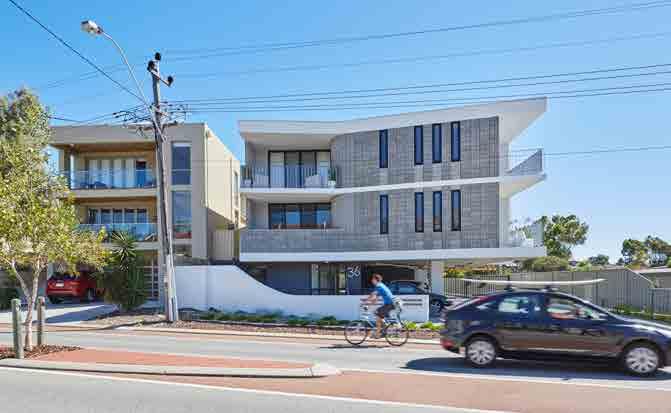
things that the customer cares about and minimising the cost implications of the things they don’t. We refer to this as the hierarchy of quality. For example, we provided high, solid doors and quality hardware because these are things you touch and use every day. They have high impact and low cost.
Even when you get most things right – the feasibility, design, marketing, sales and procurement; you can still encounter unpredictable problems that can have devastating results.
After getting off to a great start, our builder went into receivership. Meanwhile the property values declined and bureaucratic hurdles cropped up at every stage of development, causing delays. Soon the generous two-year completion period was whittled down to just days to spare before the buyers’ sunset clauses took effect. If that happened there was every chance the buyers would walk away and that’s the stuff of real nightmares. Every new challenge had to be met with dogged persistence to do whatever it takes to get the job done. Chris stepped in, taking the role of builder to finish the job
and we employed the builder’s now unemployed site supervisor to provide some continuity. We sought and gained the support of our subcontractors, suppliers, bank, insurers, investors and buyers. We all got on the tools in a race to finish, working nights and weekends.
The effort paid off. Oyster Apartments in Scarborough was completed in August 2016, almost two years to the day we sold the first apartments off the plan. Only now is it possible to stand back and take pride in a great project that nearly imploded, and look forward to starting on the next one. •
- 23 ---
Oyster Apartments by CAPA. Image: Douglas Mark Black.
JONATHAN LAKE
graduates’ work-readiness?
Author Jonathan Lake and Hew Roberts
Priorities and experiences of the work-readiness of architecture graduates: from the perspective of a practitioner and educator, and a graduate.
As a practitioner and educator I have had the opportunity to see both sides of the debate around graduates and their ‘work-readiness’. I’ve witnessed many conversations bemoaning the difficulty employing new graduates and the ‘cost’ to the business above and beyond their immediate salary. Many conversations have been had with peers wanting to know ‘what are they actually learning in those five years?’ and ‘why are they so unprepared for employment at the end of it?’
On the whole, good architectural graduates are work-ready and capable of making significant and valuable contributions to architectural practice. I believe that all good practices recognise this and understand where and how to best extract this out of their graduates. Where the problems occur is when practices are not clear about what they are looking for when they take on a graduate.
To be work-ready is not the ability, straight out of university, to walk into a practice and start documenting a building. Work-ready means the ability to participate and contribute to a group of skilled and experienced practitioners to assist them in achieving a high quality outcome.
To be controversial I would like to suggest that the role of architectural education is not to provide ‘workready’ graduates! If you examine the
course curriculum and the method of education it is clear the role of education is much more ambitious than this. If being ‘work-ready’ was the only focus then a TAFE educated student would probably be a far better prospect for a practice.
Architectural education is about exposure of students to the full breadth of potential experience that could occur in the built environment. It covers all aspects from technical, scientific, historical and conceptual approaches to buildings, structures and spaces. It also covers all aspects of visual and verbal communication techniques and methodologies. To do this the education environment must identify what lies at the core of good architectural graduates, which is the ability to be presented with a question that has to be understood and then interpreted into an idea for an approach to a building or space. Fundamentally the role of education is to train the students to think and behave as a designer. And be learners.
What architectural practices need to do is apply the same design thinking to the employment of a graduate as they would to the development of a project: think about what it is they are actually looking for in a graduate, what problem needs to be solved in the practice. In the majority of cases, what practices are actually looking for are students who are good all-rounders. Students who can think creatively, communicate effectively and who have the flexibility to work on
different types and scales of projects as part of a team. A good graduate is capable of doing this, and then some.
After five years of education a good student has completed an extraordinary number of design proposals. They have had to develop advanced skills in visual communication which are immediately applicable in practice. After five years a good student has had to research a broad range of project typologies. They are able to determine where to look and what to consider to understand what are the leading aspects of contemporary thought in that area. Again, this is immediately applicable to practice. Finally, they have extensive experience in compiling notions and ideas into a clearly identifiable conceptual idea.
It's a tired argument that students are not work-ready and suggests that it only equates to being able to document a building. It belittles the breadth of work that architects and designers in the built environment actually do. A graduate cannot and should not be expected to be able to document a building. However they should be able to learn, with good guidance from an experienced architect, how.
Jonathan is Senior Associate and Practice Leader of Interior Design at HASSELL. Prior to joining HASSELL in 2016 he was Director of Jonathan Lake Architects for 12 years. Jonathan was also Design Studio Co-ordinator at Curtin University from 2005 to 2013.
- 24 -
HEW ROBERTS
The Brief Exercise: Developing Skills beyond Design and Drafting
In hindsight one of the most important assignments that I completed at university was to construct a briefing document as part of my final design studio. By this point I had completed nine design studios over five years; some studio projects being very successful, some not so much. The design brief for my final project was good. It was concise, it was clear, and it was full of possibility. Unfortunately the completed project I submitted 12 weeks later did it little justice.
With such importance placed on the design component of this studio, I often lamented this final design project as a failure and a waste of time. The real value of the brief exercise did not register until a few years after graduation. Creating the brief and formally defining the parameters of a design project had highlighted the importance of being able to facilitate good design. The exercise had swiftly allowed me to understand the relationships between, and to consolidate the important components of, the design project, much more so than I was able to achieve in my design response.
Design studios were the best part of university, providing broad opportunities to explore different design philosophies and building types and for valuable creative development and release. Upon graduating, an interest in houses and detailing and the desire to get a more holistic and hands-on experience of documentation, contract execution and construction led me to
work for small practices. There was a lot to learn, and I wanted to understand as much of it as I could. A desire to be involved in larger scale projects eventually led me to larger firms, which offered exposure to a greater range of roles and opportunities for trained designers within the industry.
Compared to university, learning on the job proved to be mostly ad-hoc and always within a very practical framework. I would often link gaps in my conceptual understanding of some of the more formal aspects of a project back to gaps in my university education. While excellent for creativity, isolated development of the design concept for a studio project was often at the expense of exploring areas of architecture that would be critical to facilitating these designs in practice. The design studios mostly lacked opportunity to conceptualise and contextualise various ‘real-world’ aspects of the studio design projects: front-end feasibility, procurement methods, client relationships and management, project resourcing, collaboration and teamwork, heritage evaluation, sustainability and building performance, costing, and contract use, to name a few. The brief exercise was one of a small number of complementary design studio assignments that allowed conceptual exploration and understanding of the politics and mechanics of the construction industry (in which I would shortly be seeking full-time employment).
The rapid rise of digital technology and growing reliance on computer software in the construction industry has largely seen the death of the useless
graduate, but it has also placed much emphasis on architecture students to develop solid computer skills in order to maximise employability. However this area of architecture is also becoming more competitive, with BIM and datadriven design leading larger practices to seek employees with more technical and specific digital technology and software backgrounds. This has seen a shift in some traditional architectural roles, but also greater opportunity for designers who understand the nature of the industry and marketplace, and who know how to negotiate complex design outcomes through often convoluted or complicated processes.
Hindsight is, of course, 20/20 and gaps will always exist between theory and application. Tertiary education is broad by nature, and a student’s capacity to learn is not limited by course curriculum; however, for architecture students, opportunity exists for more varied conceptual exploration of real-world aspects of design projects in conjunction with design concept development. Perhaps earlier critical exploration into these areas in a design theory-focused environment could be beneficial for future architecture graduates attempting to find their niche and define their career path in a changing job market.
Hew graduated from UWA with a Master of Architecture in 2012 and has since worked for several practices in Western Australia, specialising predominantly in the design and delivery of residential architecture. Relocating to Sydney in 2016, Hew is currently with BVN working on several multi-residential projects. •
- 25 -
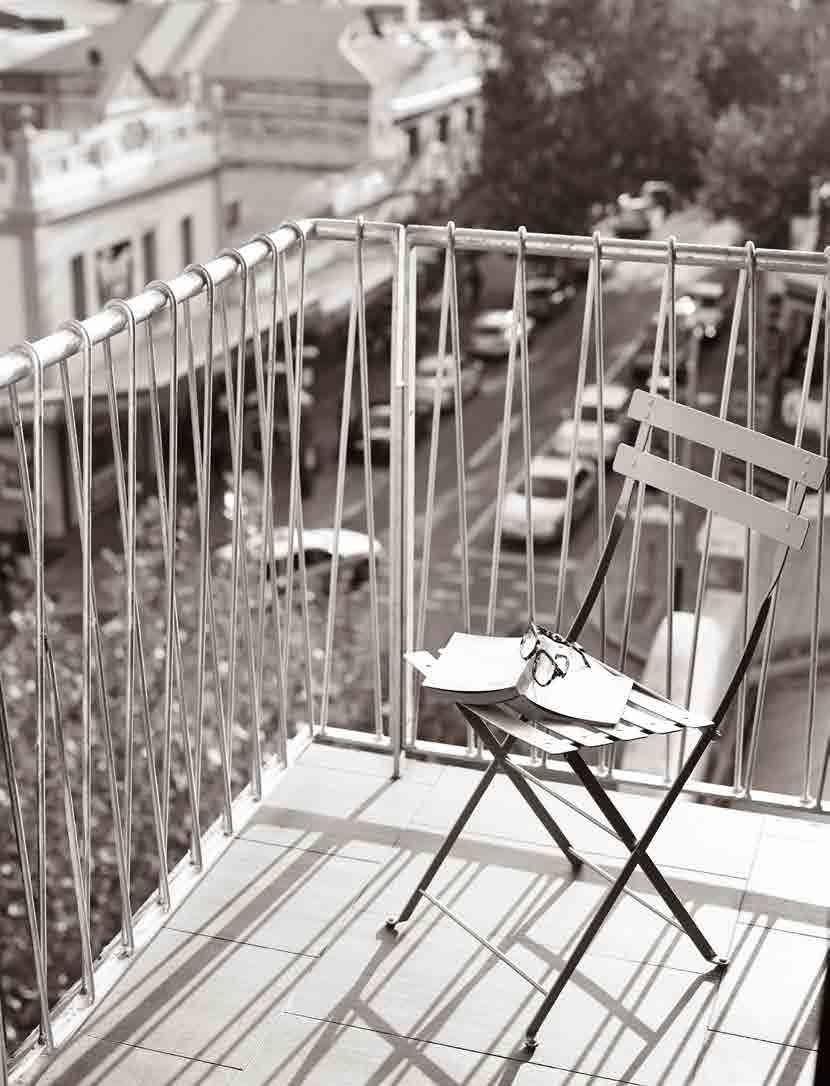
- 27rest
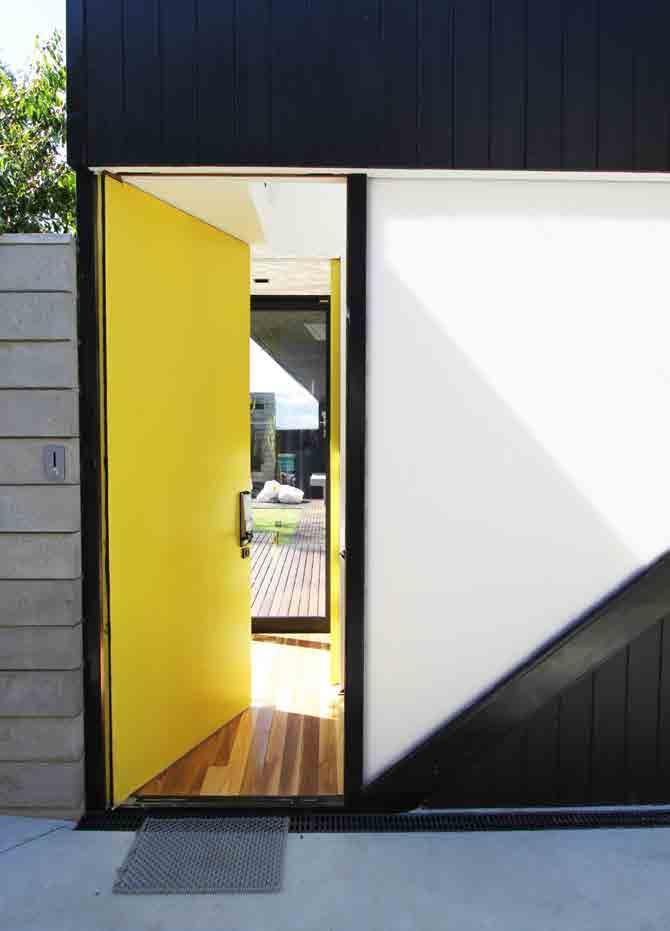
- 28 -
White House by Meaghan White Architects. Image: Deon White.
white house / meaghan white architects
Author Dr Lynn Churchill
The provocation for this edition, WORK / REST / PLAY, immediately conjures questions of ‘realities’ and of ‘boundaries’. Who now knows such things? It seems we are becoming completely perplexed by the dissolution of boundaries and the presence or nonpresence of those around us, virtually or really - including ourselves. If there ever was such a thing as the ability to distinguish ‘work’ from ‘rest’ and these from ‘play’, it has diminished.
Way back in 1967 in his prophetic The Medium is the Massage, Marshall McLuhan wrote: ‘Electric circuitry has overthrown the regime of “time” and “space” and pours upon us instantly and continuously the concerns of all other men. It has re-constituted dialogue on a global scale. Its message is Total Change, ending psychic, social, economic, and political parochialism. The old civic, state and national groupings have become unworkable. Nothing can be further from the spirit of the new technology than “a place for everything and everything in its place”. You can’t go home again.’
Now, fifty years later, concepts and experiences of time, space and human occupation are, as per McLuhan’s insights, in radical flux. The concept of suburban (parochial) life as a zone of respite, a third space separate from the 9-5 demands of the ‘job’ is almost universally unknowable. Ebenezer Howard’s utopic notions of suburbia, the Garden City that envisioned nurturing respite for the worker, have continued to morph throughout the past century
in relation to prevailing economic imperatives to the point where now all boundaries are blurred. Such economic arguments are however beyond the remit of this piece even though architecture is always complicit.
Similarly, technology is always complicit, and there are numerous complicities. Firstly, we the consumers are personally to some large extent responsible for the dominance of technologies, our devices and the subsequent prevalence of this awesome boundary-free connectedness to everything. It is we who have enabled these disruptions to time and space because we have become (or perhaps have always been) addicted to watching, exploring, knowing, participating, joining in and being seen (in preferably the most advantageous light). We like to be somewhere else. Beyond this, the economics of real estate, radical shifts concerning the fundamentals of work (what, where and when), and the increasing ‘business’ of life have all impacted on the fantasy that distinguishes ‘work’ from ‘rest’ and these from ‘play’.
Antithetical to the provocation is the story of twentieth century suburbia that reminds us that for most women, the home was always a place of work and rarely a place of rest. Highlighted in the famous 1959 Kitchen Debate in Moscow between Soviet Premier Nikita Khrushchev and Vice President Richard Nixon when Communism sparred with Capitalism on the topic of white goods, an abundance of technical
devices was flaunted to propound the USA’s reputation for exceptionally high standards of household cleanliness, abundance and efficiency as being central to the American (aspirational Australian) Way of Life. The American house was presented as perfection and as such was pivotal to America’s post second world war economic strategy and political positioning in the politics of envy. Consequently women’s housework increased.
Therefore, when we now reconsider the architectural typology of the house, what is interesting is the emergence of architectural propositions that are re-thinking and re-prioritising these fraught realities of identity and perfection, boundaries, and new realities. Some architects have begun to step outside lingering redundant architectural hypotheses objectifying the building to navigate the blurring of different appearances and functions as experiences. It is inspiring to find architects prioritising significant aspects of daily life such as time. How do we best and reasonably equitably spend time and negotiate an architecture that is responsive to the complexities of dynamic lives? Who lives in a house?
It is in this context that the White House, by architect Meaghan White is reviewed. Located in the leafy western suburb of Cottesloe, close to the popular white sandy beach of the Indian Ocean, the house is a composite of the original federation shell plus remnants of a 1980s renovation - all of which have been overwritten by the current
- 29•
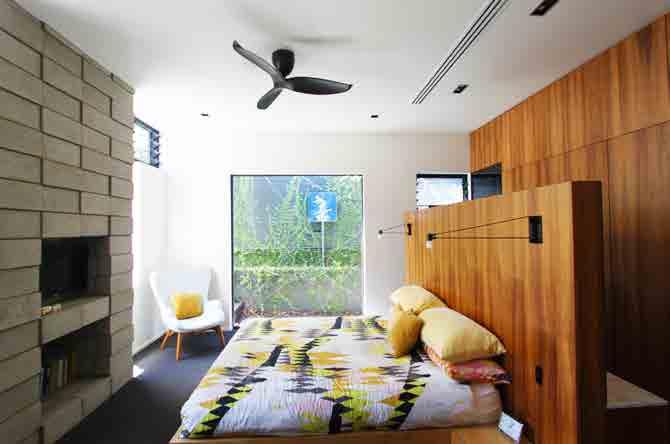
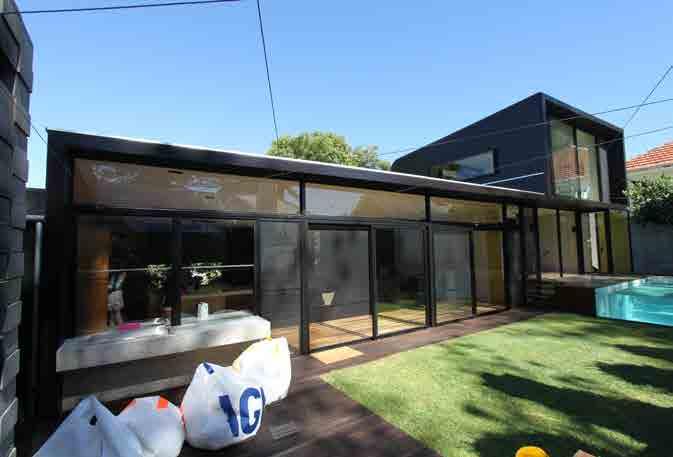
- 30 -
White House by Meaghan White Architects. Image: Deon White.
White House by Meaghan White Architects. Image: Deon White.
- 31 -
White House by Meaghan White Architects. Image: Deon White. •

makeover and extensions including the addition of an office for Meaghan’s busy architectural practice. The result portrays the dynamic realities of a family of two primary school-aged children.
The White House is the architect’s own home, a work in progress between 20102015, a time during which Meaghan and her partner Deon were the ownerbuilders and their children were little. Deon remembers the ‘first inspection of the run down rental was pretty confronting.’ However, they proceeded with a necessarily pragmatic approach, using the simplicity of steel portal frame construction and an efficient deployment of the limited budget. The making of the house became a series of weekend events evidenced by a beautifully crafted dry stone wall, a judicious use of timber, and their mastery over the casting of their concrete kitchen bench tops.
There is something more to the house than is revealed by the initial encounter with the predominant language of colour and material and the presence of obvious collaboration, everydayness and craft. Tacit, lying silent beneath
the vibrancy of individual spaces are the syntheses of layered contemporary lives: people having fun together, yet living different schedules with serious commitments in the same spaces as a growing family. The house appears simple, easy, beautiful and pragmatic.
Meaghan thinks about how families work, considers the implications of her design moves, and prioritises minimising housework! Lots of low profile storage minimises clutter. Lots of glass creates a seamless flow between the generous communal interior and garden eating and living spaces including the pizza oven. Deon has been impressed by how the house works ‘for all the family through the day and the way we like to live and entertain through the seasons making the most of the natural light, cooling breezes and outdoor spaces. We love the beautiful contrast of the old character charm and the contemporary zen of the new spaces. It’s just an amazing house to live in.’
Boundaries are easily made available throughout, with Meaghan’s workspace distinctly separate both spatially and in time. Situated at the rear of the house, her spacious upper level studio oversees
nearby treetops and is accessed via its own laneway entry.
An insulated music room is located between the living room and the stair to the office, while a heavily insulated sliding panel easily separates the living and sleeping zones. During late afternoons Meaghan and the children share the living space for homework: using their devices, being with friends, cooking, playing, all in the same light, airy space.
The cellar, which is accessed only from outside, is definitely an adult space. Once again heavily insulated, this cellar/bar space (clearly lots of fun) is equipped with a spectacular sound system and provides enough space for a small crowd.
Unusual in this era in which traces of human occupation are thought to diminish the perfect performance of a house, this one wears its lived-in-ness well. People, food, books, bags, even dishes and lots of noise add to the house’s warmth. Clearly the architect thinks about and invests in how people live. Her spaces are brought to life with people. •
- 32 -
White House by Meaghan White Architects. Image: Deon White.
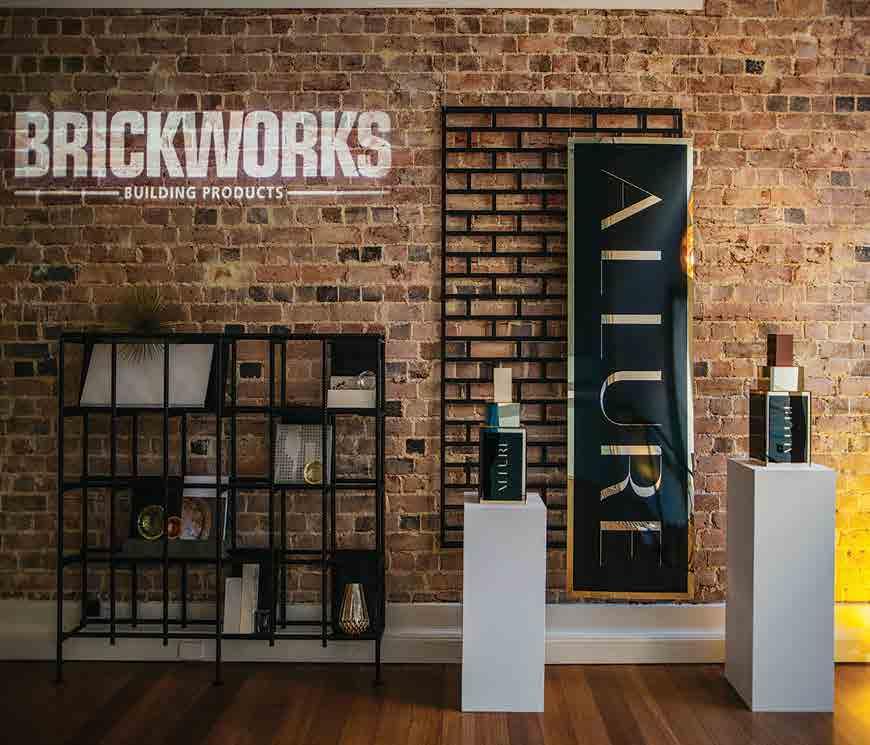
ENDURING STYLE
We are excited to invite you into our stunning Design Studio at 67 King Street, Perth. Here you will find housed an extensive selection of Brickworks building materials including both locally made and those sourced from a little further afield. Our products include bricks, pavers, roof tiles, timber, natural stone, terracotta cladding and precast concrete. So if you are looking for a good dose of inspiration, the Design Studio is a must see.
www.brickworksbuildingproducts.com.au follow brickworks building products on
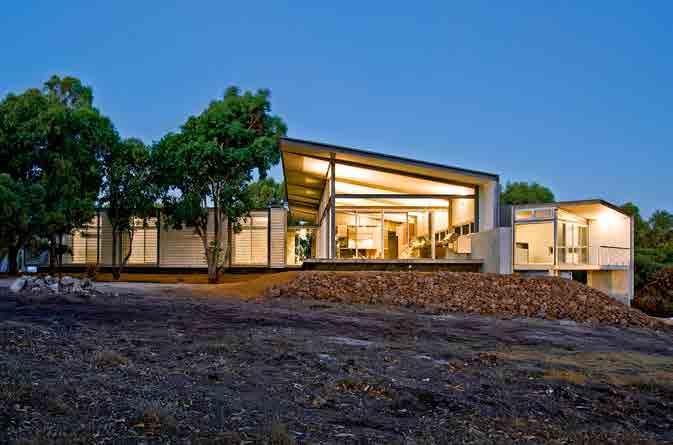
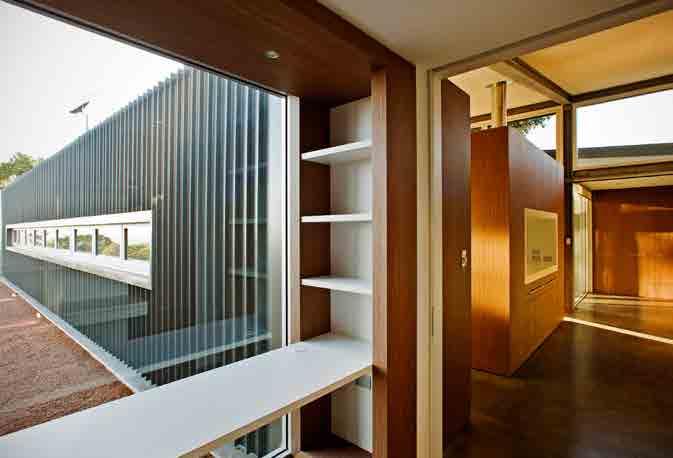
- 34 -
Redgate Beach House by Craig Steere Architects. Image: Lee Griffiths.
Redgate Beach House by Craig Steere Architects. Image: Lee Griffiths.
The clients’ brief was to locate their family holiday retreat on the large Witchcliffe site nestled among natural treed surrounds with views to the ocean and valleys beyond. Our clients used to camp on the site, which overlooks Redgate Beach in a particular position to which they always naturally migrated. Over time they also had built a loose stone fire pit. This location presented as being the ideal position and elevation to site the holiday house.
The Redgate Beach House was designed to respond to the natural qualities of the site and the clients’ desire for a modern, passive-solar home which maximised views to the ocean, whilst also retaining a sense of living ‘within the trees’. In an effort to reduce clearing of existing vegetation on the site and to maintain the visual buffer between the house and a neighbouring limestone quarry, the house is located within a natural clearing, which was also fortunately well elevated above the lower lying land and allowed generous views across the 10 acre site. The site itself is quite exposed and characterised by rocky limestone outcrops interspersed across the sloping site, with dense vegetation to the east, screening the house from nearby Redgate Road, and native trees and coastal scrub immediately surrounding the house.
The position of the trees together with the natural contours of the site informed the concept of a main living spine with two wings branching off to house the main suite, children’s
family retreat
Author Craige Steere Architects
bedrooms and guest wing. The outdoor living and BBQ space was positioned where the original stone fire pit was located.
From the south, there are often strong salt-laden winds (which can be piercingly cold during winter) and limestone dust from the adjoining working lime pit to contend with. Hence, the house design has an inwardfocused cranked linear form, with the profiled steel roof extending down the outer walls to create a protective ‘shoulder’ against the elements, whilst the interior spaces within are more lightweight and open and encourage interaction between inside and outside. Large steel-framed sliding screens extend across the west elevation of the bedroom wing, allowing protection from the sun and wind whilst also allowing the flexibility to access views from the bedrooms and verandah.
The building materials were all selected for their durability and combine to create a simple and industrial palette, which also responds to the colours and textures of the site itself. The profiled steel cladding is an important feature of the building form, achieving a distinctive low-pitched roof form and with custom-made prickle-caps, creating the sharp lines of the folded roof where it extends down the walls to wide easy-clean gutters below. A cantilevered concrete deck maximises the sense of elevation and lightness of the house, and creates a distinct edge between house and landscape.
Functionally, the clients desired an open-plan living, dining and kitchen area which would maximise views and connect strongly with the outdoors via a generous outdoor deck. This living area is a distinct and separate wing which projects outwards from the main building spine. Similarly, the main bedroom suite, which is positioned to gain impressive southwest views, is connected back to the main building form via a link structure which houses the study. The clients were also interested in an energy-efficient house and as such the design has a strong focus on achieving natural lighting with generous glazing to the north; the exposed concrete floor slabs acting as a heat sink. Electronic-controlled highlight windows capture breezes and ceiling fans and a large open fireplace were favoured over artificial airconditioning. An energy-efficient heat pump supplies hot water to the house, and the large concrete rainwater tank works in conjunction with a windmill-pumped bore to provide all the water to the residence.
The clients wished to create a home that provided simple and informal holiday living, that was utilitarian, low maintenance, easy-care and could accommodate family and friends without being a large home. The Redgate Beach House provides an enjoyable retreat for this family from their busy and demanding lifestyle back in the city. •
- 35 -
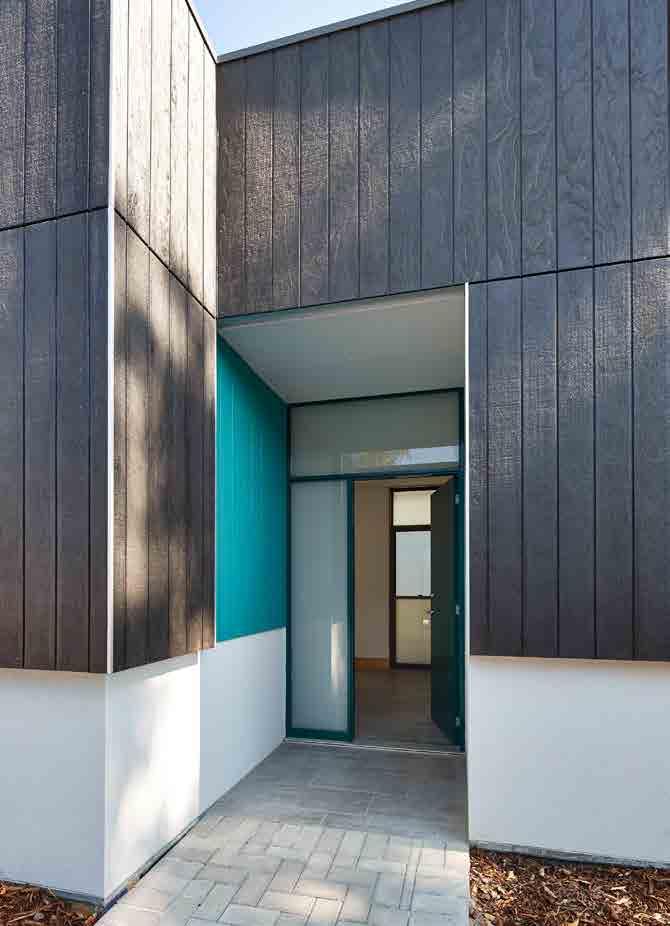
- 36 -
Boonooloo Road Grouped Housing Project by CODA Studio. Image: Peter Bennetts.
boonooloo road grouped housing project / coda studio
Author Reece Currey
Nestled within a quiet cul-de-sac on the outer-suburban fringe of the Darling Scarp is the Boonooloo Road Grouped Housing Project. This recently completed affordable housing project designed by CODA Studio provides a timely example of infill housing which is affordable, flexible, and thoughtful.
The surrounding suburban fabric of Kalamunda hosts a series of by-thenumbers infill developments, built in response to zoning changes in recent years. The Boonooloo Road Grouped Housing Project is easily distinguished from typical cookie-cutter infill developments through its innovative courtyard-based planning and deft use of modest materials to craft spaces in which to dwell and delight. The project makes a strong statement of the potential for well designed and flexible housing which provides an exemplar for future affordable housing developments in WA. CODA Studio has previously undertaken research and practice exploring housing which is responsive, sustainable and meaningful, including built works such as the Building for Diversity project in Northbridge. CODA Studio’s expertise in housing types is clearly evident through the articulation of the courtyard typology in this project. The Boonooloo Road Grouped Housing Project showcases the possibilities for affordable housing guided by clarity of design and a focused architectural response to brief, site and housing type.
The project is composed of four dwellings, each offering slightly different iterations of a courtyard house design. Adjoining units to the north and south sides of the lot are twinned and share many similarities in planning. Connection between the internal courtyard and the living and sleeping spaces is maintained throughout the project, despite the differences in each dwelling’s planning. The consistent material and formal language of the elevations and sensitive internal detailing tie the project together as a whole. A unity of approach to form, material and detailing anchors the project, whilst the four dwellings subtly explore differing approaches to the planning of courtyard housing.
Dark painted timber boards sheath the white textured external walls, constructed of structurally insulated panels. The dark timber cladding provides a framing device which delineates the form along the external parapets and internal street. Interplay between the white external form of the building and the timber cladding defines the external expression of the project. Contrasting in colour, their interaction provides moments of architectonic play most notable at the boundary between the internal street and the courtyards of the southern units; it is here that the lightly-framed timber cladding dances away from the face of the building. Supported by a modest column, this move creates a triangular aperture, the interior of which is painted bright
yellow. The movement marks the threshold - a striking example of how modest materials can be skilfully manipulated to create moments of pure delight.
At the gated entry to the courtyards of each of the southern dwellings, the timber boards traverse to the ground; the lightly-framed cladding separating from the primary form of the building to neatly frame the entry. The two southern courtyards form an expanded threshold between the ‘street’ and internal living spaces. Mediating between the social space of the internal street and sheltered spaces of the interior, the courtyards create a privacy buffer whilst allowing the internal spaces to maintain a strong connection to the exterior. Courtyards located within each dwelling provide north aspect to the attached main living areas, with the courtyards of the twinned units to the south being particularly generous in size. From these courtyards the garages are accessible, containing large rainwater tanks which further enhance the sustainable credentials of the project. Lining the boundary to the courtyards is a bespoke lapped timber fence imbued with charm, which will undoubtedly lead to good neighbourly relations.
Accessed from the courtyard, the brightly painted teal front door of Unit 4 leads into the bright, open main living area. Immediately visible is a high window, allowing soft light from
- 37•
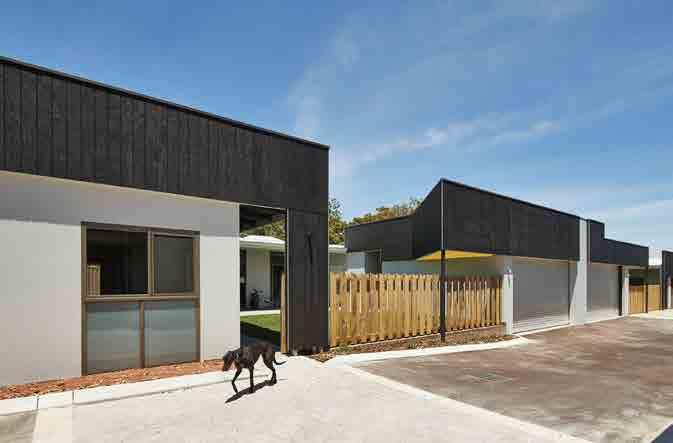

- 38 -
Boonooloo Road Grouped Housing Project by CODA Studio. Image: Peter Bennetts.
Boonooloo Road Grouped Housing Project by CODA Studio. Image: Peter Bennetts.
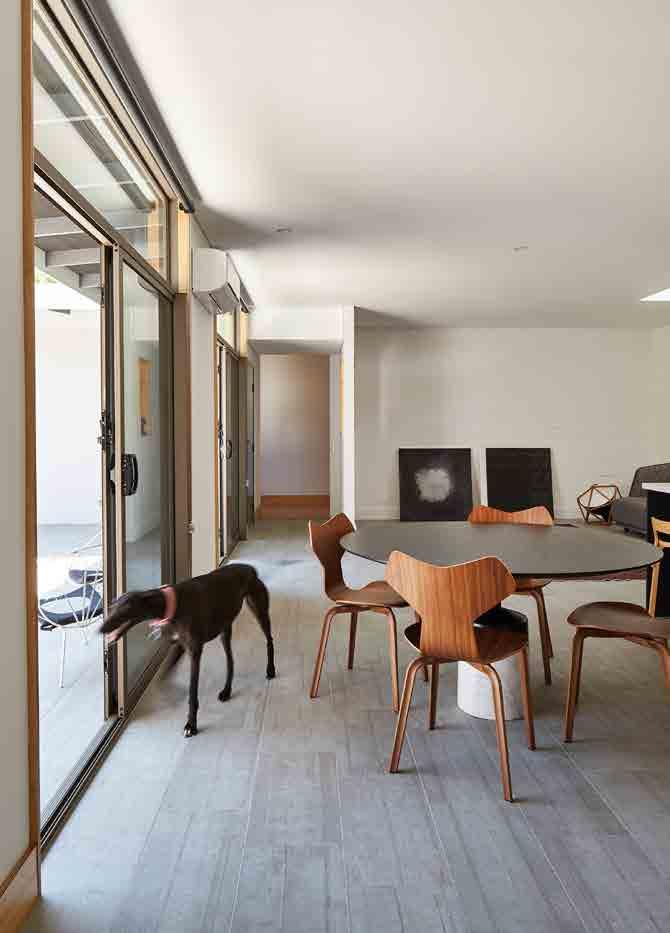
- 39 -
Boonooloo Road Grouped Housing Project by CODA Studio. Image: Peter Bennetts. •

the south to enter as the ceiling is carved away to form a raking bulkhead. Negative details at the junctions of the intersecting planes further define the element creating a crafted, atmospheric moment and establishing a resonant presence within the space. Throughout the project, modest materials and a restrained palette are utilised in a thoughtful manner to enhance the internal spaces through a series of well-crafted details. The white-painted brick of the main living area provides texture to the walls, further augmented by the occasional protruding clinker brick. The interior window reveals are lined with plywood, obscuring the edge of the aluminium window frames and providing a robust yet articulate detail. Plywood skirting boards also provide a clean and resilient edge throughout the home. White paint mutes the natural finish of the skirting in the main living area, harmonising with the painted brick walls.
In each unit the central courtyard forms a pivot around which the spatial planning is generated. The primary living area maintains a
strong connection to the courtyard via floor-to-ceiling glazing, shaded by the overhanging roof. A circulation spine leading to the bedrooms and bathrooms clings to the edge of the courtyard. Within this space, generous glazing ensures ample light, ventilation and visual connection between interior and exterior. Windows along the spine afford views across the courtyard to the playful movement of the yellow triangular aperture of the timber cladding, and on towards the internal street and the main living space. The sense of connection between all of these elements is present throughout, transmitted through the lens of the internal courtyard. Separating the bedrooms and bathrooms from the courtyard, the circulation spines of Units 3 and 4 are generous enough in size to be adaptable to the needs of residents.
CODA Studio’s expertise in developing housing typologies which are innovative and flexible is further evident in the provision of capped-off services in the second living space. By infilling a dividing wall, a four bedroom house converts into a three bedroom dwelling
with an attached 1x1 unit. This inbuilt flexibility allows the housing in the project to respond to various potential living arrangements, with the opportunity for occupancy of the site to be built up over time. Diversification of dwelling types within the project in the future has the potential to further develop spatial relationships, in which the internal courtyard will remain the hinge. From the open, communal spaces of the internal street and courtyards, to the sheltered, restful spaces of the sleeping quarters, the spatial planning within the project creates gradients of privacy, allowing occupants to dwell as they desire throughout the day.
The Boonooloo Road Grouped Housing Project’s thoughtful planning, and modest, yet sensitively articulated spaces are the result of an approach to affordable housing design which is both innovative and articulate. The project constitutes a considered exploration of the courtyard typology and the possibilities for infill housing which is flexible, sustainable and delightful. •
- 40 -
Boonooloo Road Grouped Housing Project by CODA Studio. Image: Peter Bennetts.
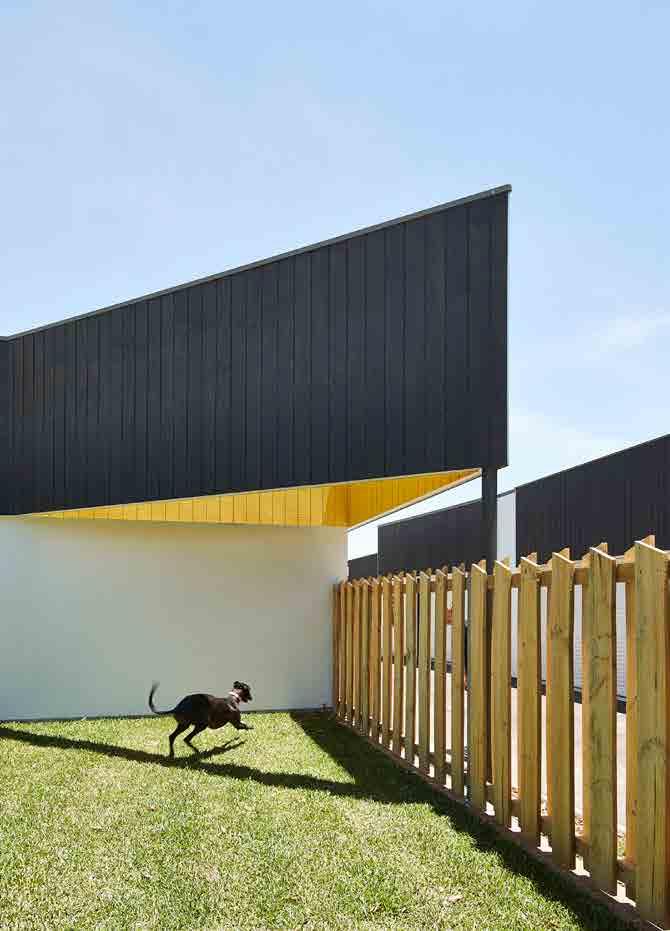
- 41 -
Boonooloo Road Grouped Housing Project by CODA Studio. Image: Peter Bennetts.

- 42 -
Step House by David Barr Architect. Image: Robert Frith.
step house / david barr architect
Author Sarah McGann
The Great Australian Dream has changed. Without meaning to generalise, I don’t know any early GenYers keen to move to the everdistant outer suburbs and mow their quarter acre lawn around the hills hoist. Those I know seem much more interested in resting in close proximity to their work and play than having the 4x2 in the commuter zones. Patterns of leaving home rarely see young GenYers moving further away from the city than their parental home. The inner suburbs surrounding Perth and Fremantle, complete with pop up café amenity strips, are popular targets for this generation of home dwellers. Closer proximity, higher density, smaller dwellings and increased amenity are closely intertwined to achieve better affordability for both owning and renting.
I have been asked to write about the Step House project from the perspective of ‘rest’, though really the project concept and execution fits more comfortably into a Venn-diagram intersection of work, rest and play. The project supports those more interested in lifestyle choices, rather than those keen on commuting, car storage, stuff and cleaning.
On the face of it the David Barr’s Landcorp Gen Y Demonstration House Competition winning entry Step House is surprisingly aptly situated on Hope Street in White Gum Valley. Given
the now long-term call for housing affordability, reduced house size and stronger communities, this project demonstrates a real hope for the future. In light of our huge population growth predictions for Australia, and WA in particular, more projects such as this are needed to address the potential strain on cities, our social connectedness and the fragility of the natural environment.
The Step House, being three separate dwellings within one block, is essentially part-house, part-flat, part-commune(ity), where I imagine borrowing sugar or eggs would be easy due to the friendliness of the visual and permeable connectivity of both private and semi-private spaces. One person bakes and everyone can smell the cookies. When I visited, although not yet occupied by humans (just show-furniture and us), it is obvious how the rough handmade nature of the in-between spaces invite you to pause, converse or just sit outside in the shade after a day’s work. The raw ground materials outside provide a relaxing contrast with the bright white walls of the private spaces. In some ways the tight containment of the outdoor spaces feel reflective of the small-bar trend, where the size-to-friendliness ratio is so important for a cozy atmosphere.
It would be difficult to avoid getting to know your neighbours here. Though not designed for every Gen Y, I would anticipate that when it sells this project
would specifically attract neighbourlyminded people. I hope they also bake.
The permeable boundaries, shared light and through-breeze invite the opportunity for connection rather than promoting territorialism. The treatment of these in-between spaces, both on the ground and in the air, work particularly well in tandem with the light-filled interiors. Borrowed light and long views through the interior spaces and beyond to nature extend the vista and enlarge the sense of space inside these compact little dwellings. The ‘thinness’ of the building envelope is surprisingly delightful; where every little space is so close to a light and view source, and feels completely opposite to so many deep-plan, dark Perth apartments. Though the building is thin, there is a great play against the depth and thickness at the openings. The clever inclusion of hidden storage under the deep window reveals makes the spaces feel protectively deep, and avoids having lumpy storage break up the clean lines of the floor plate.
The affordability-to-size ratio is designed so that new owners are able to buy just what they need, and can afford, right now, rather than contributing to what Tone Wheeler1 has referred to as the great Australian ‘spare-bedroom crisis’ of the outer suburban 4x2. Wheeler has claimed for some years now that Australia does not have a housing crisis at all, just
- 43 -
•
1 Tone Wheeler. 2010. ‘Garden Cities of Tomorrow’ in Prosper or Perish, Griffith Review 29.
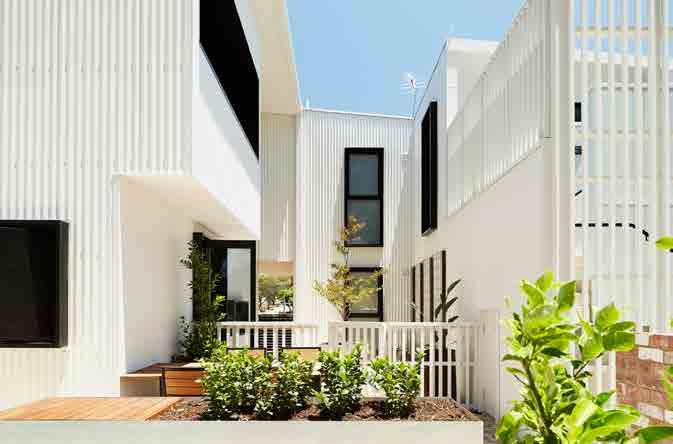

- 44 -
Step House by David Barr Architect. Image: Robert Frith.
Step House by David Barr Architect. Image: Robert Frith.

a surplus of spare bedrooms. Many of these spare bedrooms were either never filled with children, as the birth rate continues to drop, or they are left empty now as the GenYers move inwards to would-be Hope Street. With 50% of dwellings made up of one or two-person households, the project home trend of offering people building choices predominantly made up of 3x2s and 4x3s is supporting the notion that everyone is a property developer: building houses for a perceived resale ‘value’, or for a future buyer, rather than for what people actually need, want or can afford. Here in Hope Street the homes are small, tiny even, but the possibility still exists, as part of the next Step concept, to later convert the carports to a future studio, home office or extra room.
Three years on, the Landcorp GenY Demonstration House Competition still stands up as one of the great collaborative initiatives of recent times in the West. And, importantly, it is an initiative that, with planning and
Council support, could be applied to all the Gens in the alphabet. The other short-listed projects in the competition highlight the diverse talent amongst our emerging architectural leaders and thinkers. The common call for affordability, responsible environmental impact and the creation of new social communities, addresses the full suite of environmental, economic and social sustainability issues. David Barr’s Step House demonstrates the potential of quality over quantity, and his terrific concept of ‘density by stealth’ to new buyers, planners, developers and home-bakers. •
- 45 -
Step House by David Barr Architect. Image: Robert Frith.
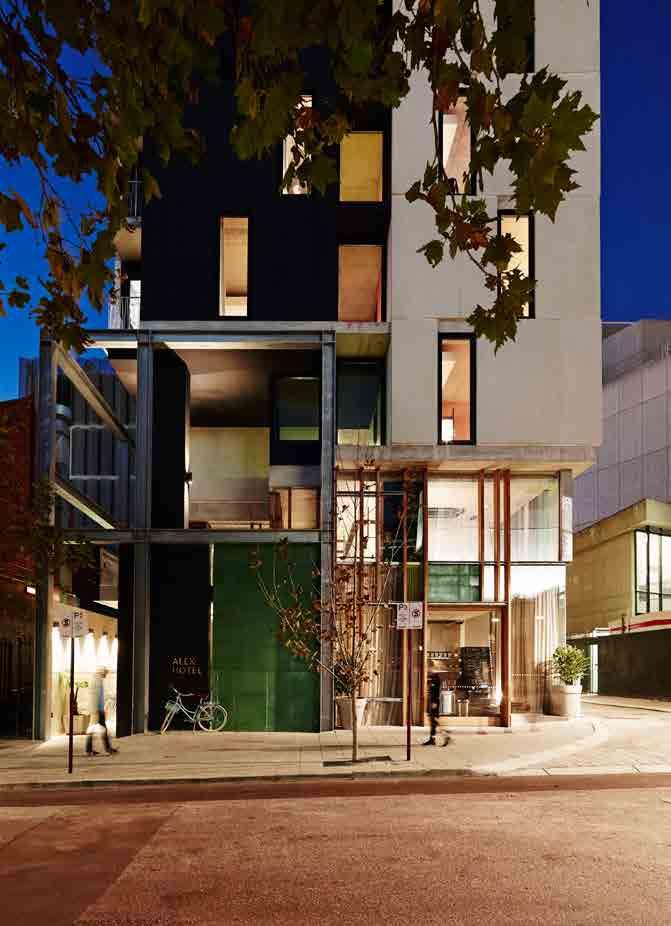
- 46 -
Alex Hotel by spaceagency (architects) and Arent & Pyke (interiors). Image: Anson Smart.
alex hotel / spaceagency
Author Fiona Giles
Is a change as good as a rest?
With the prerequisite of beds, it might be expected that any hotel would embody the idea of rest, but the Alex Hotel is not just any hotel - it draws on work, rest and play. However, in its non-typical approach to hoteliering, rest can be explored as the overriding theme.
Talking to hotel manager Alan Ford, spaceagency architect Michael Patroni and interior designer Sarah-Jane Pyke from Arent & Pyke, the Alex Hotel is of course a place generated by their work. Through operations, architecture and interior design this project has burst into being right at the point where Perth’s respectable City turns into 'wild' Northbridge.
To be enticing, it is usually essential to draw on a strong narrative. By telling a story, the audience's attention can really be captured, which is what the team has managed to do for this project...
...Alex is your uncle, a second cousin once removed, an eccentric, yarn-spinner and traveller. He is the personality created to colour-in this boutique hotel.
The chapters and plot of the surrounding city are selected, mixed and distilled into concrete and steel, resulting in a building that is of its context yet stands unique and proud. Along with the contrasting softer interior it compels the community to intra/inter-act.
The clientele is a mixed bag: mediumflying professionals (architects and designers) coming across for work Monday – Thursday, complemented by locals on the weekends, and throughout the week discerning Swiss and Scandi tourists walk the halls. Each can take a drink from the honour bar and lounge on whichever balcony suits their mood, soaking in the Perth sunshine and atmosphere. The brief's focus was on the curious independent traveller: someone who goes on holiday for the experience, wants to live like a local and have a communal aspect to their home base. The Alex Hotel gives just that: modest bedrooms and generous common spaces with City interactions and friendly staff.
Appearing as two volumes, the building has filled the vacant block and mediates between the 1970s buildings of the Cultural Centre and the heritage Northbridge buildings c1890. The southwestern volume takes the contemporary concrete façade of the neighbouring State Library, pulls it apart and inserts slim windows. Along the laneway at ground level the façade steps back from the boundary and a window is cut to reveal the kitchen, injecting light and life into the alley. On William Street the north-western volume takes the stand: metal screens wrap the façade on three sides, allowing the edges to be blurred and softened whilst still speaking of 'now'. It is also set back from the
heritage shopfront allowing the existing large windows and tiled façade to retain attention at street level. This is the main restaurant entry and importantly it is inaccessible from the hotel lobby, ensuring that guests have to touch the street to get to dinner and so witness the locals in their natural habitat.
The hotel entry is off the main thoroughfare down a newly created alley that gives guests a breather from the bustle of Northbridge. Stepping off James Street guests pass underneath an open steel grid which defines a double height volume for the alley, allowing further mediation between the City and the interior. On entering, guests arrive into the heart of Alex's place and pass behind the hotel desk. This is certainly an atypical approach but it gives the lobby a feeling of welcome informality and has the added benefit of squeezing out a bit more space from the tight floorplate. After climbing the central feature stair (the encouraged route) guests arrive at the guest-only mezzanine floor. High windows flood the space with daylight and bring in the City views. The space is subtly zoned to allow guests to pick the area which most suits their activity: socialising over breakfast at the big table, stand-up space overlooking the city for pensive moments, or retreating behind the bookcase wall into a more private reading zone. It is easy to imagine Alex reading a paper there.
- 47 -
•

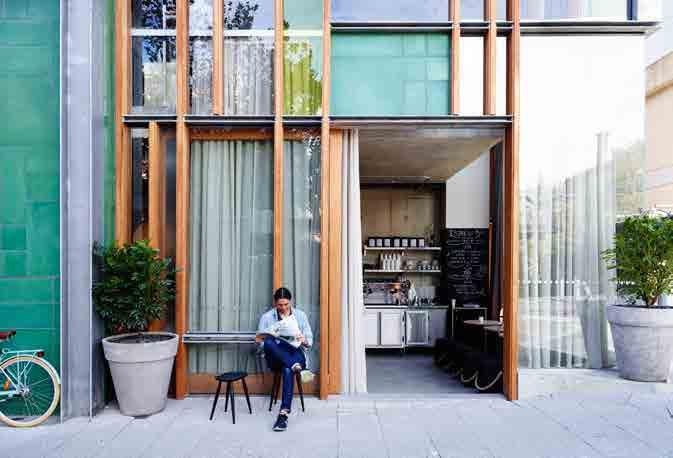
- 48 -
Alex Hotel by spaceagency (architects) and Arent & Pyke (interiors). Image: Anson Smart.
Alex Hotel by spaceagency (architects) and Arent & Pyke (interiors). Image: Anson Smart.
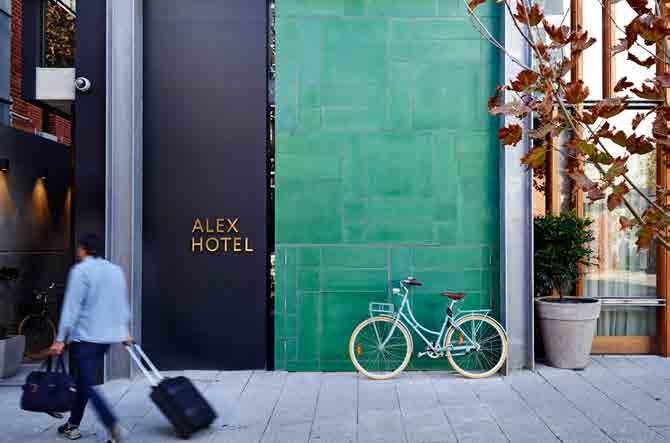
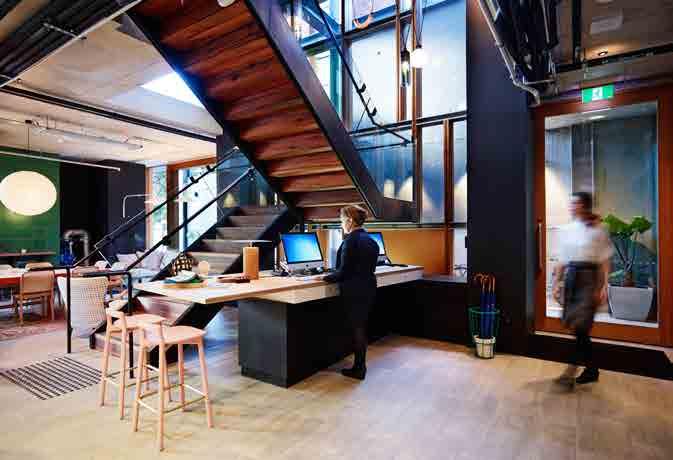
- 49 -
Alex Hotel by spaceagency (architects) and Arent & Pyke (interiors). Image: Anson Smart.
Alex Hotel by spaceagency (architects) and Arent & Pyke (interiors). Image: Anson Smart. •

This hotel is one of sharing and community, exemplified in the honour bar where simply writing down your name allows any number of drinks to be taken out of the fridge. Tribes are also encouraged to emerge through the architecture. For those curious about the city, the James Street balcony allows engagement with this dynamic street and our vibrant city whilst remaining a protected escape. Or perhaps if this is not protected enough, retreat instead to the courtyard-esque balcony beyond the private laneway; bring a nice cup of tea. Despite the open air above and party wall adjacent, it has a more domestic scale with just enough width for one line of sofas and a table for each cluster. This gently forces engagement with others: reaching the end table will require friendly shuffling between conversations and table legs, and this negotiation builds community. Final choice is to be completely fabulous: rooftop balcony, checkerboard floor and a 360 degree view of the City is up for grabs. Well worth it.
Found around the common areas, artefacts are used to describe the character of Alex and make it possible to read his story. Since occupation, the Alex Hotel has enjoyed watching the hotel grow into its own with a bit of wear and tear around the edges, making the place feel properly lived in and more like home. The tired clichés of hipster bars are deftly avoided - no mismatching chairs here. This is a much more grown-up approach with a focus on forming new memories which create legacy, without becoming a museum collection. Even the magazine selection is carefully curated and this attention to detail creates a comfortable feeling of home. Interior design and architecture work together, different ingredients forming a favourite dish.
Finally up to the rooms. The colour scheme varies by floor which is an egalitarian approach: whatever the budget it is possible to insist on a blue room! The bathrooms are pushed to the outer wall and away from the door so on entering the space the volume is
immediately understood. Anticipation is created for the next visit that may technically be to the same room but will feel refreshed with a new colour flavour. Guests are encouraged to enjoy the contrast of anchoredness in the familiar to the spice of variety and nuanced change. However, this hotel is not about staying in bed all day: there is no mini bar – leave your room, talk to people!
The experienced result is one of play: play with the City, with heritage, with textures, with colours, and most of all toying with those intrepid explorers guesting at this home-from-home. The bedrooms are only slightly larger than the one at home so there is comfort but no obligation to stay in it. Instead venture out to the mezzanine where someone interesting might also be a fan of people watching. Work first, play second and after all that - when you return to a more humble abode - the usual routine now feels refreshed and replenished. The adage is brought to life, a change is as good as a rest. •
- 50 -
Alex Hotel by spaceagency (architects) and Arent & Pyke (interiors). Image: Anson Smart.

- 51 -
Alex Hotel by spaceagency (architects) and Arent & Pyke (interiors). Image: Anson Smart.
the value of the sabbatical
Author Kelwin Wong
Every seven years, designer Stefan Sagmeister closes his New York Studio for a year-long sabbatical in a move that allows the studio to rejuvenate and explore new ways of thinking creatively. In his TED Talk, he explains the value of overlooked time off.
Sagmeister is a designer and art director from Austria who currently lives and works in New York City. He has worked for the Rolling Stones, Talking Heads, Lou Reed, and the Guggenheim Museum, among others. Combining his two loves of music and design, he runs a design studio out of New York. What he found was, like many things in his life that he loves, he adapted to it and over time became predictable in his design process. Comparing examples of his design work for different clients which both featured a product nestled within a die cut book, he decided then that he would close his studio down for a year’s sabbatical.
Sagmeister presents a tantalising idea: ‘…we spend about the first 25 years of our lives learning, then there is another 40 years that's really reserved for working. And then tacked on at the end of it are about 15 years for retirement. And I thought it might be helpful to basically cut off five of those retirement years and intersperse them in between those working years.’
He highlights how ideas and the work that arises out of these ‘early retirement slices’ flow back into the company and into society at large, rather than just
benefitting a grandchild or two. He further breaks down work into three different levels: work for money, work as a hobby, and finally work as a calling. In the third level, this would be work undertaken irrespective of any financial compensation.
Initially taking a free-structured sabbatical, Sagmeister settled on scheduling his days out, making a list of things he was interested in and dividing them into chunks of time. Allocating his time daily against items such as ‘story writing’ or ‘future thinking’ allowed him to focus and reconnect with creative thinking again. Removing financial compensations allowed him to explore ideas and techniques without limitations of project timelines or client expectations. It was acceptable to try and even fail at something. Sagmeister describes the sabbaticals, over the long term, as financially successful. Because of the improved quality in his work, he is able to ask for higher prices.
A second insight he gained from the time off was the realisation of how he had mostly been involved or used the language of design for promotional purposes. It was always to sell a product or articulate a client’s message. He explored the use of this language as a vehicle for self-expression instead. From this, he developed a whole series of work entitled ‘Things I've Learned in My Life So Far’, a collection of personal maxims that have appeared all over the world in spaces usually reserved and occupied by advertisements and promotions. The
series reveal themselves as an intriguing blend of personal insight, art and design – an eclectic mix of visual controversy and reasonable advice.
Mid-career sabbaticals are far from an isolated practice. According to OneWay, a UK-based rail and construction recruitment agency, there is a growing number of professionals opting for a gap year. Even companies such as Adobe, Autodesk and Google allow their employees time off to pursue personal projects to encourage lateral thinking and innovation. In return, employees return to the workforce recharged and with a broader skill set than when they left. Other professionals see unexpected results forging a new career path.
Winston Chen, a software engineer inspired by Sagmesiter’s TED Talk, left his job at a software company in Boston and moved his family to the Norwegian island of Rødøy, population 108, for a year. While his year off was more loosely planned that Sagmeister’s, the objective was the same: to rejuvenate his creativity. Three months into his island year, he rediscovered an old passion for programming. He developed a simple app that would read web articles or PDF files out loud using synthesised speech. What started as an app just ‘for fun’ is now a top 10 selling education app distributed in 86 countries and the precursor to the voice-based mobile app company Voice Dream.
Even within the architecture industry it is common for architectural students
- 52 -
to take a gap year between finishing their Bachelor of Applied Science and embarking on further education in architecture. Sometimes their gap year would be working for experience or raising money for their course fees. Other times the year would be to travel overseas, now having an articulated appreciation for the built environment. The ability to immerse oneself completely in a culture which provides a deeper social context as one visits buildings is something a book or blog can never really capture.
Gwynn Zivic, an architect from Mackey Mitchell Architects, writes of such an experience when she took time off work mid-career to join an artist residency program in Sicily in the summer of 2016. In her blog entry she describes how her work process has morphed and developed as a result of her time in solitude in a remote coastal town. Initially interested in sketching Sicilian building details and the surrounding landscapes as part of her residency, she found creative freedom instead in pure abstract and impressionistic interpretations inspired by forms and colours of the landscape. While she completed her residency with 12 finished pieces of art, the process overall fed back into a stronger foundation in authentic architectural styles, proportions and details that guide her work on university campuses.
Taking a break from work is not necessarily about going away to start a business or new career, however. Rather
it is about providing the clarity and allowing oneself the space to ask the question ‘what would I do for a while if I did not have to think about money?’ Where that takes you is the adventure in itself.
References
Sagmeister, Stefan. 2009. ‘The Power Of Time Off’. http://www.ted.com. Accessed 03 March 2017.
Chen, Winston and Emily McManus. 2014. ‘Leave Work For A Year To Go Live On A Remote Island? How A TED Talk Inspired Me To Take A Mid-Career Sabbatical’. http://blog.ted.com. Accessed 03 March 2017.
Garone, Elizabeth. 2016. ‘The Surprising Benefits Of A Mid-Career Break’. http:// www.bbc.com. Accessed 03 March 2017.
Zivic, Gwynn. 2017. ‘Sabbatical In Sicily’. Mackey Mitchell Architects. http://www. mackeymitchell.com. Accessed 03 March 2017. •
...
- 53 -
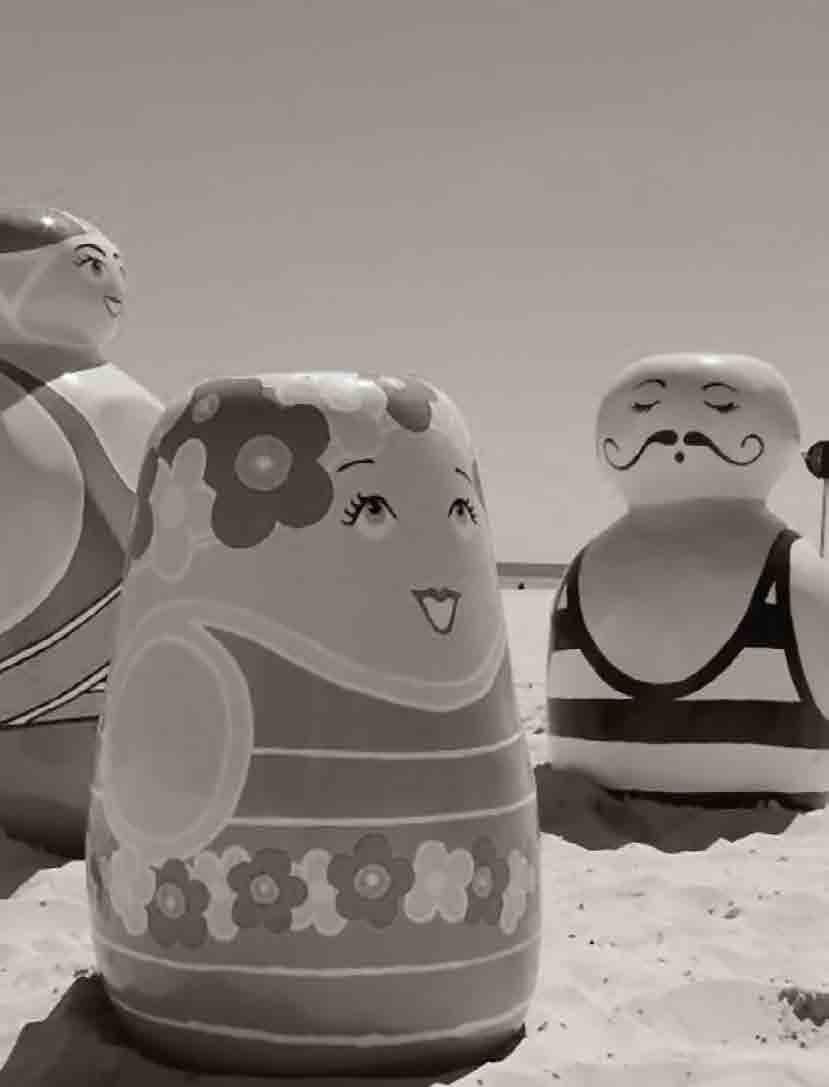
- 55 --play
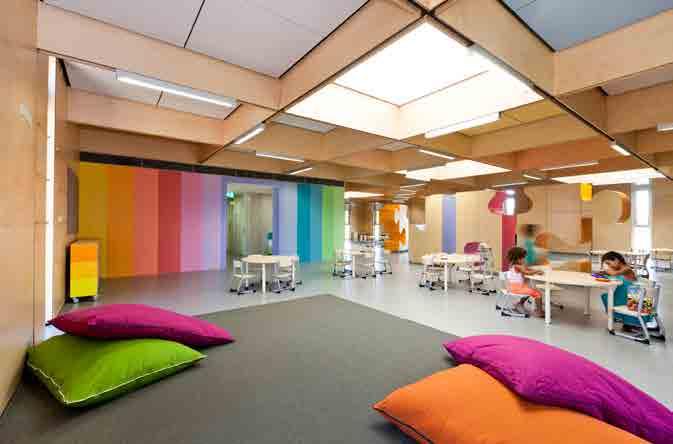

- 56 -
John Septimus Roe Anglican Community School Kindergarten by Brooking Design. Image: Heather Robbins.
John Septimus Roe Anglican Community School Kindergarten by Brooking Design. Image: Heather Robbins.
JSRACS kindergarten / brooking design
Author Hayley Curnow
Central to any pre-schooler’s daily agenda is the premise of play.
Brooking Design’s approach to John Septimus Roe Anglican Community School’s Kindergarten employs ecologically sustainable design principles, materials and finishes to deliver a nurturing learning environment conceived on the understanding that ‘play is about creating your own space.’ Completed in December 2012, the building forms a significant landmark structure at JSRACS Beechboro campus, while reframing the kindergarten typology.
Constructed within a tight budget of $2,600/m2, the building is a feat of timber construction and engineering. The gang-nail truss roof and structural laminated veneer lumber framed walls are set out on a 2400mm grid to form the primary structure of the building, founded on a raft concrete slab. Double-stud walls forming an insulated cavity and a Kingspan roof provide a solid exterior shell that delivers a fully air-sealed, highly controllable interior environment that is innately quiet and cool. The construction methodology allowed for pre-fabrication and efficient construction, while the use of highquality, sustainable and energy-efficient materials at a relatively low cost per m2 addressed the brief in relation to eco and budget requirements.
Brooking Design’s structural approach has resulted in a simple, rectilinear floor plate of 300m2 that comprises a compact services core of staff and student amenities and a generously scaled learning space with a free,
flexible layout. Loosely divided into three teaching areas, the kindergarten accommodates 60 students with shared facilities.
The building shell is sheathed in warm, birch eco plywood, imparting a soft, non-institutional sense of tactility. Narrow, double-glazed strip windows punctuate the plywood lining and incorporate an operable high-light and central casement window to invite natural breezes into the space. Student interaction is facilitated between the interior and exterior play areas via an intimately-scaled glazing panel at low level; remnant finger-prints on-site suggest that peeping through to see friends is a popular activity.
Simple, eco plywood lining is maintained on the structural roof members to form a bold coffered ceiling grid that is interspersed with coloured acoustic panels and thermally rated skylights. An abundance of natural light is tempered through these openings, with low energy strip lighting offering additional light. The eco-ply facings are meticulously detailed to express the structural framework beneath, requiring a level of craftsmanship between the trades of roof builder and cabinetmaker.
The warm timber, combined with the acoustic vinyl floors and walls in shades of grey and beige, form a resilient and neutral base palette that gives presence to the children’s artwork, toys and learning materials. Vibrancy is applied to the interior with thoughtful restraint. Bold bands of carefully selected colour enliven the walls enclosing the services core, creating a bright and
spirited aesthetic, without being overstimulating.
The over-scaled mobile puzzle pieces that occupy the interior volume spark the children’s imagination by generating a playful landscape for climbing, resting, hiding and playing. Thoughtfully designed to be stable, self-supporting, robust and practical, the pieces can be used as room dividers and also provide ample storage within. These pieces are beautifully detailed, with a panelised plywood finish to the front and back faces, and bursts of coloured laminate to the returns, tying in with the colourbanded wall. Similarly, additional joinery items, housing books, toys and learning materials, are on castors to enable reconfiguration of the space, empowering users to define where they work, learn and play.
Articulated with clarity and rigour, the inherent flexibility of JSRACS Kindergarten liberates young students in an environment that is devoid of institutional rhetoric. Stepping through the volcanoes, carefully-laid picnic settings and towers of building blocks that have animated the expansive interior on this particular day, it is evident that this kindergarten instills in its users a sense of ownership, comfort and wonder. Brooking Design have not only delivered an ecologically sustainable and budgetfriendly kindergarten model, but have demonstrated that, through a true understanding of the user, kindergartens can present a rich platform for play and engagement. •
- 57 -
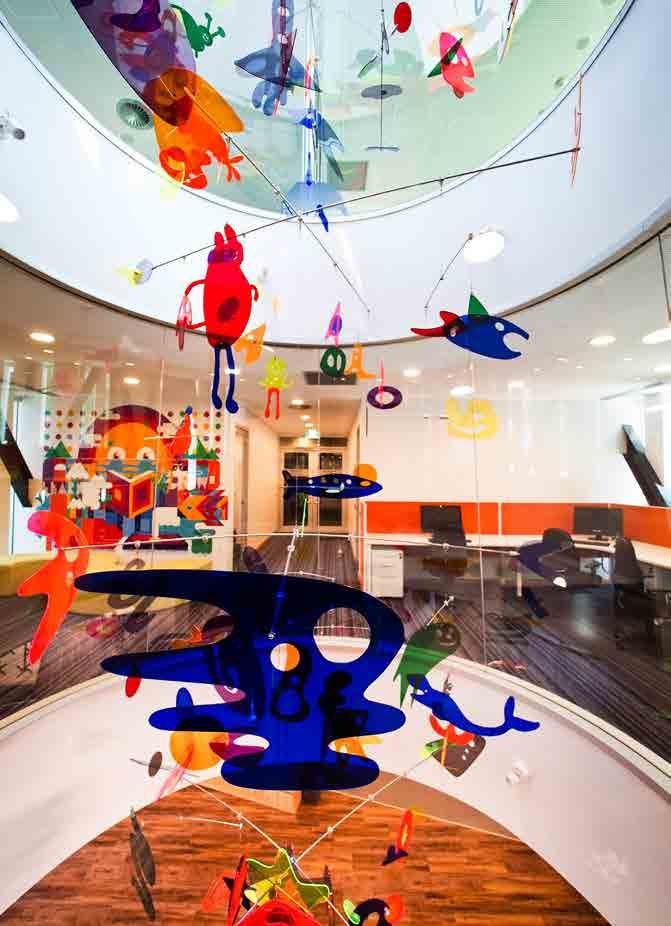
- 58 ---
Ronald McDonald House by Gerry Kho Architects. Image: Gerry Kho Architects.
a playground away from home
An interview with Gerry Kho
Gerry Kho Architects discuss the new Ronald McDonald House in Nedlands and how they sought to provide a ‘home away for home’ for the families of seriously ill children and facilitate the formation of supportive relationships and a spirited community.
Initially, what attracted you to take on this project?
We were invited to tender on the project in 2011 and we enthusiastically jumped onto it because we were drawn to the project’s potential. It ticked all the boxes when it came to a single project that had everything we were passionate about: a community-based project that would make a difference to the lives of individuals and families, that was fun, had elements of play, and that contributed to the well-being of human beings in a very direct way. Plus it gave us a chance to experiment with our design principles that were focused on creating experiential and social spaces within a complex brief.
What we didn’t expect though were the politics and large number of hurdles to get this project from the beginning to the end. Also unexpected was the opportunity that we had to meet and interact with a number of high profile industrialists, corporations, industry leaders, public figures, prolific local artists and other individuals; not only those who contributed financially or physically to the project, but also those who had sincere interests and a passion for the project and who we normally wouldn’t have the honor of meeting or speaking to otherwise. One memorable occurrence was walking around the construction site with Adam Gilchrist
as I explained the design and answered very relevant architectural questions when the two of us had wandered off together from the rest of the group during one of the media events on site. It was great to listen to and see his genuine interest in the actual construction and outcome of the project as well as architecture in general.
How did you approach the design?
The project was driven by the direction that we wanted to take: that this new Ronald McDonald House was not only an opportunity to provide accommodation for patients and families in a difficult period in their lives, but also an opportunity to improve on the current model for housing facilities of this kind. Improvements were not only limited to the physical structure, spatial programming, technology and environmental sustainability, but also included the social and human aspect of Ronald McDonald House to work towards the idea of a Ronald McDonald Home, ie ‘a home away from home’.
The underlying concept of ‘connection’ focused on creating social hubs that offer opportunities for chance meetings; to encourage users to interact, to share, to relate, to heal and to form a community, a support system. Our design intent was to provide a place
of comfort and convenience and to promote compassion amongst the occupants, not just within the immediate affected family but also between families.
How did you seek to introduce playfulness and delight into this project?
A journey of exploration exists throughout the building. This journey begins with the path towards the main entry, informed by the fluidity of a canopy leading to a ‘secret garden’. This meandering distracts the traveler from their anxiety; to prepare and to create a sense of curiosity, play and exploration. This intimate approach reassures the ‘explorer’ that this is not another medical building, which these families reluctantly frequent. The main feature in the social spaces from levels one to four is the light shaft that sits in the linking bridge building. The circular shaft adds drama as well as highlighting the communal spaces on each level and visually connects all four levels vertically. This gives us a sense of connectivity throughout the building. And of course, this feature also provides natural light to all levels in a spectacular way.
The elements of surprise and hidden gems exist on each level with different types of social spaces and features; elements unexpected in
- 59 -
•
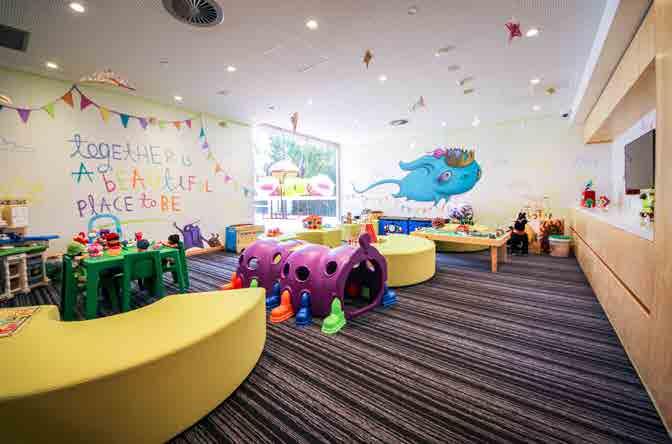

- 60 -
Ronald McDonald House by Gerry Kho Architects. Image: Gerry Kho Architects.
Ronald McDonald House by Gerry Kho Architects. Image: Gerry Kho Architects.
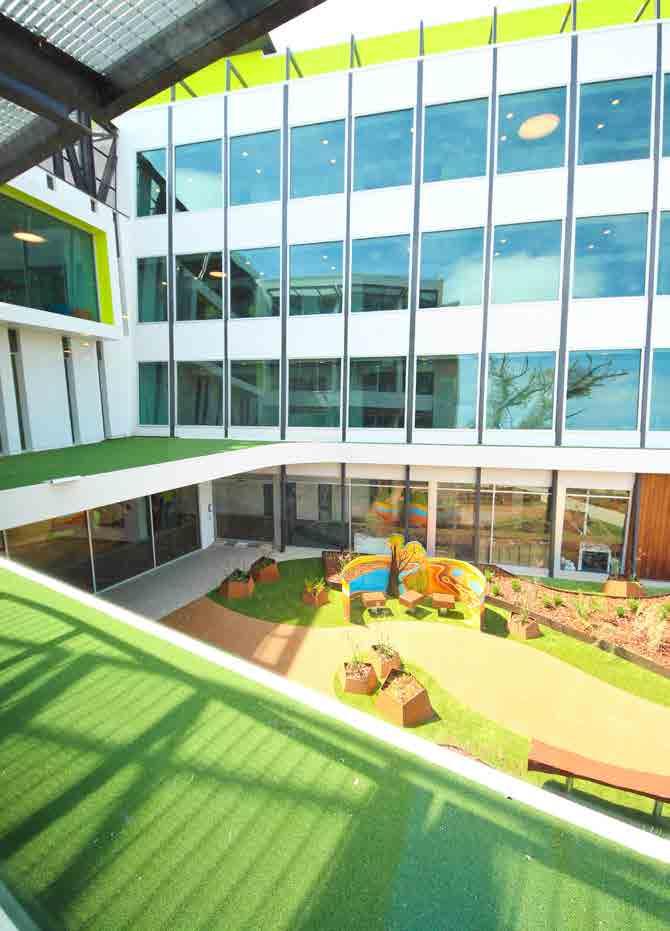
- 61 -
Ronald McDonald House by Gerry Kho Architects. Image: Gerry Kho Architects.
•
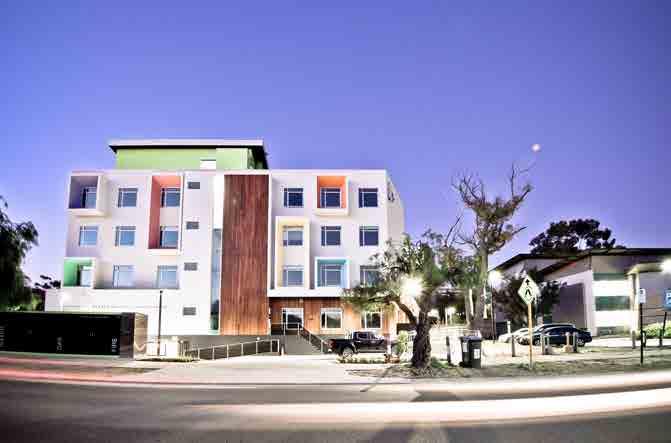
accommodation such as this. More and more is revealed the longer you stay and explore. The entire building is one big playground for both the children and their parents. There was potential for the house to become very kitsch and very Disneyland, which probably occurs quite often for this kind of project; hence our approach to the building form and materials, textures and colours were carefully selected to be playful both visually and in a tactile sense for children and adults, without being sickeningly garish. As part of the biophilic design, we selected finishes, textures and materials that remind us of nature; hence our extensive use of timber, stone and a natural palette of materials.
How have the families and children reacted to the project and what are their favourite spaces?
So far the reactions have been terrific and better than expected, especially towards a design that is unusual for a Ronald McDonald House. The large
cascades and blades of rich cedar timber cladding on the exterior have made a positive impression on the public. Internally, the pièce de résistance for the families is the light shaft, which has become the talking point of the building, as intended. We’ve heard that the families are using the spaces well, and best of all they are interacting with each other! This is in complete contrast to the old facility where everyone stayed in their rooms. This meant that our little experiment was a success!
What did you learn coming out from this project and how do you envisage taking this through to future projects?
The initial brief was for the building to utilise the most progressive, creative and sustainable design and construction methods available. The result was one that went beyond expectations of what could be achieved and we believe it to be a considerable improvement on current models for this typology in terms of architectural language, built form and experiential spaces. Most importantly,
we’ve created an environment that is conducive to the formation of relationships and a community.
This project gave us the opportunity to put into practice our architectural theories and principles on a grand scale. What our team learned coming out of the success of this project was the level of skill, talent, rigor and commitment each of us had - driven by a shared passion.
In terms of the future, Gerry Kho Architects will continue to experiment and to create experiential architecture with the confidence that we already have this very public prototype successfully up and running. •
- 62 -
Ronald McDonald House by Gerry Kho Architects. Image: Gerry Kho Architects.

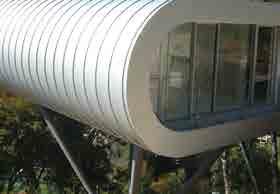

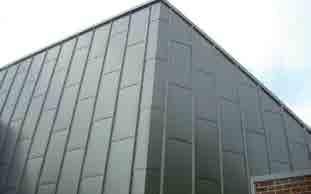
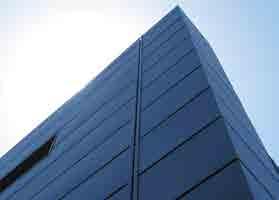
- 63 -
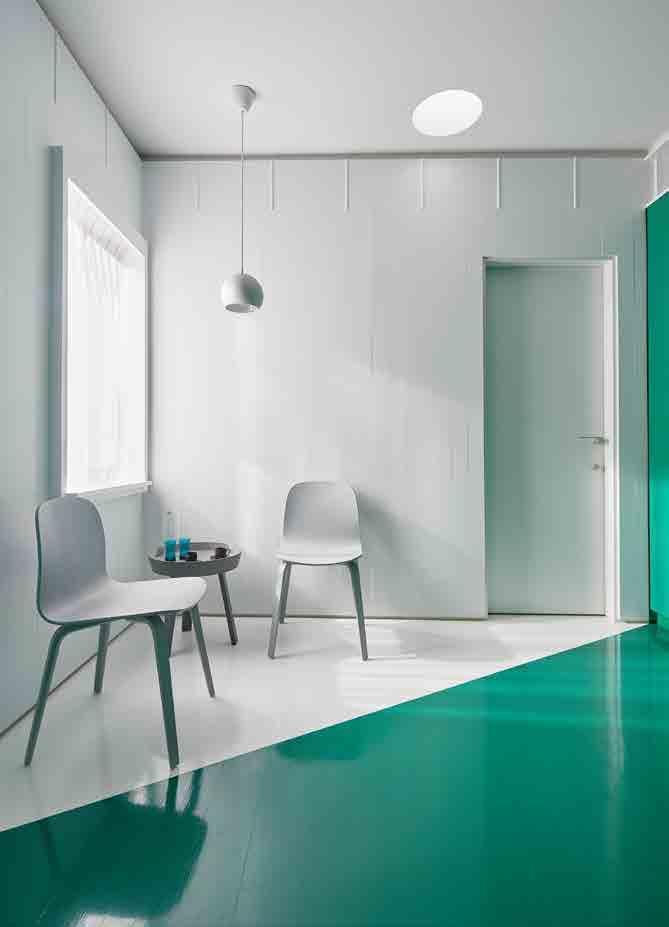
- 64 ---
North Perth Apartment by Simon Pendal Architect. Image: Robert Frith.
north perth apartment / simon pendal architect
Author Dr Beth George
Beth George reviewed the reimagined two storey town house and discusses the project and the theme of 'play' with the owner.
Relating a residence designed by Simon Pendal to the subject of play? Well. Simon’s work is not on my list of playful architecture. He doesn’t do it like others do – a point myself and his client agree on. Both within Pendal and Neille and in practice alone, the pursuit of a way of thinking about architecture, and of a method for making it real, is rarely so rigorous or persistent. Nothing will remain in Simon’s projects that has not survived critical measurement against the idea, drawing and re-drawing, and large scale testing through models.
But, as for the existence of the other definition of play – as in theatre: of set, scene, control, atmosphere, the staging of events, the revealing and intensifying of things – here the word makes sense.
Standing in the courtyard, beside a chain of hearts tree, we face the original house, where extraneous pieces have been stripped away and an entry to the courtyard remade. Upstairs, wet areas were tightened up, making for three roomier spaces: a sitting room and two bedrooms with neat ensuites and a dressing room.
There is much in the existing house that might have been swiftly replaced, but such expensive acts were not on the agenda. It is the maintenance of
original parts and their careful shifting and rephrasing that makes this project canny and delightful. An aluminiumframed window to the kitchen was dealt with through the addition of a timber reveal, concealing the flimsy frame and adding depth to the window itself. The staircase, similarly, was unaltered in structure but wrapped. Its open stringers and balustrade are now concealed by solid planes. An original turned timber baluster at the base of the stair now is revealed on its inner face, with a slender new steel handrail sweeping around it. In this way, two forms of detail, belonging to the two disparate eras of the house’s making, are bound up together.
The kitchen is divided into two entities: one intense green and the other white. The line between them runs obliquely across the floor, creating two rooms within one: a white sitting space and green kitchen-proper. The green wraps from the floor plane, up the cabinets and onto the wall units, collecting all of these surfaces together and making them read as a singular form. That edited window sits in the white part; white wall, white reveals, white curtain. Without daylight they are contiguous, and with it the window is diffusely illuminated.
Upstairs, Simon’s intrigue with chiaroscuro painting finds form through stark contrasts of light and dark. A favourite moment of mine is where a black recessed niche extrudes backward from a white wall plane. Black paint traces the junction of two perpendicular walls and carefully denotes the face of a cornice that was truncated to form the profile of the white front-piece.
Something like a game happens in the upstairs robe, where a skylight was inserted, extending as a tubular void from roof to ceiling plane. Corresponding with it on the black wall surface is a region of white paint – an oblique shape – such that the tube of light might have blanched the wall by landing on it.
Such transitions between bright and dark follow you through the space, from threshold to room, into anterior spaces. Simon describes this contrast as less about curating light and dark space and more as creating a condition within which to make luminous moments, and to throw certain things into focus. From above, the stair appears as a white cut-out from a dark field. A colour change was apparent on the ascent but is far more intense to experience on the way down: the colour changes perfectly along the datum of the finished first floor level from deep Prussian blue on the floorboards and first floor walls to
- 65 -
•
white on the stair. The datum is traced along the balustrade and handrail precisely, as though all the stair components had been lowered into a pool of paint, filled perfectly up to floor level. This gives the effect of immersing oneself in the stair. You almost feel like your body is breaking a surface tension constructed here as you dip your toe toward the first tread.
It is an extraordinary house; one that relies as much on the careful manipulation of paint and thin surfaces as it does on deep spatial progression. The chiaroscuro interplay of planes and objects resonates with that Perthian sensation of closing your eyes after being in stark sunlight, reluctant to take a step until your eyes adjust.
I asked the owner Jane (JW) about the process of appointing Simon Pendal:
JW: I knew that I couldn’t live in the house the way that it was. So I started to look for an architect… eventually we found the house that Pendal and Neille had done in Claremont in a magazine. They weren’t like all the others!
BG: I don’t think their work is like others’ either. I think it’s very careful, nuanced, but not overwrought and not ostentatious. I think they sit between two camps - between romance and modesty.
JW: I saw Simon as having a portfolio made of similar but different things. I gathered the Claremont house wasn’t the grandest house to start with, and to have taken the Carine one, which was a project home, and turned that into something that was really interesting… I was impressed by their using something as simple as paint to change a place.
Jane gave a fantastic description of the requisite trust that comes with working with an architect:
JW: I think Simon probably sits in the same place as my hairdresser – I have no say in that either! [We both laughed knowingly at this]. I mean, I’m good at sums! That’s what he’s good at… I’m not sure it would work if you were telling them what to do... I just think it would never have looked like this if I had been swaying the decisions.
She also really enjoyed the process of the build:
JW: We’d come and have a peek and say ‘Oh! Look at that!’ … it’s kind of addictive.
BG: The theme here is play. I wondered if you could perceive ‘play’ – in the sense of theatre and the staging of scenes –where the manipulation of light is key and models are made to test it?
JW: Yes and the models are very much like little stage sets.
BG: Do you get a sense of that control?
JW: If you think about the kitchen it is very much like a set. And it changes colour at different times of the day.
And it turns out the place is playful after all:
JW: I think the other thing about play is that it is a nice playhouse! In the summer you can open the doors up and pull the curtain back, and now the dining area and the courtyard and those spaces really come together. The black painting in the courtyard – running down the side of the kitchen and into the court – it’s all painted black; even the jarrah is stained black. You have the feeling of being in a continuous space where no one is far away from anyone else. •
- 66 -
...

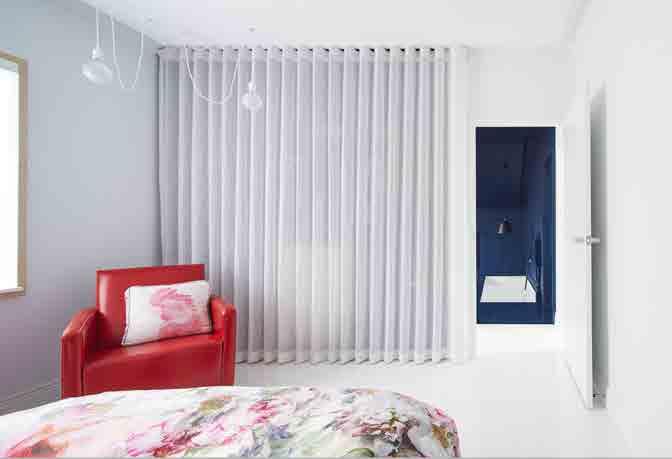
- 67 -
North Perth Apartment by Simon Pendal Architect. Image: Robert Frith.
North Perth Apartment by Simon Pendal Architect. Image: Robert Frith.
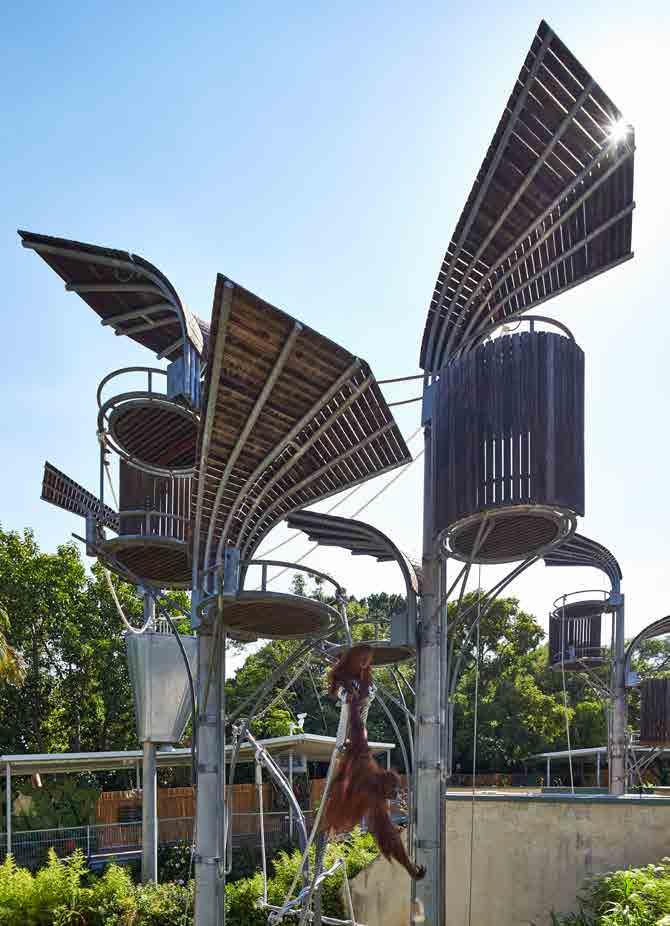
- 68 -
Perth Zoological Gardens Orangutan Enclosure by iredale pedersen hook. Image: Peter Bennetts.
jungle gym
An interview with Finn Pedersen
iredale pedersen hook architects explains the role of architecture in improving the built environment for our simian relative, the orangutan.
A commission for an orangutan enclosure is not an everyday experience for an architecture firm. How did you go about gaining an understanding of the requirements for such a project?
We worked closely with the Perth Zoo Life Science staff and keepers who attend to the needs of the orangutans to understand their lifestyle, culture and living patterns from young baby to adult orangutan. We looked at the designs of exhibits around the world and discussed their good points and shortcomings and then brainstormed with the Perth Zoo staff to develop the key ideas for their new habitat.
It is critical to these projects to integrate client experts into the design team.
What were the gaps in the original 1970s enclosure design, and how was this evaluated and addressed?
The original enclosures were from face brickwork and contained a 4.5m high x 1.5m grid frame made from 75mm diameter galvanised pipe. Originally the enclosures were topped with planters, providing cascading
vegetation to screen the walls of each enclosure. Over the years the waterproofing of these planters failed and the plants were removed. The result was a very hot exhibit that was unsightly. Also, as knowledge of housing orangutans developed over the years, an understanding of the need to provide arboreal space and more climbing and nesting opportunities came to the forefront, which the new exhibit was to provide for the animals.
An important aspect of designing enclosure spaces for orangutans is stimulation. How does the enclosure design respond to the need for ongoing flexibility to adapt their habitat environment for stimulation?
The exhibit furniture provides arboreal movement opportunities: climbing, swinging from vines (ropes), 6m high ‘sway poles’ and branches that move, platforms to support the building of nests, places where the animals can drink from in the 12m high ‘trees’ (nesting poles), stimulating puzzle boxes, and dip tubes that provide the animals the opportunity to learn tool making to obtain food. The exhibit layout can be tuned to suit the
development of an individual animal from birth to release by supporting their changing body size, strength and dexterity.
Orangutan mothers are very good at teaching their young the skills they need to thrive in the jungle and the exhibit furniture assists them in this process.
A final off-display ‘pre-release’ exhibit contains a mature ficus tree that the release candidate and their mother are allowed to access for a time to apply these skills to a real tree.
There are a number of furniture elements used to inspire play. Could you describe the prototype process designing these elements?
Play and learning are difficult to separate when discussing this project. There may be a danger of assuming that orangutans ‘play’ in the same manner as humans do, however I think the keepers would agree orangutans do play in ways that are familiar to humans, and in fact will play with humans. The whole exhibit apparatus is like a huge ‘jungle gym’ and when
- 69 -
•
you watch a young orangutan move through and explore all of the elements in the space it is a joyous experience.
Elements that have a functional purpose, such as the high level drinkers, are used to squirt water at other orangutans and sometimes people, as well as encouraging arboreal habits. The dip tubes and puzzle boxes encourage tool use. Loose behavioural devices, such as hessian bags, branches, palm fronds, rubber car tyres, balls and frozen treats, augment the fixed elements. Even the functional elements such as the timber shade structures are used as a treetop sun lounge where the colony members observe the world around them.
What have been the observable outcomes of the project for the client and orangutans?
In 2002 the first exhibit was prototyped and a ‘crash test’ orangutan was studied for a six week period to establish a base line mental and physical assessment. The same season the following year, after being in the exhibit for some six months, the assessment was repeated and the animal’s behavioural indicators had all improved dramatically.
The keepers also took detailed notes on how the exhibit worked and the design was altered in response to their observations, removing the density of the smaller ‘sway poles’ and changing some small details.
Over the next 12 years the other exhibit spaces were upgraded and the last animal to get a new home was Hsing Hsing, the dominant male of the colony. He has Type 2 Diabetes and has daily blood insulin level tests. After a few weeks in the exhibit he lost weight, his insulin levels improved and he became much more active, perhaps the final proof that the new habitats were effective.
Subsequently there have been five babies born in the colony and three orangutans released into Sumatra. •
- 70 -

- 71 -
Perth Zoological Gardens Orangutan Enclosure by iredale pedersen hook. Image: Peter Bennetts.
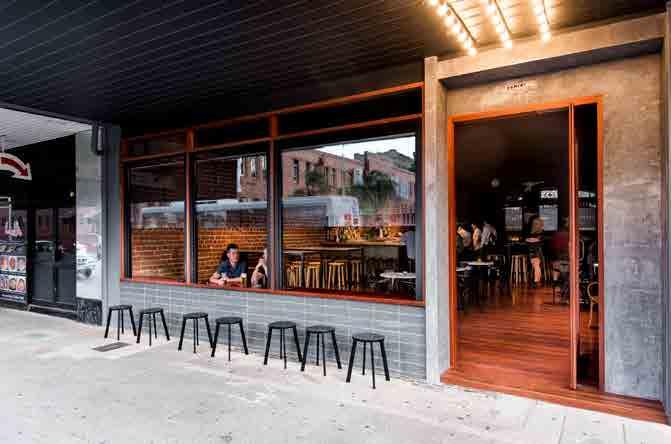
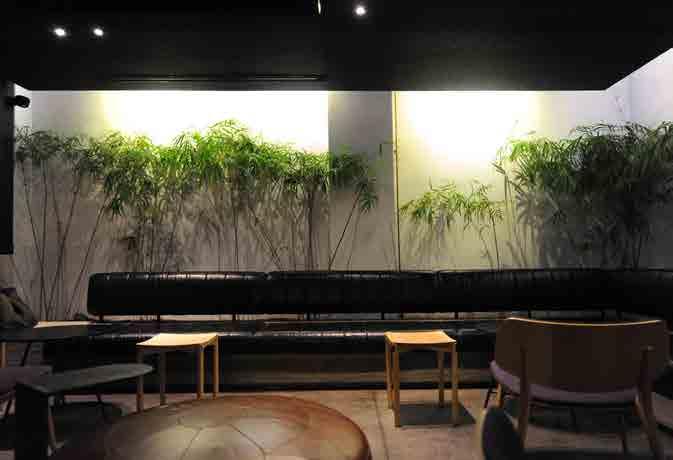
- 72 -
Dominion League by FINESPUN Architecture and Gab Scott. Image: Dion Robeson.
Strange Company by spaceagency. Image: Michael Patroni.
i’ll meet you at the bar
Author Jess Beaver
The local pub, the ol’ watering hole… the place where everybody knows your name. The story of alcohol and those who imbibe it is a historical one, dating back to ancient times. It began with the Egyptians creating arack, and through man’s continual pursuit, sometimes accidental, it developed into refined wines, brews, and distilled spirits. Simply put, booze has always held a place in society. Through changing times came the need for a space to serve such drinks and concoctions. Enter, the bar.
The bar is an interior that contains a curious set of qualities associated with a service and a feeling of some un-seriousness. It’s a place to unwind, escape, play, romance or celebrateand there is an abundance of choice growing in our city.
For me, the bar is a memorable place. Not only does it fulfill my social needs, but it has also allowed me to pursue many other avenues of creativity. Ten years from picking up my first cocktail shaker (and still shaking today), I’ve grown to appreciate and respect the hospitality industry and all the players involved. The essence of hospitality within the cocktail bar is not dissimilar to architecture: operating at the utmost creative capacity, creating narratives and providing a unique service, constantly considering the designed elements’ scale and form, and all whilst building strong relationships with your client.
In 2007, when I was both working in bars and studying, Local Governments throughout Perth pursued and encouraged operators who could bring innovation to the creation of intimate venues that would offer unique alternatives to the traditional ‘beer-barn’ venues littered around Perth. This led to a liquor licensing reform that included facilitating the granting of many new small bar licenses. Great opportunities arose for businesses to create new spaces that differed from their larger counterparts, giving greater choice to the discerning drinker.
Bars are an important element in the cultural and architectural fabric of the City and, thanks to a growing group of innovative local designers, Perth’s bar scene is continuing to introduce new, diverse and interesting spaces. Operators have started to realise that creating the ‘perfect’ space is more than just the integration of staff, offering and value – but of creating an atmosphere and physical space that entices patrons to want to stay for one more drink.
There is a great selection of bars in Perth, however there are a few in particular that seem to keep bringing the crowds and continue to entice me to stick around for one more negroni… (And remember, hangovers aren’t a consequence, just a reminder of a great night).
Strange Company, Fremantle –spaceagency
A neighborhood bar slotted into a quiet street in Fremantle, Strange Company doesn’t shout out as a ‘destination venue’. It’s cleverly nestled to allow passersby to discover its ‘strange’, wander in, and enjoy a drink (or three). Nestled between buildings on three sides, spaceagency have cleverly utilised natural light from both the entrance and from above, allowing it to spill and wash through the venue to the back recesses of the bar, providing a cozy, balmy atmosphere.
The main bar is an engaging centrepiece that becomes a pivot point between the several carefully designed spaces surrounding it. Each area is characterised by the varied selection of custom chairs and tables. The timber paneled ceiling draws the eyes through the venue where they tend to linger for a moment at the back wall: a scattered array of bamboo nestled in the corner that runs back toward the entrance of the bar – all brightly illuminated with washed light from above. A tangible, hearty timber bar top, polished tiles and metallic finishes applied through both the bar and kitchen make the space feel like it could be a part of your home.
Dominion League, Perth –FINESPUN Architects and Gab Scott
The Dominion League creates two vastly different, yet complementary
- 73 --•
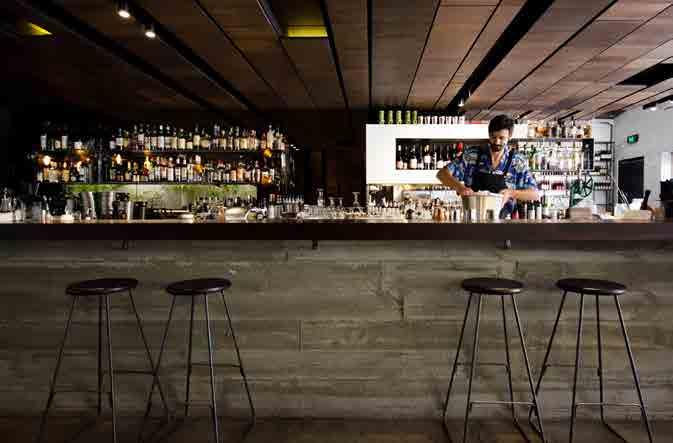

- 74 -
Strange Company by spaceagency. Image: Michael Patroni.
Strange Company by spaceagency. Image: Michael Patroni.
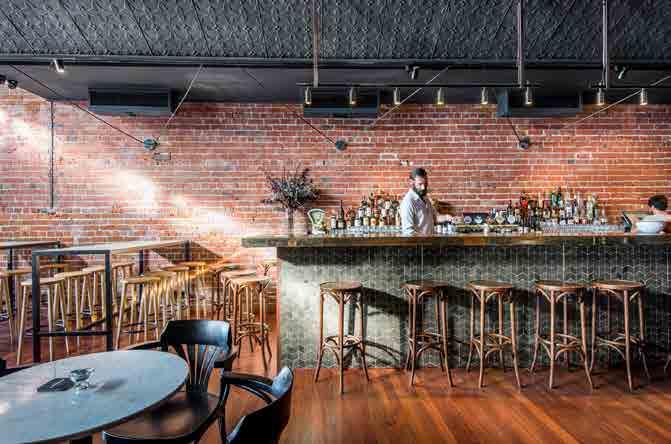

- 75 -
Dominion League by FINESPUN Architecture and Gab Scott. Image: Dion Robeson.
Dominion League by FINESPUN Architecture and Gab Scott. Image: Dion Robeson. •
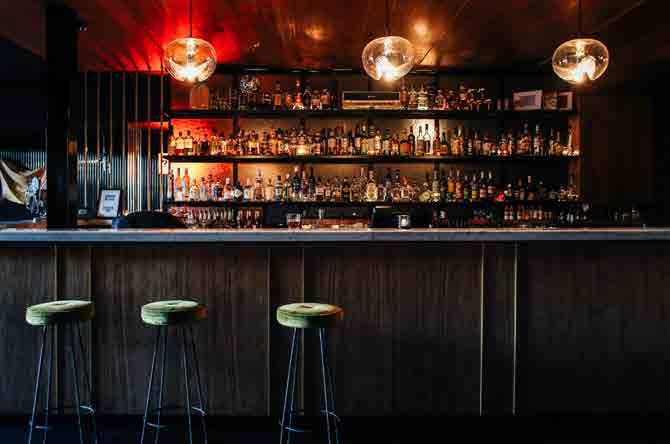

- 76 -
Late Night Valentine by Lazarus Studios. Image: Courtney Illfield.
Late Night Valentine by Lazarus Studios. Image: Courtney Illfield.
spaces and experiences, hinting at parts of WA’s lesser-known history (search ‘Secessionism in Western Australia’ on the www).
The Ground Level Bar leads off Beaufort Street and draws you into an open, bright and familiar space adorned with a pressed tin ceiling and a bar accented by purposeful lighting. Focusing on the details and décor, scattered images, nostalgic memorabilia and delicate timber furnishing garnish the space while the large sashless windows introduce warm daylight to the bar; the lengthy timber sill operates as the perfect way for drinkers to interact with both the venue and the street.
The Whisk(e)y Den is almost an entirely different venue. Accessible via a grand internal staircase that was meticulously revived, its feel and offering are in stark contrast to the space entered off the street. You are grasped by the dimly lit and cavernous bar formed by exposed floor joists, dark patterned ‘pool room’esque carpets and deep-set soft booths.
The aromas of whisky and jaffles add to the intimate and brooding physicality of the bar, providing ample motivation for one to extend that final nightcap.
Late Night Valentine, HighgateLazarus Studios
Like a semi-glamorous roadside motel, oozing with dark velvets and tropical greenery, Late Night Valentine transports its patrons with an excess of 70s styled luxury; a dark den disconnecting its patrons from the outside world. With minimal signage and inconspicuously located on a busy Highgate street, the bar’s identity lends itself to word of mouth, or those who stumble past and peer into the red, glowing window and decide to wander inside.
As you enter, textures overload the senses within the dimly lit space, leading you to the bar which is encaptured by a series of mid-century blown glass light pendants hanging over a cool, white marble bar top. The space is enclosed with dark timbers and soft textural fabrics and glossy black scotia running across the walls. For what feels like a quaint space, it secretly expands
into three separate bar areas for the more curious drinker, enabling more opportunity to roam, pause and delve further into the darkness.
A deceptive application of colour, texture and decoration are used to manipulate space and sensory engagement whilst you move through the bar. There’s a feeling of continuity and flow in the venue with glimpses of the strange yet familiar, but Late Night Valentine has all its elements acting in harmony. No attention to detail has been spared, from furniture and material finishes, through to the design of the cocktail menus and branding inside the venue.
Late Night Valentine is a guilty pleasure that uses darkness, design, drinks and good music to keep the clientele enjoying themselves late into the evening.
A good venue sets the mood, is comfortable, and provides particular libations to suit a specific drinker, because not every bar and drink is for everybody. It’s the memorable ones that draw you back, time and time again. •
- 77 -


- 78 -
Perth Cultural Centre: FRINGE World temporary ticket office. Image: John Leonard. Source: fringeworld.com.au
State Theatre Centre by Kerry Hill Architects. Source: Kerry Hill Architects.
festivals and the architecture of the city
Author Brett Wood-Gush
Any reflections on Perth’s FRINGE World Festival and the Perth International Arts Festival (PIAF) recall warm evenings, spiegeltents, pop-up bars and a deep indulgent binge of sublime and fringe culture. These events sit at the pinnacle of a cultural scene that has so relegated Perth’s glib title as ‘Dullsville’ that it seems a distant memory. Perth’s festival season celebrates our city, aligns with a strong vision for urban places, and embraces architecture as its backdrop. Architects engaged in these festivals – such as Ahmad Abas, Former Chair ArtRage – have been pivotal to their establishment and success.
The scale of these festivals is bewildering. Published metrics from FRINGE World documents 713 events across 159 venues with 3,381 performers and an audience of 989,675.1 From a pilot festival in 2011, FRINGE World has grown to be the third largest in the world. On every metric, its success is stunning: performer and audience satisfaction, promotion of the value of culture and arts to WA, and broadranging benefits for tourism and business. For many, FRINGE World is their first cultural taste besides going to the cinema, and its lure for visitors to return comes from the festival’s impromptu and ephemeral nature and the variety of offerings. FRINGE World has successfully brought to life
buildings and spaces across the city that are more passive in nature or have sadly been long forgotten.
Australia’s longest running cultural festival, PIAF was started in 1953 by The University of Western Australia. Unlike FRINGE, it is curated and programs the best international artists. Its multiart approach amplifies use of Perth’s performance spaces from major civic cultural buildings through to outdoor cinemas. Major community events such as the Journey of the Giants and Boorna Waanginy have transformed how we see our identity and geography and have drawn people in their thousands to engage with art performances. Annually, the program engages over 700 artists in 249 events and connects with over 500,000 people.2
These festivals are helping to change the face of Perth, challenge our understanding of city spaces and our regulatory role, and build new levels of engagement with cultural events and space. They present an opportunity for architects to engage in the architecture of city events and place-making as systematically as they do with the architecture of cultural centres. Critical thinking should also be applied to City architecture and architectural briefs as the success of these festivals demonstrates the potential for broader
community engagement with Perth’s architectural fabric and lost spaces across the city.
In 1992, Danish Architectural Professor Jan Gehl claimed Perth had ‘a cultural centre that has no culture’.3 This was accepted without contest. Professor Gehl had been invited by leading architects, planners and community leaders to help revitalise the City of Perth. He had indicated his measure of success was public use of public space. On that measure, the Perth Cultural Centre was failing. The grand vision for a ‘modern’ cultural precinct was framed in the 1955 Stephenson and Hepburn Plan for Perth. Unfortunately, the high ground above Northbridge had instead turned into one of Perth’s least desirable places. It had become an area of the city that people avoided after dark; yet its position between the City, public transport and Perth’s dining and entertainment district offered such promise.
By 1994, a program was put in place to upgrade the Cultural Centre. Masterplans and a 25 year delivery program were established but little progress was made over the next 10 years. The grand vision needed considerable investment and challenged one of the persistent paradoxes of cultural institutions. Historically they
- 79 -
1 2016 FRINGE World Impact Report. Artrage Inc. 2 https://perthfestival.com.au/festival-info/about-piaf/ 3 Author ’s personal observations while acting as study team co-ordinator on the Perth ‘Public Space and Public Life Study’. City of Perth and Government of Western Australia, 1992. •
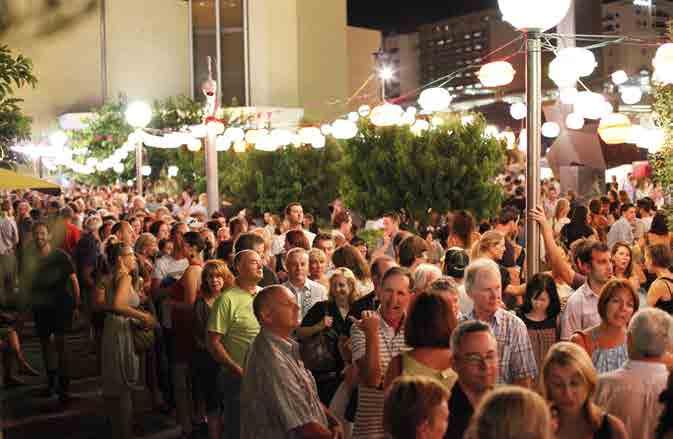
are about protecting the program, objects and assets within; only a fraction of their work is public and this often needs tight security making good street life in the design of cultural buildings a difficult undertaking.
The Metropolitan Redevelopment Authority (MRA) was appointed in 2009 to assist the institutions in commencing improvements to the Perth Cultural Centre to complement development of a new State Theatre Centre. The brief was limited: there was no building program, a vested collection of heritage buildings that were uninhabitable, and a major community detachment from the precinct. The MRA’s response was to take a short-term, tactical approach to the problem: an $18m revitalisation program to restore the heritage buildings, implement a targeted leasing program, and transform some of the underutilised spaces within the public realm.
Architects, landscape architects and artists assisted in the delivery of physical improvements to the Cultural Centre spaces. The rooftop
of a public carpark became an 'urban orchard' and a desolate water feature was transformed into a native wetland that today still serves as a reflective space, nature-play environment for children and a performance space with an amphitheatre and stage. Further enhancements came as new creative and hospitality tenants moved in supported by servicing improvements including power, water and catenary lighting. A curated events program and a deliberate strategy to keep franchisees away from the restored heritage buildings created a niche community on the edge of Northbridge and attracted new crowds to rediscover the space. Permanent and ephemeral public art and a large children’s playground followed, and an urban LED screen providing opportunities for cultural and artistic expression. The State Government also invested in landscaping and security improvements throughout the public realm thereby increasing patron safety and passive surveillance.
New business, colour, creativity and vibrancy quickly became affiliated with the Cultural Centre and the adjacent
William Street precinct. None of this however explains why the area now has 12 million visitors annually, holds 50 major events and is considered Perth’s primary destination for events and City culture. That falls to MRA’s place-making program and the advice of experts like Fred Kent, founder and president of Project for Public Spaces who brought his experiences from New York to help revitalise the space.
Buoyed by global examples of success, MRA encouraged applications from local entrepreneurs that could provide temporary, small-budget installations (pop-ups) in the space. Rising from backgrounds in commercial leasing, arts management, hospitality and cultural production, the more avantgarde operate with assumed license to respond to social need in an ephemeral, innovative nature not afforded in a traditional commercial environment. The approach sits on a spectrum that also includes internationally renowned events producers and managers who arrive with their credentialed reports in hand.
- 80 -
Lining up for the spiegeltent at FRINGE World. Image: Cam Campbell. Source: fringeworld.com.au
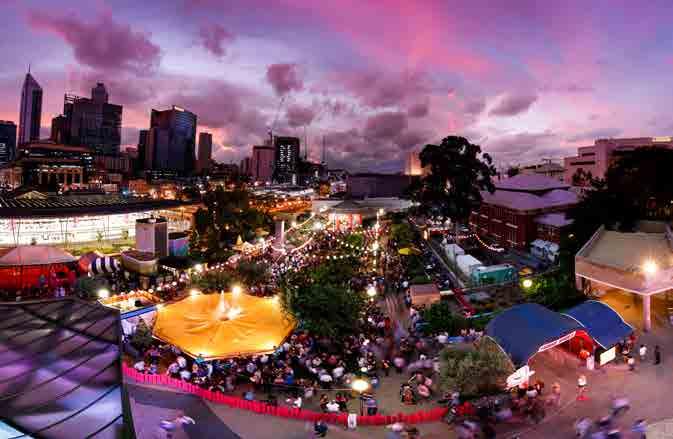
The early rebirth of the Perth Cultural Centre saw the space work as a laboratory - a place to test concepts from weekend markets to monthlong festivals, to art installations and community events. Planting days on the weekends, Friday night festivals and markets, environmental children’s programs, and movie screenings attracted new crowds to the space and celebrated the surrounding built form in different ways. Place plans led by the MRA engaged with key stakeholders to see the Perth Cultural Centre emerge as one of Perth’s most in-demand event spaces, all year round. This work afforded an opportunity to PIAF, FRINGE, AWESOME and many other festivals to progress with certainty.
The changing nature of the Cultural Centre seems also to have encouraged architects to embrace challenges and create buildings that engage in new ways. The State Theatre Centre of Western Australia by Kerry Hill Architects was not offered the opportunity to delve into a universal contemporary aesthetic - it had to be
inserted into the heritage fabric with its only free facade addressing a difficult section of Roe Street. It handles Roe Street with eloquence and provides a showcase of the internal life to the City. Through a series of tactical moves the building also creates a precinct of publically accessible spaces, enriching the Cultural Centre. The State Theatre Centre appears to not only address the disruption of city architecture, presented by festivals such as Fringe and PIAF, but becomes their stage inside and out.
Place management has become a disruptive urban force jettisoning Perth out of its parochial notions and into a fluid relationship with City, ownership, value, authority and our own identity. Architecture should be at the centre of the forces changing our city: architects recognise that space can be territorialised by self-interest groups, limiting opportunity for change. Public space can also be seen as under autocratic watch, limiting creative expression. Conversely the need for ‘sense of place’ is included as a principle in regulations to which architects are
asked respond.4 Australian architectural writers are exploring sense of place, suggesting places are created from their unique (cultural) stories,5 and examining how perceptions of meaning – generated through habitual patterns of use – may be accommodated.6
Spanning the physical and metaphysical, architects have a role to play in engaging the community to develop place plans for the design of public spaces and how they are activated. Architects also appear positioned to provide expert design advice, arbitrating on behalf of public space as a functional area rather than lost space between buildings. As FRINGE and PIAF have well proven, there is opportunity in these spaces to transform public perception of the city, and at the same time they are changing our perceptions of the role and value of architecture.
The author is grateful for the substantial research assistance received from MRA staff and others. The views expressed in this article are solely those of the author. •
- 81 -
4 For example: MRA. 2012. Central Perth Redevelopment Scheme 5 See: Paul Carter. 2015. Places Made After Their Stories. UWA Publishing. 6 See: Reena Tiwari, 2010. Space-Body-Ritual: Performativity in the City. Lexington Books.
Urban Orchard during FRINGE World. Image: Cam Campbell. Source: fringeworld.com.au
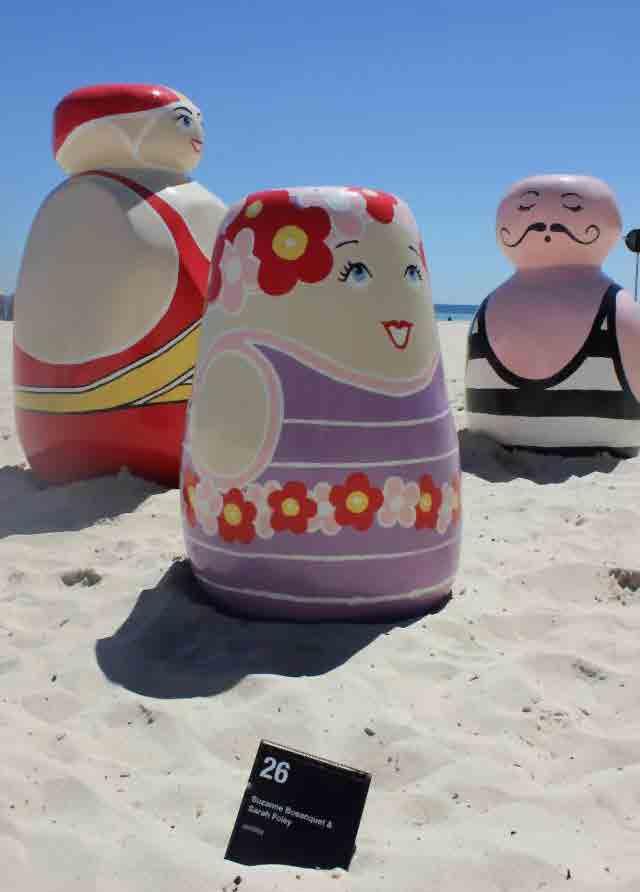
- 82 -
Skittles by Bosanquet Foley Architects. Image: Clyde Yee.
playing skittles
An interview with Sarah Foley on Bosanquet Foley Architects' 2013 piece for Sculpture by the Sea and other installations.
What motivates Bosanquet Foley Architects to undertake commissions for playful and artistic installations?
We are motivated by our architectural pursuits first and foremost and have a fierce artistic side that can’t be quenched so we are inventing, creating and engaging people with our artworks – be it large installations or indulging in etching, drawing or painting. It is the instantaneousness compared to architecture that appeals but it is also the delight it provokes, particularly with children.
Skittles is a delightful art installation that inspires play within adults and children alike. What do you describe as successful design elements that encourage play?
Design elements to encourage play need to be robust so that people are not limited in their interaction. The Skittles installation is carved polystyrene coated in fibreglass and boat-cote epoxy. It is robust enough to sit outside in the elements and be pushed around on the car springs that return the skittles to their upright positions. Colour is also important to stimulate playfulness. These characters are cheeky, distinctive, playful and vibrantly coloured.
Often architects are perceived to be involved in the production of buildings. How do you see the practice of architecture to embody a broader spectrum of art and design?
Architects are perceived to be involved in the production of buildings because that’s their real profession and that’s stimulating enough for a while but once you’ve done that a few times one
searches for something more. A search for other meaning in what you do… a creative pursuit because as architects we all start as ‘creatives’.
Architecture requires discipline, knowledge of structure, the corseting of a client’s brief and budget; so art and design are the antithesis, the freedom that architects need to balance their practice.
Have you completed any other projects exploring the relationship between visual art and architecture?
An important project in experimentation with materials was the Aloop Series, developed for Saturday Indesign in Brisbane. It consisted of six aluminium pieces that were inspired by the lines of the furniture from the showroom hosting the installation. University design students were involved in the process for mentoring and conceptualisation of an idea.
We also had three pieces of artwork commissioned for the Brisbane Mercedes Benz fashion festival. One piece consisted of two large chandeliers made from coat hangers for the foyer of the main marquee of the event and the second was kilometres of recycled paper quilled and coiled and tressed from the ceiling. Thousands of people took part in the festival. This level of engagement was intoxicating for architects whose work usually has a steady gestation and affects only the handful of people who occupy the building.
A recent notable children’s art project was a two-part interactive installation entitled Paper Boats for the Out of the
Box festival in Brisbane. The festival drew over 60,000 people. It was placed on Maiwar Green outside the Gallery of Modern Art and the State Library of Queensland. Tyvek Boats was an exercise in collaboration with a kitemaker and a fabulous interaction with children’s unreserved energy and interaction.
Another notable children’s public art project was a three-stage interactive installation with 60,000 white lego pieces inspired by Danish artist Olafur Eliasson. It involved a complete day and involvement of a primary school, 160 architects and then finally the public who accessed the installation at the Art Gallery of WA and toured to remote towns of Western Australia.
What benefits do you see in a broader reaching, interdisciplinary concept of architectural practice?
It is the engagement with the community that is enriching: the exciting unpredictability of working with children and university students when collaborating and mentoring. Discovering new techniques (etching, painting, metalwork, woodworking) feeds back into architectural decisions and also adds a richer visual palette to the products you are producing.
We are dedicated to continued development, innovation and research to remain at the cutting edge of the field. This is reflected in our involvement in art practice. Collaboration with other architects and professionals enriches our experience. •
- 83 -
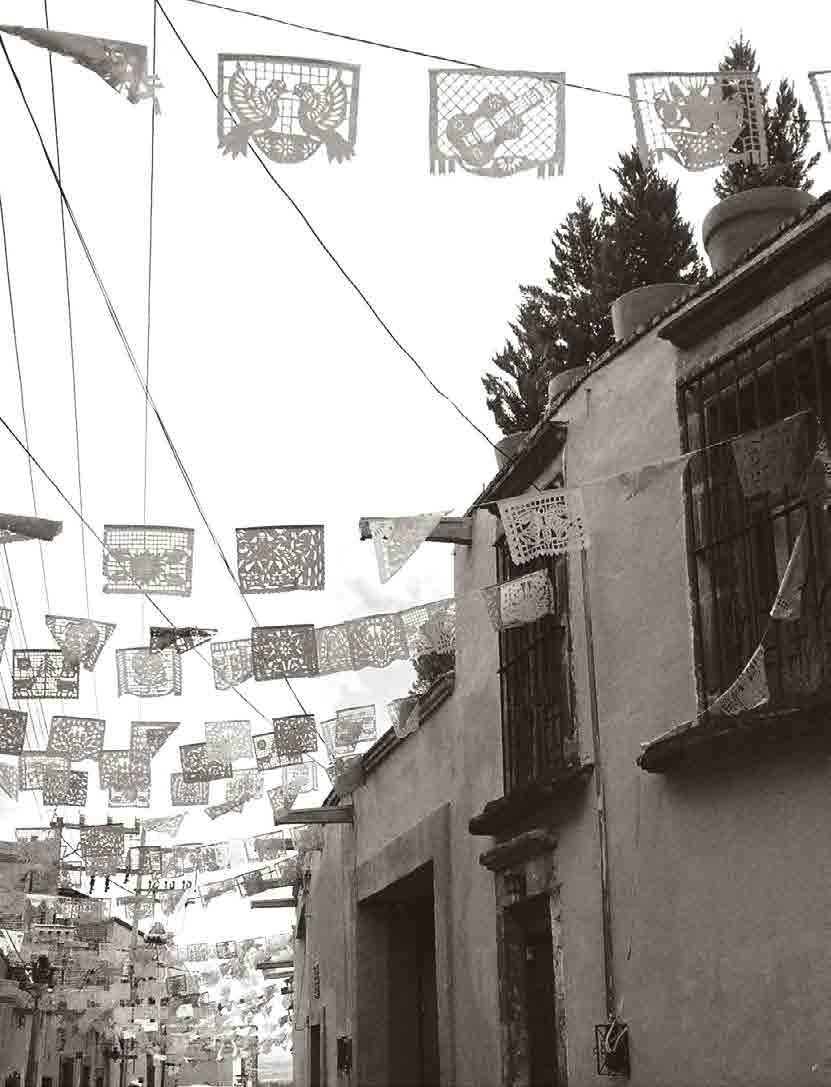
work / rest / play
- 85 ---
artists in residence
Author Michelle Hovane, Koral Ward and donaldson+warn
The Sustainable Housing for Artists and Creatives (SHAC) project at Landcorp’s WGV development seeks to address the lack of affordable housing for artists practicing and contributing to cultural life in Fremantle. Delivered with the support of the City of Fremantle, and as partnership between Landcorp and Access Housing, SHAC will soon be one of the first projects to be occupied in the groundbreaking development. Michelle Hovane and Koral Ward, members of SHAC’s inaugural committee, and Daniel Aisenson of donaldson+warn architects describe the design and value of this project to both artists and the broader community.
MICHELLE HOVANE AND KORAL WARD
SHAC
SHAC began as a creative response to the housing crisis that intensified in 2007 as the mining boom took off and Perth became a dormitory suburb to an influx of well-paid interstate and international workers. Whilst this was a boost for cultural consumption it was a blow to cultural production. Visual artists, musicians, performers, community artists – ‘creatives’ – are an essential part of Fremantle identity,
both in the past and today. SHAC is a group of just these local artists, those who create floats for parades, perform on the streets, play music in the bars (and often work behind them). We are the people who make Sculptures by the Sea, yarn-bomb the bronzes; we are the people who spray up the walls; we are the people who work within the community, with the marginalised and disadvantaged, transforming lives. Artists in Australia fall into a unique category of ‘low income professionals’. Whilst income varies by artform, fulltime professional artists consistently earn less than the average wage. Hence there is an enduring relationship between art-making and affordable housing. It is also why artists tend to be one step ahead of gentrification, flocking to areas with cheap housing, enlivening and transforming the area, raising property values and then becoming victims of their own success. In 1970s Fremantle the shift from warehousing to container shipping had created an abundance of cheap living and studio spaces which cemented Fremantle’s reputation as a hub for the arts, but property prices had been steadily rising for decades and by 2007 the final toeholds in the private rental market were in the firing line.
SHAC was conceived in the backyard of a long-time artist’s share house on Stevens Street White Gum Valley. The house, a falling down heritage-listed cottage, had an enormous shed and backyard and had been an artists’ living and working space for at least 20 years. In 2007 the house was sold and the space was effectively lost. The artists concerned, who became the founders of SHAC, decided that there must be a collective solution and began talking to anyone who would listen and who might be allies. Everyone agreed that it was very important that artists continue to live and work in Fremantle but for a long time, no one put any money on the table. So SHAC is thrilled that in 2017, a decade after those first discussions, 13 artists and their families will be moving into affordable housing units a mere couple of blocks from those first prescient discussions at Stevens Street.
The SHAC dream has been to create a space where artists can continue to thrive in Fremantle, a structure for living that recognises how work forms an inseparable part of that living, and how built form can be part of the environment: urban yet green, private and public, social and cultural – a contemporary ‘machine’ for both living
- 86 -
and working (apologies to Le Corbusier). Our investment is economic, emotional, aesthetic and ethical, and we could not have afforded this project without the mutual faith and support of our partners Landcorp, Access Housing and the City of Fremantle. Landcorp offered the land at a discount and were the first to commit, making SHAC a key part of the WGV development. Access was the next partner to step up, coming on as the developer to build the dwellings and studio in collaboration with SHAC and agreeing to act as the landlord for the living spaces. SHAC will be responsible for tenant selection from their growing membership base.
SHAC artists took part in the design process with Access Housing and architects donaldson+warn to invent a new model, sustainable both in terms of the environment and of SHAC’s future in the community. There is a Bauhaus feel about the two apartment blocks which comprise the building, facing each other as they do, and something theatrical about the space between them. The steel stairs and concrete walkways are expectant of promenade theatre, aerialists and wire-work: an opera-factory of everyday life where ideas are exchanged across and between balconies. The heart of this
cool, post-industrial ‘village’ will be the communal studio for which SHAC is currently raising money to own and run as a social enterprise and build equity within the project. The studio is where we, and the surrounding community, will meet, work, and dream: exhibitions, workshops, happenings, music nights, think tanks, unusual events… SHAC is a hub for the change we want to make in our city of Fremantle and in our world.
DANIEL AISENSON
DONALDSON+WARN
The SHAC project brief is unique in the way that it provides affordable housing for a single user group, in this case a Fremantle-based collective of artists. This reverts the typical focus of multi residential developments from individual to collective amenity. Given our continuing commitment to social sustainability and support for the arts community we were immediately attracted to this brief. It presented the opportunity to engage with the challenge of housing affordability from a design-led perspective, which could also materialise SHAC’s aspirations for living and working in one place: Fremantle.
Since the early stages of the design process it was very clear that we were not being briefed by a client following market trends but a group of artists with a rich variety of backgrounds, needs and aspirations based around the aspects of identity, affordability, community, place-making and arts practices. These topics would not only become a conceptual framework for the project but also led us to develop the project as a flexible ‘framework’ itself. A framework which could accommodate different dwelling types, serve as a spatial canvas for artists to create and display their work, provide opportunities for the collective use of space, and respond to site topography, environmental conditions and the Fremantle identity.
A planning module was developed for the two building blocks that flank a central communal space. The project brief called for four town houses, eight apartments and a shared studio to be used by SHAC as an open space for the artists and to host communal events. The design posed the challenge to create enough diversity for the dwelling typologies to suit individual needs while exploiting the economic benefits of repetition and the use of typical details to meet the stipulated cost benchmarks.
- 87•

The planning modules (8m x 8m) were composed around a rational structural grid, and combined to meet different apartment configurations and required areas: a single module became a single bedroom apartment, a 1 ½ module became a two-bedroom apartment, two modules stacked became a threebedroom town house. The vertical allocation of dwellings further increased the variety of dwelling types, while the ground floor dwellings with courtyards were allocated to families. Apartments located on the top floors benefit from the pitched roof that provides spacious internal volumes via a ‘loft’ configuration with a mezzanine.
The central communal area between the building blocks forms the ‘heart’ of the development. The functional elements located in this space (walkway, stairs and roof structures) provide opportunities for SHAC members to personalise the space with art works and temporary installations. This communal core will see people moving through the space, children playing outside, collective
events and parties, with the architecture acting as a backdrop for everyday life.
The shared studio is a key component of the brief. Spanning two floors, it is located to the north-east of the site with direct access from the street and good connection to the central communal core. The studio expresses the collective SHAC identity through a generous balcony facing the street; the use of translucent materials giving some weather protection and allowing ample light into the space. With basic services included, the shared studio can accommodate community meals, meetings, artists in residence, exhibitions, performances and an everyday workspace for the SHAC artists.
The trends towards residential infill and consolidation around metropolitan nodes, higher density developments and the integration of live, work and spaces can all contribute to community building and a much needed reconfiguring of select areas within Perth’s expansive suburbs.
Having initiated this project, the SHAC group has been actively involved throughout the design process. As a creative collective, the SHAC team has shown tremendous enthusiasm and support. Their inquisitive nature, their ethical drive for sustainability and the opportunity for affordable housing are refreshing indicators that alternatives for delivering multi-residential developments are possible with a supportive client willing to encourage user participation and interaction with the design process. •
- 88 -
SHAC by donaldson+warn. Source: donaldson + warne.
A POEM, BY STRIPE
There is a feeling of Bauhaus Dresden about these two apartments facing each other as they do.
The understated greyness of the walls.
The singular incline of the roofs.
The new materials, polycarbonate and solar panels.
The shade - sunscreens like the spoilers of speedway cars.
The ambient green horizontal juliets, the vertical strips of orange cladding.
Very cool, very post industrial.
A machine for both living and working.
There is also something theatrical about the space between these two blocks, about the steels stairs and concrete walkways.
Something expectant of promenade theatre, aerialists and wire work.
An opera factory of everyday life where ideas are exchanged across and between balconies.
Meyerholdt comes to White Gum Valley.
- 89 -
ise secret sushi peter hunt travel prize 2013
Author Brett Mitchell
JP-DE-DK-SE-NO-FI-ES-IT-FR-CH-US
Is architecturally focused travel work, rest or play?
(Can it not be all of these things?)
I understand travelling to be not only a source of lessons and inspiration but also one of life’s joys. The generosity of such an opportunity, which comes with being awarded the Peter Hunt Travel Prize, cannot be taken lightly nor valued in currency alone. The award’s worth can be measured in an afforded time and experience of life beyond the normal boundaries of daily experience – an experience often carried out in and around memorable architecture. The aim of my journey was to assign spatial experience to influential places and spaces previously registered only as distant images or texts. The travel prize journey enabled not only an undertaking of lived research to confirm or deny my previous thinking, but also a welcome pause and reflection upon my ongoing interest in architecture and how that might be shared upon my return.
The path of my travels was bound by a simple premise:
Words and images of architecture are not the experience.
A friend of mine once tried to recall how amazing a piece of Japanese chiffon cake tasted - but alas no adjective could be found to do it justice. The town of Ise in Japan on the other hand, I would quickly describe based upon my initial impressions as a low-rise, high density, blue-collar town set alongside both a murky river and an idle sea. In a less polite way one might add: run-down and tired. Finding myself in the middle of Ise-Mie I thought that perhaps a good thing to do here might be to find a piece of chiffon cake.
With a hand drawn map I had acquired, labeling various food outlets around the old machiya district, I located myself between two choices. One was a glass shop front with decorated cakes in the front window overlooking the busy main road. (The shop’s sign writing stated that it has been operating since 1962). The second option was a wooden door in an unassuming side street. Its only appeal was the hand written chalk sign filled with flowing Japanese
script, of which the one word written in English - 'chiffon' - stood out clearly to my tourist eyes. From the outside it looked like a mix between the childhood memory of my Granddad’s self-made shed and the rotting woodpile that was once heaped next to it. Still, I decided to enter this windowless establishment.
The interior was dark but for a series of dim light bulbs that hung directly over the coffee bar and seating areas. A cutout in the centre of each small table revealed warm stones heaped over hot coal baskets.
‘Cosy’ should be a term (and objective) more widely used in the architectural lexicon.
I was the odd one out amongst the small contingent of locals who were knocking back their afternoon coffee and cake. They sat separately throughout the ‘shop’ but talked freely across the room to each other in lively Japanese conversation. I observed this as I slowly ate a generous slice of chiffon cake topped with fresh whipped cream. Only then was I able to fully realise the difficulty one has in trying to describe the sweet, cloud-like sponge cake that melted away in my mouth.
...
- 90 -
The kind lady who served me spoke a little English.
‘Where from?’ she asked. Australia.
‘Si-da-nee?’ interjected someone from afar.
Perth I replied. (Blank looks and silence). West-Coast.
(With a finger pointed to the bottom corner of my outward facing palm). To which various nods and murmurs took place around the room.
I then tried to describe to the waitress how I entered a strange eating place on the first night that I arrived in Ise. It was the result of curiosity and a loose arrow pointing to a blank space at the edge of the hand-drawn map. At the arrow’s end the words read: Secret Sushi. Standing in a street, in what I thought to be the general area of the arrow, I saw no commercial signage of any kind. I guessed however from seeing three people walking through an otherwise nondescript residential door that they were perhaps going inside for dinner. I deduced all this from a minor detail in how they entered: slowly, with a pause at the open door, heads down – as if politely. I figured that if they lived there they would have walked straight in with
purpose, or if they were visiting a house, they would have surely knocked and waited on the outside to be received.
It's funny how being a 'tourist' sharpens your senses to the nuances of such things that are otherwise just passed off as ordinary.
I too approached, gently knocked on the door, paused, and then slowly poked my head in through the widening gap, desperately hoping it wasn't a family home. Inside stood a stunned chef and the three people who I’d witnessed entering not long before me. Despite there being empty seats I was quickly told via hand gestures from the chef and a single word translation from a gentleman seated at the empty counter that the empty room was ‘Full’. ‘Tomorrow?’ I asked.
The old chef behind the counter looked back at the customers. The customers looked at each other. The man seated with his wife then kindly translated back, of my request to eat dinner here tomorrow. The old chef looked back at the customers. The customers looked back at the chef. I looked on at everyone. The chef flustered something to himself. The man with his now smiling wife turned and conveyed
with a wry grin that yes, I could, ‘Try tomorrow.’
So here, upon finishing my chiffon cake I asked the waitress whether she could write down a dinner order of her recommendation in Japanese. I hoped that this might avoid another awkward encounter with the gruff sushi chef. A man sitting nearby intervened saying he was going there for dinner as well. (I had only referred to the place as 'secret sushi' but he apparently knew the exact place based on the described events that had transpired). He said he would happily translate the evening for me. It would turn out that this stranger was a historian who visits Ise often to ‘learn from old buildings’. He suggested that I go for a walk with him before dinner.
Out in the street the 'run-down' buildings were suddenly described in rich detail. The ones of historical importance were revealed by specific details in the scroll formations at the ends of each roof tile. We entered a 'second-hand store' and without breaking stride, greeted the elderly owner and disappeared straight out the back, down a literal tunnel of junk stretching from the street, with its 1984 Snoopy calendar coffee mugs in the window, past a commemorative
- 91 -
•
Sydney Opera House shaped cognac bottle, all the way back to what I was told were Edo period sake cups stacked amongst Meiji period vases (still wrapped in compressed rice straw as an early form of polystyrene packaging). Further into the dim light we went following a set of small gauge rail tracks used to cart goods deep within the bowels of the building. We went all the way back, until stopping upon a rotten stack of Japanese shoiji screens eaten away by time.
Without hesitation, and to my surprise, the historian started tearing the layers of paper screen from the old wooden joinery frames. In doing so he revealed calligraphy-like script on the back side of each successive layer pulled free. I was told that these layers of repair were made from recycled pages of merchant accounting books used when Ise was originally a bustling trading town. It is the historian’s role to now reveal and record valuable insights into the economic history of Ise that are hidden amongst this timeline of decay.
We would later end up in the roof space where he continued to pull out random artifacts such as tiny sake cups or odd shaped clay sinkers used in earlier fishing times. He pointed out that the whole timber structure of
the machiya we were standing in was nail-less. The structure was not pinned like the shrines that I had visited earlier that morning*. Each hacked beam and column was held by its own weight, gravity and the precise placement of the next piece that transferred the forces around the building in a continuous balancing act. The rough cut marks that scarred timber faces were made by being repeatedly struck by an old crowbar-style axe commonly used to transform a tree to lumber. It is a traditional technique not used anymore but one that allowed the historian to date the building to a time before Europeans colonised Australia.
We crawled through many other buildings and met the characters that inhabited them until eventually we found our way back to cake shop. The elderly mother of the waitress had by this time set up a green tea ceremony in preparation for our return. It turned out that she makes the chiffon cake and was happy that I had come so far for it. As she made the green tea in front of me I saw a Japanese version of my own family’s tradition of slowly grinding their coffee at the end of special occasions. It is a process passed down through generations, a process by which turns are counted and portions measured by the eye of experience.
I took the cup as instructed and turned it slowly in my palm as directed. It was very humbling. It tasted terrible.
The dusty lolly eaten before drinking to make it taste sweeter may as well have been a mothball. But I continued to drink it as the circumstances I had found myself in were so beautiful that I feared I might break their dreamy nature if I didn’t. A small crowd of customers had soon surrounded us hoping to also be granted such a special tea. They asked questions that were translated by anyone who wanted to have a guess at my English reply. I doubt whether I successfully described the Peter Hunt Travel Prize or why it bought me here to Ise, let alone the crazy house in Gelnhausen towards which I would soon be departing. I presented a photo of the strange German house to the group.
A bespeckled grey haired man guy piped up from the coffee bar.
‘Ahh I see. The house on TV.’
The group murmured in appreciation of this revelation. This man then decided to invite himself to the evening’s ‘secret sushi’ dinner - to also help translate. (He did not say another word in English for the rest of my time in his company). As if also on cue, a
- 92 -
drunk Japanese man crashed through the front door of the shop, stumbled forward through the small gathering and handed me a pack of rice crackers. I accepted them, upon which he stated in perfect English that - unfortunately - he must leave immediately to go find a toilet. He shook my hand as if an old friend, so I wished him luck on what was most likely going to be a perilous journey. No one could make sense of what had just happened. Instead the drunk man cannonballed back out into the street and everyone else dispersed back to his or her own seats.
The events however continued on along their strange and unexpected path.
Along with my translators I eventually ended up at the secret sushi place. The coffee lady had rung ahead and made a booking for us. We entered to the sight of a very well dressed man in a suit seated at the counter. It turned out to be the same man who was there the night before. He told us that his wife had forced him to turn up again – alone - to help translate for me. Apparently after I left the day before the chef had a minor meltdown when another 'English-man’ calling himself Henry walked in. Henry was told to go away and not come back. It turns out that the humble but gruff sushi chef has been trying to stay low-
key forever. No signage. No menu. No prices. No rush. He doesn’t want to get busy with work. He simply makes what is the freshest product on the day and only for the people that appreciate this approach and effort.
I could see nothing of the meal preparation as the metal counter at which we sat was covered in a wall of tupperware containers. My translators joked that it is the best tasting tupperware in Japan! The well-dressed man had been drinking the afternoon away whilst waiting for me to show up. He was therefore already slightly drunk on 'something' a bit like sake but served diluted with near boiling water. Out of cultural politeness I was poured a drink that never emptied. It tasted like methylated spirits mixed with shower water. I soon gathered that the aim was to drink it so hot that you can't taste anything but your mouth burning. My previous impression of the green tea improved with every sip.
Dinner was sublime. Ise-style yakitori chicken. Squid in miso vinegar. Raw mackerel. Fresh abalone topped with an edible garnish of internal organs of dissected fish. Raw tuna with accompanying ginger slivers to be dipped in soy sauce. (I was advised that any other way of adding soy sauce to
the meal would overpower the fish and negate the care and attention in its making).
Dinner was like a private sushi train, its destination: me.
The night soon turned into a funny mess because the drunk translator (#1) kept topping up the soon to-be-drunk chef’s drink. I could still count three ‘translators’ but only one of whom was still operational. The other (#2) was mostly silent unless eating loudly. It was revealed that the merrily drunk translator (#3) studied architecture but went on to do master planning, then moved into a government position in the Middle East before returning to work back in Japan in property development.
He said that the next time I visited Ise I was to bring two girlfriends: My own - and His. (It turns out ‘his’ was referring to my mother).
I was reminded of this gentleman’s contract for the rest of the evening. We would later receive a heartfelt but somewhat distressed lecture on how his wife can not stop making miniature teddy bears. He thought that ‘we’ - as in everyone including the chef - should
•
- 93 -
go see this spectacle immediately. It was decided however, that this may not be a good idea. Not because it was well after midnight on a weeknight (or that we were all now drunk) but because we probably wouldn't all fit inside a tiny house filled to the brim with so many teddy bears anyway.
Small spaces. Engaged Moments.
The small dimensions of this Japanese space soon became apparent when everyone started taking turns crashing into and out of the toilet cubicle immediately adjacent to the counter. This often had a domino effect on those left seated. The delivery of food seemed endless, as did the pouring of that 'drink'. When I suddenly felt hungry for the previously gifted rice crackers I realised that it was probably a good time to leave so that I might make my train in the morning. It was then that I was formally handed business cards and told that I would not be allowed to pay for anything. In exchange everyone decided that they would one day come to Perth to eat crayfish. All I could say in reply was ‘Arigato gozaimusu’. I accompanied this with the deepest, most polite bow the sake-like drink would allow me.
The chef replied, ‘Come back again soon’ (in perfect English).
The last thing said to me by my translators though. "Ichi go Ichi e"
It is a Japanese saying. One which attempts to describe a once in a lifetime chance (or fleeting encounter). One that may never be repeated even if attempted.
*The original purpose of my travel to Ise was to visit the fenced Shrines of Naikū (内宮) and Gekū (外宮). These ancient wooden structures are located within a suitably scenic national park and have been cultivated and re-constructed every 20 years or so since the first century. It is an ongoing act which marks time, celebrates both nature and culture, the cycle of life and our place within it. The journey was prompted by the reading of a text that described this exemplar of Japanese architecture as being a pure reflection of a culture temporal in its dimension: one which always attempts to defy time and the often repeated destructive events in life – whether they be economic, environmental or those catastrophically manmade. Here, eating cake, drinking tea, walking through ancient machiya houses and later stumbling into and out of a secret sushi kitchen I was also able to experience firsthand an alternative reading of this culture whereby the new is intertwined with the old, in a juxtaposition and contradiction of moments - not just objects, that are as potent in their fleeting presence as they are now in their absence. ...
Brett Mitchell was the 13th recipient of the Peter Hunt Travel Prize. He does not drink beer, wine, milk or hot drinks and can count on less than two hands the amount of times he has been completely drunk - two of which occurred unwittingly in Japan. •
- 94 -

- 95 -
Image: Brett Mitchell.
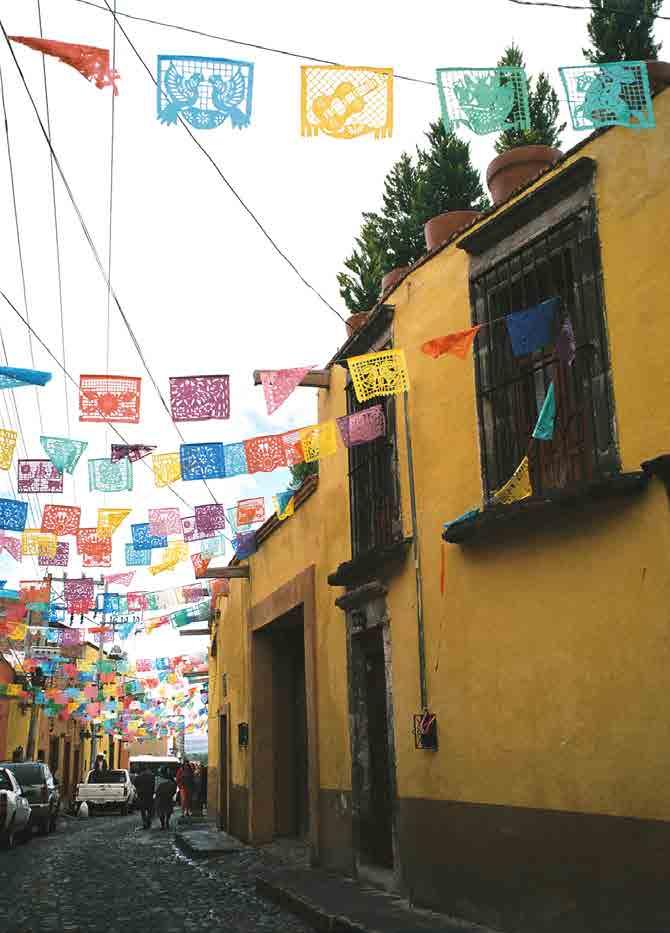
- 96 -
San Miguel de Allende, Guanajuato.
barragan’s mexico: architects board graduate award 2014
Author Tess O’Brien
I arrived in Mexico City on Christmas Day 2015. Its hugeness and moments of chaos brought an unanticipated sense of unease during the first few days; realising my smallness in this megacity and immediately regretting that my pre-trip Spanish practice had not been a committed one. Learning the smaller nooks and crannies of Mexico City through its trustworthy public transport and the surprising ease of roaming the City on foot, I grew to settle into the rhythm of travelling here. The smaller moments in my first few days set the tone for what was an enriching tour of Mexico: stopping to enjoy the jovial tune of a mariachi band, being in awe of the Frida Khalo studio and house, the discovery of a welcoming street market, and delving into ceviche tacos surrounded by locals and their charismatic lingo.
This trip was the outcome of receiving the 2014 Architects Registration Board of WA Graduate Award. Research during my masters thesis project at Curtin University had fostered a love for the work of Luis Barragan and, through my award proposal, I suggested I would travel to Mexico to explore Barragan’s works and the curious country he lived in. Over five weeks I bussed my way around Mexico, admiring its colourful, rustic personality. A country that immediately reveals itself as being an
intriguing mix of old and new, Mexico is a place which holds on tightly to its traditional arts, crafts, clothing and food, with ancient indigenous culture and people woven into a distinctive blanket of American and European threads.
This photo essay reveals two periods in Barragan’s career. His early works, located in the city of Guadalajara, and the masterpieces that occurred during the later period of his career in Mexico City. Together these photographs reveal the maturing of an architect, one who explored a merging of local, traditionsoaked style whilst sitting gracefully within the modernist period and the distinct Mexican climatic and cultural condition.
The experience of visiting these two diverse bodies of work brought to light the foundation and refinement of the architectural cards Barragan played in many of his works: manipulating light through painted glass or thoughtfully positioned openings, not always intended for viewing from but to bring light in to bounce off a wall or a precisely located golden artwork; thresholds, designed to be just a little shorter than usual, inevitably celebrating the experience of moving from one space into another, likewise manipulating the ground level with
subtle changes in level, highlighting progression through spaces; and landscapes into which the built form nestles - a walled oasis.
Walking through Barragan’s rooms, gardens, and rooftops was emotive and absorbing; the rich poetics in his works having a notable impact as I soaked up the boldness of solid forms, the crafted washes of light, and the significance of spaces left empty. The moments of arrival had an impact of another kind, with no hint as to what lies beyond the strong walls that border the street, and with modest front doors morphed in both scale and significance in comparison to the spaces that would inevitably be found beyond. It was the contrast of these two experiencesarrival and then moving in beyond the street edge - that allowed me to draw lines between day-to-day life in Mexico and the works of Barragan. Gentleness, emphatic brutality, contagious happiness and evident sadness surmise the personality of this broad country, and in turn hint at the significance of the distinct urban pattern where predominantly wall-lined streets shelter the domestic realm. In the case of Barragan, beyond this wall is a spatially calm world completely removed from the outside.
- 97 -
•
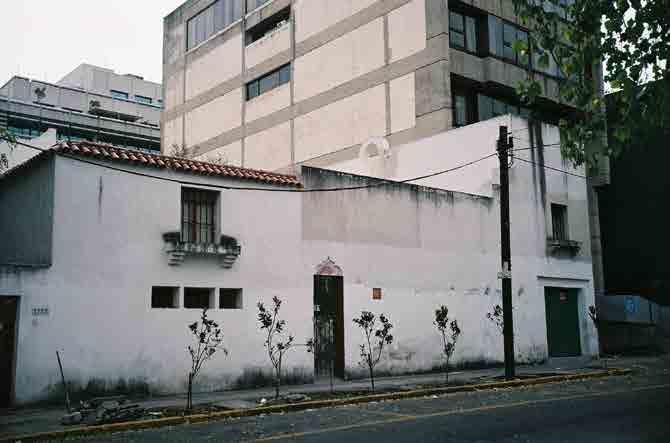
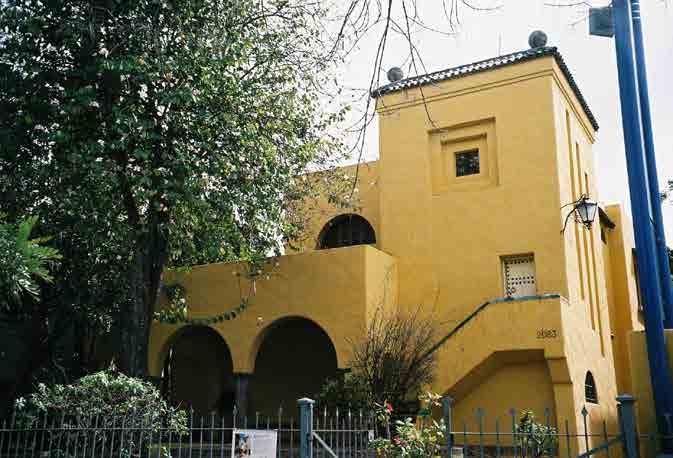
- 98 -
Gonzales Luna House, 1929, Guadalajara.
Cristo House, 1929, Guadalajara.
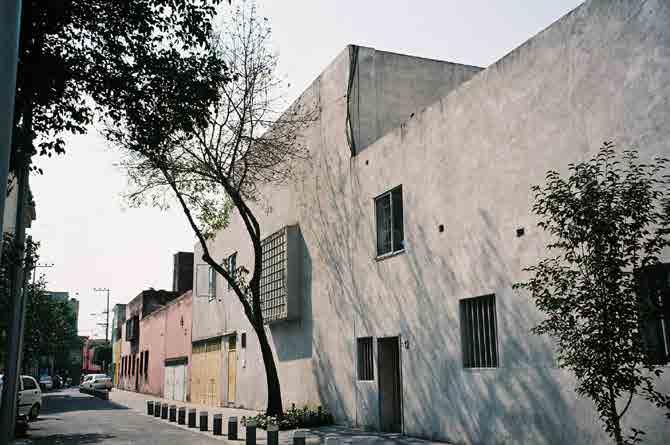

- 99 -
House on Calle Rayon, 1934, Guadalajara.
•
Barragan House & Studio, 1947-48, Mexico City.
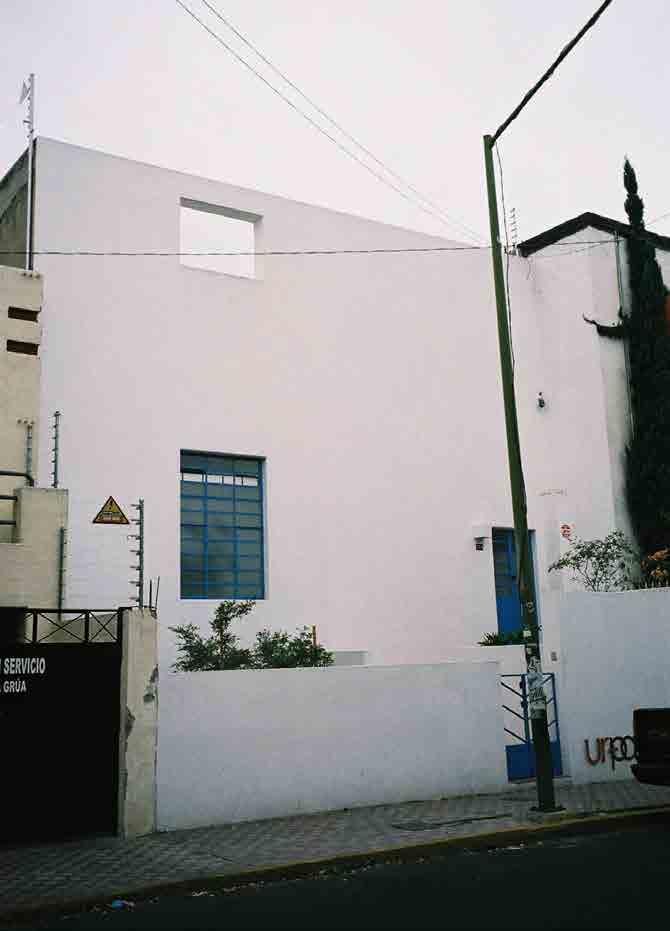
- 100 -
Orzoco House, 1937, Guadalajara.
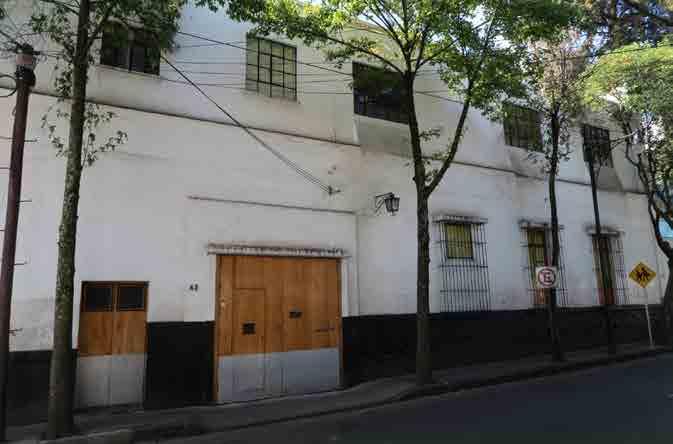

- 101 -
Chapel of the Capuchinas, 1954-60, Mexico City.
San Miguel de Allende. •


- 102 -
Gonzalez Luna House, 1929, Guadalajara.
Cuadra San Cristobal/ Egerstrom House, 1966-68, Mexico City.
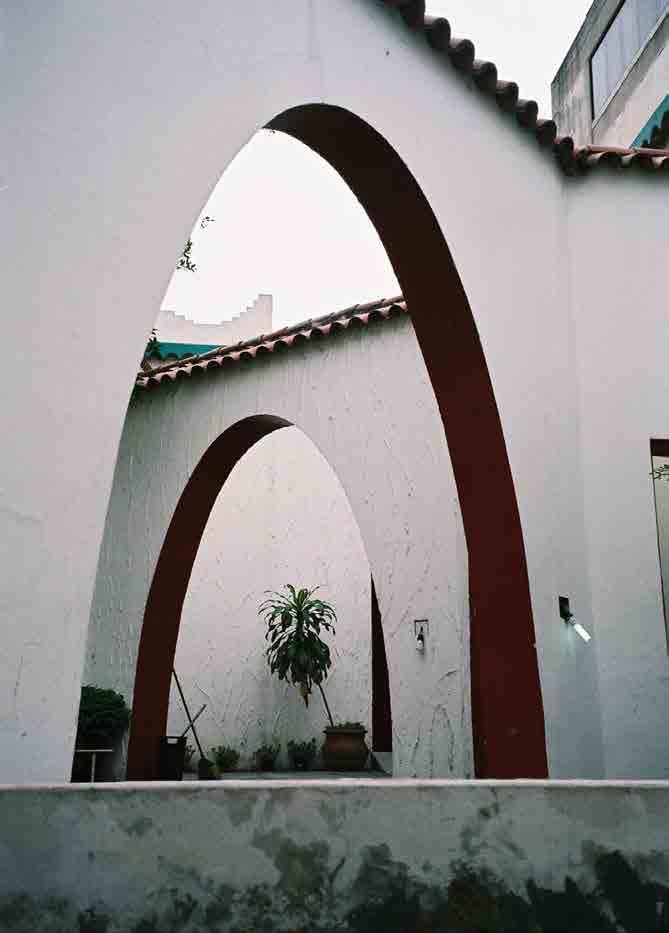
- 103 -
Cristo House, 1929, Guadalajara. •

- 104 -
Gilardi House, 1975, Mexico City.
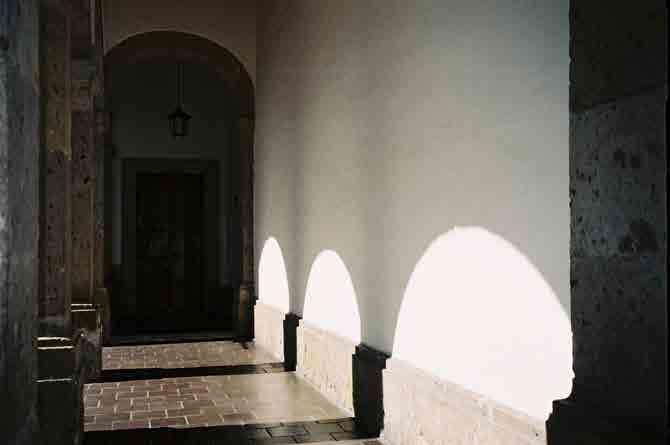
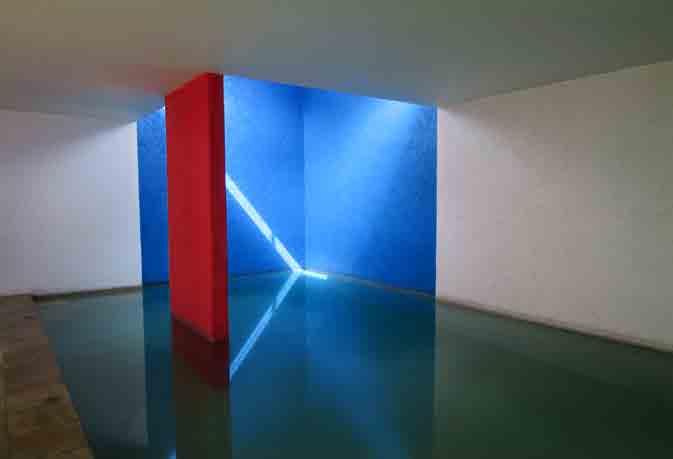
- 105 -
Guadalajara.
Gilardi House, 1975, Mexico City. •
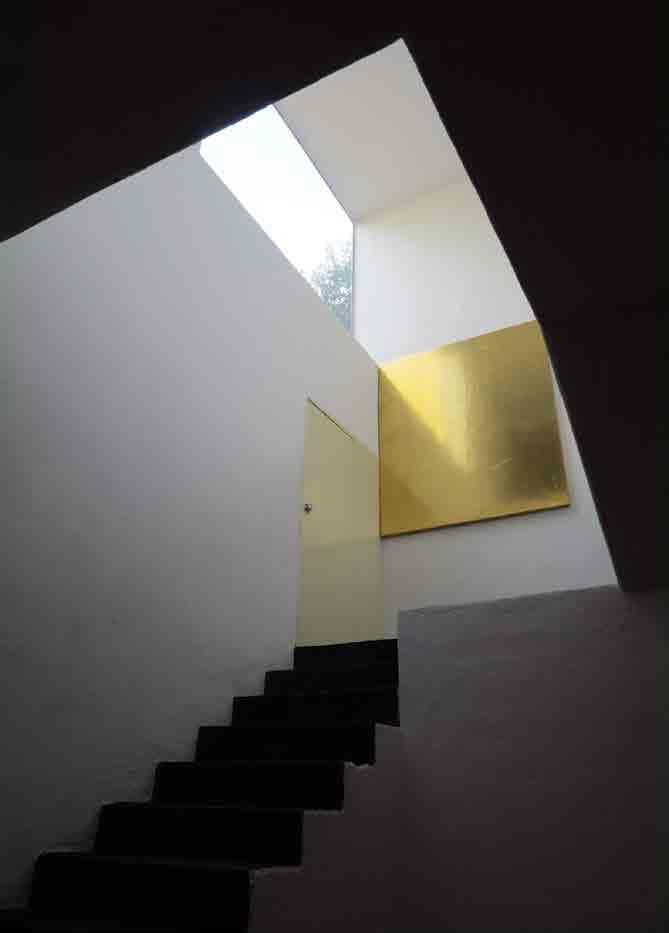
- 106 -
Barragan House, 1947-48, Mexico City.

- 107 -
Barragan House, 1947-48, Mexico City. •
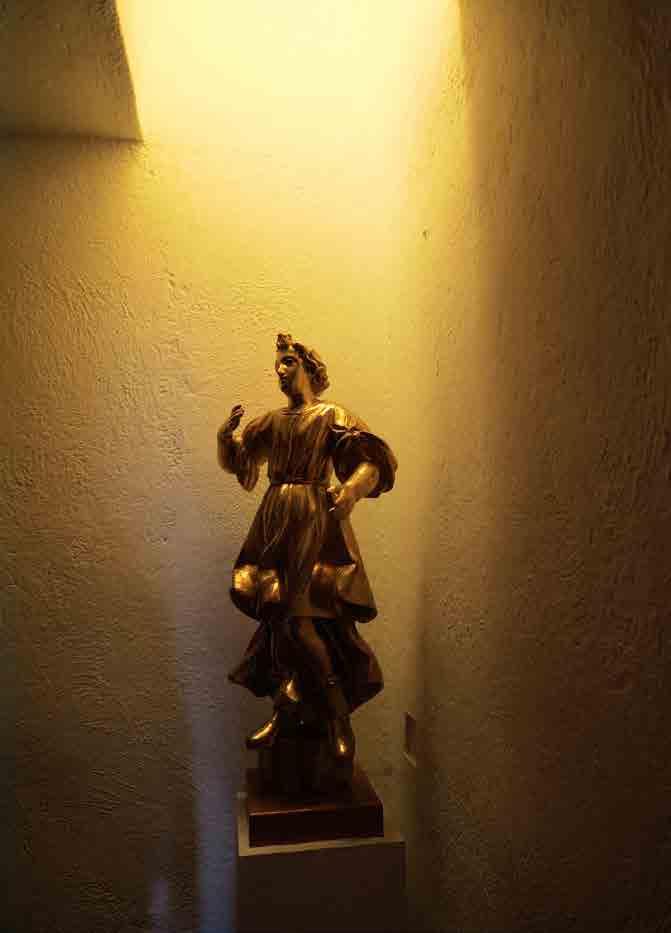
- 108 -
Barragan House, 1947-48, Mexico City.
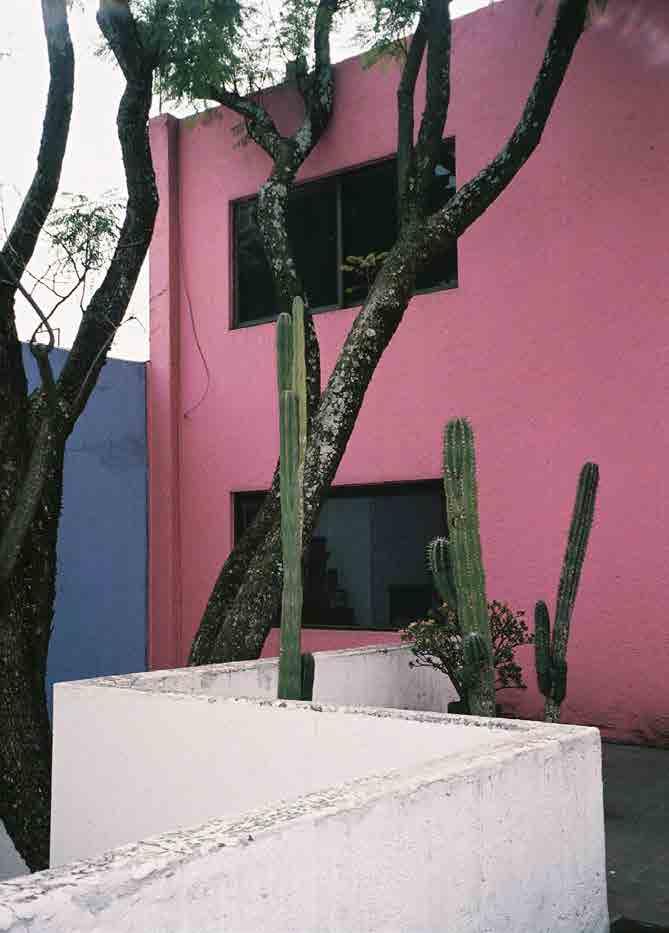
- 109 -
Gilardi House, 1975, Mexico City. •
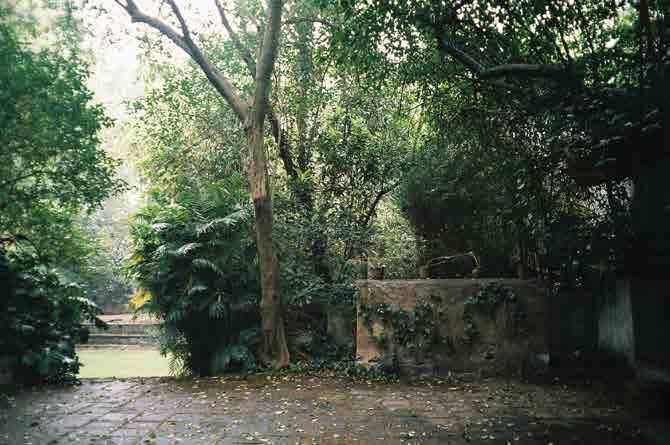
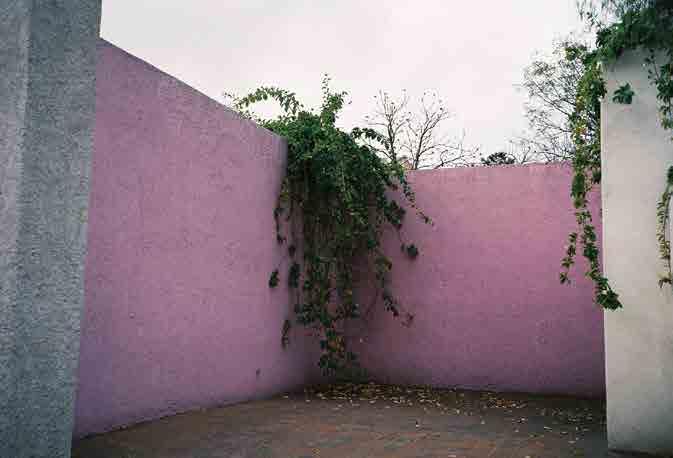
- 110 -
Gardens of Casa Ortega, 1941, Mexico City.
Barragan House, 1947-48, Mexico City.
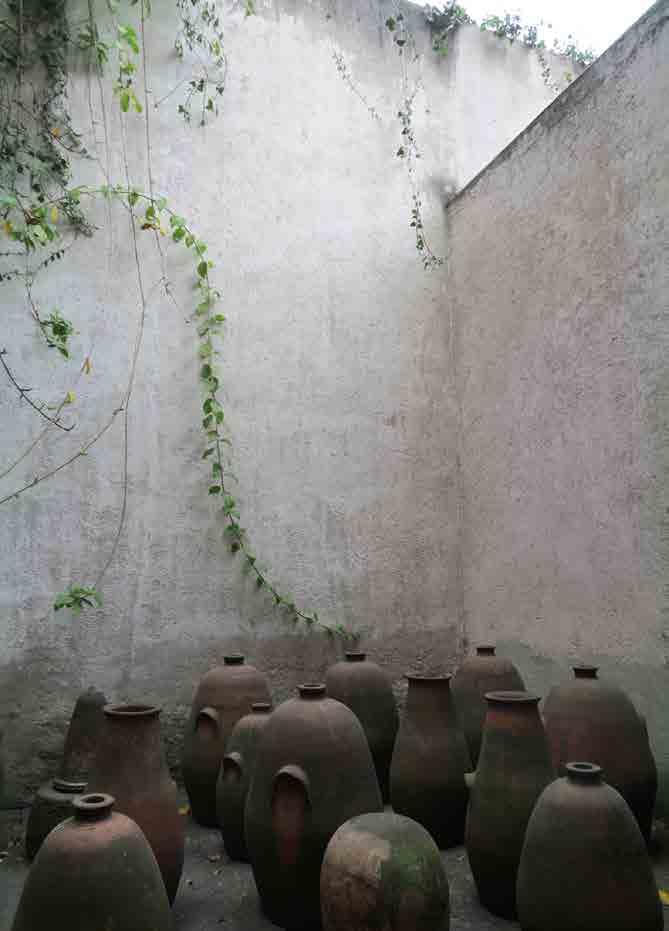
- 111 -
Barragan House, 1947-48, Mexico City. •
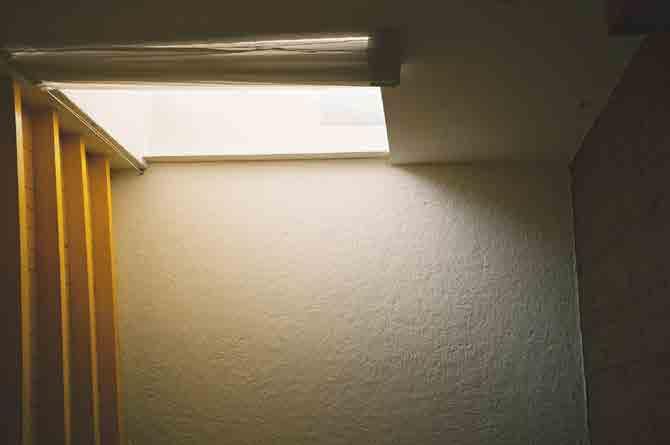
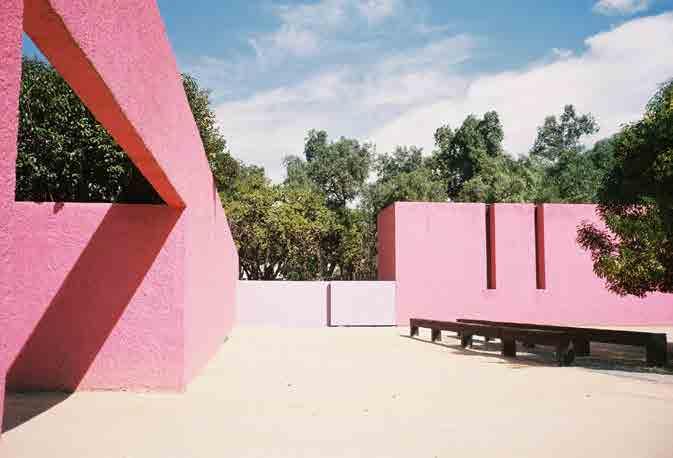
- 112 -
Studio of Luis Barragan, 1947-48, Mexico City.
Cuadra San Cristobal/ Egerstrom House, 1966-68, Mexico City.

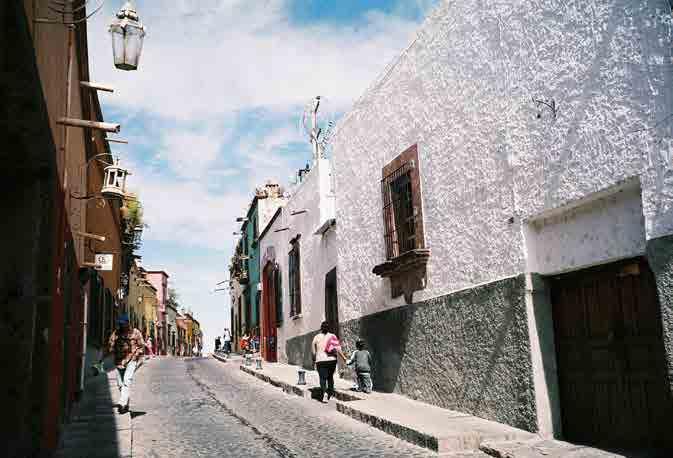
- 113 -
Barragan House, 1947-48, Mexico City.
•
San Miguel de Allende.
a word from the wise
Author Brad Wetherall and Mary Ong
Two EmAGN members interviewed a professional they consider to be a mentor to talk about WORK / REST / PLAY and the interconnected activities and experiences that contribute to a life-balance.
WORK / REST / PLAY – AT Work
As the saying goes, happiness is nothing if not shared. Perhaps the same can be said of experience. Establishing and developing relationships with more experienced practitioners is one way that early-career architects can ensure they are better informed of the industry and better equipped to make the transition in to the workplace, particularly when those relationships develop in a structured, enjoyable and purposeful program.
One such program was the shortlived but unique Architecture Training Workshop, also known as AT Work; a program that combined work, rest and play into useful experience. Run throughout 1983 and 1984, the program placed students on-site working alongside project leaders Murray Slavin and Brian Klopper. Through practical building experiences, students gained hands on, technical know-how in a period where work was particularly hard to come by.
Murray recounted the experience:
‘I was working at Curtin and the part of the course I was running was the last design course before third year students went out to work in a practice. At the same time, there was a fair bit of small development going on around Fremantle and a number of architects were doing bits and pieces around the City. It coincided with a time when
there was a huge depression and there was basically no employment at all for students. So I talked to Brian Klopper, mainly because Brian had been developing projects around Fremantle for quite a while, and I suggested that we look at a program where we buy a property and bring the students in to help to build it.’
Over the course of a year between classes, surf breaks and trips to the pub, alongside Brian and Murray, AT Work functioned much like a traditional small practice. With a hands-on and practical approach, AT Work developed a small cluster of projects in and around Fremantle.
‘We had students working on a variety of things, from laying bricks, to welding steel windows, doing roof framing - stuff like that. It was a very valuable project.’
Reflecting on the program, Murray is confident that in addition to the practical knowledge gained, participants came out with a sound understanding of the issues surrounding construction, and the industry more generally.
‘It didn’t mean they came out with a full knowledge of construction but I’m certain that they came out with an understanding of the issues involved in it and how to solve problems. So really it was about developing an attitude toward processes as much as anything else.’
While the program was fleeting, the lessons are timeless. Faced with an economy that is similarly challenging for students and graduates to find work and develop sustainable connections within the industry, mentoring programs such as AT Work offer direction on how practical, useful knowledge, redefining ‘work’ outside of its traditional bounds, can be shared with young architects to ensure a more sustainable transition in to their early careers.
Brad Wetherall
WORK / REST / PLAY Balance –Is it just a Myth?
Beata Davey completed her architectural studies at Curtin University, is a registered architect and holds postgraduate qualifications in construction law from Murdoch University. She is employed as a Senior Architect at Morley Davis Architects, a small firm practicing in aged care and other diverse projects. She has broad project experience, which includes being part of the team which delivered the Perth Arena.
The idea of finding a balance between working, resting and playing is not new and has been heavily discussed in various spheres. In more recent times this discussion has shifted to finding a life-balance with the different roles we
- 114 -
play in our lives. To Beata, the focus of finding this balance is not so much a conscious thought as it is an acceptance that we are all not going to be equally balanced all the time.
‘You have to accept that there are times where you will be putting more energy into one commitment and become “unbalanced”. One should be conscious in taking time when available to refill in the family, social and relaxing categories. People shouldn’t strive to find the perfect balance otherwise they will be disappointed.’
The topic of motherhood and career is also widely discussed, with gender equity an important matter acknowledged by the Australian Institute of Architects in recent times. As a woman with a young family, she finds that the key contributing factor to enable her to find balance is a supportive partner: ‘without them you can’t do anything.’ Within her family dynamic the concept of co-parenting is practiced daily, with her husband sharing the responsibilities of raising their child.
Prior to having her child, Beata admits that she was quite naive regarding the strong gender bias in architecture. She believed that if she kept her head down and worked hard, then gender will not be relevant in career trajectory. It is no secret that it still is. Knowing this, she
began engaging with wider aspects of our profession: she has been involved in tutoring at Curtin University, mentoring at various formal and informal platforms; most recently via the Women in Architecture mentoring program. She is involved in tutoring at the Practice of Architecture Learning Series (PALS) organised and run by the Australian Institute of Architects which provides support to registering graduates, and more recently she is chairperson for an Australian Institute of Architects awards jury in WA.
So why do all of this? Through her own experience, she noticed that there weren’t many, if any, female architects in positions of authority, mentoring or involved in the PALS tutorials. Consequently she offers her time as she believes that ‘we need to evolve our profession. There needs to be a shift in our culture: young (female and male) graduates need to be shown that it is normal to have women in architecture in positions of authority.’ It is also imperative that employers buy into this culture. On a personal level, Beata hopes that injecting positivity and change will benefit all individuals and create a more open and positive industry for future generations of architects.
‘Finding balance should not be obsessed about - we need to accept the organic nature of our lives and just go with it.
It is just as important to get involved in social / sporting activities as it is in mentoring or advocacy groups in architecture. We shouldn’t aim to gain fulfilment in only one thing in life and if something doesn’t work out, try something else. You have lost nothing and gained invaluable experience.’
Mary Ong
EmAGN are currently preparing a formalised Mentoring Framework to build upon and help facilitate other mentoring activities already existing in WA. Please contact EmAGN should you wish to be involved as a mentor or mentee or just to share your thoughts. •
...
- 115 -
ten from ten
We asked ten architecture and associated professionals ten questions on WORK / REST / PLAY.
 ROBERT SLAVICEK
PRINCIPAL SLAVICEK STUDIO
ROBERT SLAVICEK
PRINCIPAL SLAVICEK STUDIO
ARCHITECTURE
AUSTRALIAN INSTITUTE OF ARCHITECTS
WA CHAPTER COUNCILLOR
Technology has broken down traditional boundaries of the office, and with that the delineation of work, rest and play. What have been the greatest gains you have seen from this change?
The ability for people to have greater influence on how they operate their lives. It removes the restriction of defined time for specific activities.
And what have been the greatest losses? Separating clients’ expectations of workrelated time and personal time.
Do you think the blurring of lines between work, rest and play leads to working smarter or working harder (or more)? This depends on the character of the individual. You need have discipline otherwise you will easily, and very quickly, no longer be focused on any one aspect and find that you are putting
much more effort in for equal or lesser results.
In what ways, if any, do rest and play affect your work?
Rest and play allow my mind to loosen up and be relieved of the pressure of creating results on demand. Allowing for flexibility allows me to assess the task and prepare a much more appropriate response.
Does your work affect your rest and play? If so, in what way?
Absolutely. Architecture is all around us and it continuously evokes emotions in us.
Some projects by their nature invite a level of playfulness. Do you bring play (or rest) into other more sober projects? If so, how? Each project starts with a sense of playfulness or creative freedom. Not every brief might allow for this but it is a starting point to assess how I would personally approach the project.
When you're not working, how do you rest or play?
To completely rest, I need to remove myself from the environment and shut off by engaging in literature or film. Play is easy, as I just look to my sons and they take me away to their imaginative worlds.
If you weren't working in your current profession, on what, how or where else would you like to work?
Travel photography. Exploring places and capturing moments in time.
The intermingling of work, rest and playyour greatest outrage?
An addiction to checking my i-device for personal purposes then without fail being distracted from my rest and play by work notifications.
The intermingling of work, rest and playyour greatest delight?
Having the ability to be present with my family at their most important stages in life.
- 116 -
...
 DEBORAH BINET
DEBORAH BINET
ARCHITECT AND ASSOCIATE DIRECTOR
CAMERON CHISHOLM NICOL
CHAIR AUSTRALIAN INSTITUTE OF ARCHITECTS WA HERITAGE FORUM
Technology has broken down traditional boundaries of the office, and with that the delineation of work, rest and play. What have been the greatest gains you have seen from this change?
The greatest gain I have seen is the opportunity to work more fluidly. I can tailor the way I work to suit my family’s needs. Being connected via technology gives me flexibility and autonomy.
And what have been the greatest losses?
The greatest loss would be the erosion of boundaries between work and private time.
Do you think the blurring of lines between work, rest and play leads to working smarter or working harder (or more)?
I think it depends on how it is managed. If managed well then you do work smarter, which can mean working harder when you need to and
then having periods of respite when the opportunity arises. To do this you need to set clear boundaries and manage expectations.
In what ways, if any, do rest and play affect your work?
Taking the time to rest and play gives me the space and time to be able to think strategically and see things in perspective. It refreshes my mind and gives me renewed energy for work.
Does your work affect your rest and play? If so, in what way?
My work does occasionally intrude into my private time, but the gain is that I am able to hit the ground running when I’m next in the office and work more effectively.
Some projects by their nature invite a level of playfulness. Do you bring play (or rest) into other more sober projects? If so, how? I try to, through the use of colour, form, texture, light, and/or pattern.
When you're not working, how do you rest or play?
I spend most of my time with my two young daughters, and with family and friends. We are quite often at the beach or the park and we are serial birthday party attendees. Being in a creative industry, I am very much interested in the arts and so are my daughters. We like to check out live music, theatre, cafe fit-outs, new buildings and urban design spaces.
If you weren't working in your current profession, on what, how or where else would you like to work?
My four-year-old dreams of being a cowgirl, and you know what? I wouldn’t mind joining her. It would be liberating to try something totally different!
The intermingling of work, rest and playyour greatest outrage? It can be difficult to switch off and be present.
The intermingling of work, rest and playyour greatest delight?
Meaningful work is intrinsic to the fabric of my life. It gives me a sense of purpose and confidence which carries through to my private life.
- 117 -
... •
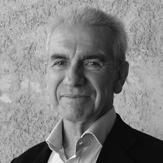
PHILIP GRIFFITHS
DIRECTOR GRIFFITHS ARCHITECTS
IMMEDIATE PAST PRESIDENT
AUSTRALIAN INSTITUTE OF ARCHITECTS (WA)
Technology has broken down traditional boundaries of the office, and with that the delineation of work, rest and play. What have been the greatest gains you have seen from this change?
A lot of what I do is unique and technology means spending a lot of time setting up for a small amount of work. Technology comes into its own with repetitive work and revisiting places for subsequent phases of work. Technology is having some negative impacts with expectations being raised on the basis that it must be easy just to produce work electronically. Working hours have not changed in a positive direction.
And what have been the greatest losses? The great loss has been the lack of capacity to do things very quickly and freehand sketching. I have maintained that capacity, but the emerging
graduates appear to be somewhat reluctant. I think our clients love to see drawings being created as they speak.
Do you think the blurring of lines between work, rest and play leads to working smarter or working harder (or more)? I see the industry relying on unpaid overtime just to be competitive and that is putting the work life balance out of kilter. I don’t expect people to work overtime, but like a lot of practice Principals, I do it anyway.
In what ways, if any, do rest and play affect your work?
Rest and play don’t impact on work. Although I am possibly not the youngest architect in practice, work and play are both fairly high energy.
Does your work affect your rest and play? If so, in what way?
Work is more inclined to impact on rest and play. With a number of board activities, pro bono commitments and a willingness to meet on weekends, rest and play come under a good deal of pressure. The solution seems to be to play hard.
Some projects by their nature invite a level of playfulness. Do you bring play (or rest) into other more sober projects? If so, how? Fun is at the core of what we do. So even the most ‘sober’ projects are sprinkled with levity. It may be in the conduct of the project, or might extend into the outputs too. The aim is to make the whole journey a pleasant experience.
When you're not working, how do you rest or play?
Rest comprises gym, reading, walking, film, theatre, contemporary dance and friends.
If you weren't working in your current profession, on what, how or where else would you like to work?
My alternative on retirement at 85 will be to return to the art that I started out with. At present there is only time to dabble and it’s a bit embarrassing. Honing those skills remains an ambition.
The intermingling of work, rest and playyour greatest outrage?
My greatest outrage in the work, rest and play balance is not to be outraged, which is outrageous. Why is it I seldom complain about the balance.
The intermingling of work, rest and playyour greatest delight?
The greatest delight comes from practice and giving back to the profession. What a privilege it is to meet and help people and to mix with colleagues to explore other ways of thinking, to meet informally, and to discover how much we all have in common. There is so much overlap in work, rest and play and it always puts a smile on my face.
- 118 -
...
 TANYA TREVISAN CHIEF OPERATING OFFICER AT TRG PROPERTIES ARCHITECT
TANYA TREVISAN CHIEF OPERATING OFFICER AT TRG PROPERTIES ARCHITECT
Technology has broken down traditional boundaries of the office, and with that the delineation of work, rest and play. What have been the greatest gains you have seen from this change?
To me the greatest advantage technology brings is being connected to the business and able to work 24/7 no matter where I am. This means being able to work remotely relatively guilt-free. On a practical level being able to send photos and drawings so easily is still like magic – I can remember working in Berlin in 1991 with Manhattan-based clients and engineers and we were entirely reliant on faxes and couriers for the day-to-day sharing of information.
And what have been the greatest losses? I believe that the blurring of the work time and leisure time is the greatest loss, that and people’s patience. I do find that there is an expectation that a new idea
/ thought bubble / issue is immediately worked on / resolved / responded to the same day. There is also an absence of a critical eye or gut feeling to see if something looks right. People think if the answer is provided by a complex software package then it must be right, yet naturally bad data input produces bad data output.
Do you think the blurring of lines between work, rest and play leads to working smarter or working harder (or more)? I believe the opposite has occurred and that there is a temptation to procrastinate with the more challenging stuff because work time is now seemingly endless and the ability to respond is not limited to time spent in the office. To my mind we now work longer but not necessarily smarter. Trying to balance work and parenthood is the thing that led me to work smarter, not technology.
In what ways, if any, do rest and play affect your work?
The more rest and play, the less stressed I find that I am and the more energetic and enthusiastic I become. Stress is a pernicious and subtle enemy, I suspect having some stress makes me work well and stay focused, too much stress and it has an adverse effect.
Does your work affect your rest and play? If so, in what way?
Yes, my work definitely affects my rest and play. Work for me doesn’t really stop, it simply slows a bit after hours. I also sit on the College Council of
Methodist Ladies College and am President of the Property Council (WA) so work and commitments do tend to be seven days a week. I try to attend to ‘after hours’ work at night when other family members are asleep as I have always been someone who prefers to work late rather than early. On a positive note I am trying to train myself not to make immediate response to emails when they arrive after hours and are not urgent. I’m not great at this but I am so much better than I was.
Some projects by their nature invite a level of playfulness. Do you bring play (or rest) into other more sober projects? If so, how? Our latest apartment project Empire West, Perry Lakes has some playful aspects to it: for example the refurbishment of the original Commonwealth Games Scoreboard Building has consciously updated its messaging by converting it from an energy consumer to an energy producer. We did this by introducing what we are told is the only fully integrated PV curtain wall façade in WA which replaced the rusted-out diodes. We have also installed 3m high illuminated javelin-style lights and a 6m corten sculpture that we commissioned specifically for the project. It is by artist Greg Johns who is based in Adelaide and was inspired by the athletic history of the Perry Lakes location. None of these were statutory requirements yet we felt that the historic location is so important that it provided us with a great opportunity to do a bit more. •
- 119 -
When you're not working, how do you rest or play?
Family, friends, wine, architecture and travel – probably in that order - are my favourite pastimes.
If you weren't working in your current profession, on what, how or where else would you like to work?
I really love working within the property industry and I also love being involved with the construction side of our projects too. In my role I get to spend time with people with a range of skills, interests and backgrounds. Working together on large projects that hopefully enhance our built environment and our community is a real pleasure. I really can’t imagine doing anything else. If I was to retire then I suspect that I would want to spend a lot of time travelling, but equally I would still want to continue to be involved with the density debate and improving apartment and built form design and outcomes for our community here in WA.
The intermingling of work, rest and playyour greatest outrage?
Yes and in particular courtesy of my mobile phone – we definitely have a love hate relationship.
The intermingling of work, rest and playyour greatest delight? Ditto.
 ISLA McROBBIE PARTNER (PROJECTS INFRASTRUCTURE AND CONSTRUCTION) JACKSON
McDONALD
ISLA McROBBIE PARTNER (PROJECTS INFRASTRUCTURE AND CONSTRUCTION) JACKSON
McDONALD
Technology has broken down traditional boundaries of the office, and with that the delineation of work, rest and play. What have been the greatest gains you have seen from this change?
I think that, rather than talk about the delineation of work, rest and play, thanks in a large way to technology, we really should now be talking about the blending of work, rest and play. Think about family commitments: whether looking after younger children and older family members, technology has allowed us, in many (not all) situations, to be able to blend as opposed to choosing one over the other (that is not to say the blend is easy!).
And what have been the greatest losses? I think it might be a common theme to my responses – the greatest losses may be exactly the same as the greatest gains.
Do you think the blurring of lines between work, rest and play leads to working smarter or working harder (or more)?
I think we work smarter, harder and more. Society’s concept of time (our need for immediate responses and gratification) has changed and this has been driven by technology. If you want to know something - find it out now. If you want to do somethingdo it now. But if that cultural shift in thinking / needs has occurred in our rest and play, can we expect it to be different at work?
In what ways, if any, do rest and play affect your work?
I think that we are more open to nontraditional options of ‘rest’ and ‘play’ even when these impact on your work. It is the concept of the appropriate blend. As a workplace, you need to recognise that rest and play does not start at 5pm each day (or 5pm on a Friday).
Does your work affect your rest and play? If so, in what way?
There are only 24 hours in a day… extra time is not up for negotiation. The more time I work, the less time for play, and even less time for rest (when you have a family, the ‘rest’ factor always seems to be more malleable).
Some projects by their nature invite a level of playfulness. Do you bring play (or rest) into other more sober projects? If so, how? I suspect the word ‘playful’ does not spring to most people’s minds when they think of lawyers! It is
- 120 -
...
important to bring, at the very least, a playfulness in mindset to your work (even if no one else sees it). Part of that playfulness comes in developing strong relationships with your clients that elevate you above the (sometimes) sobering nature of the legal work itself.
When you're not working, how do you rest or play?
I am learning the violin – I love the fact that it is requires an all-encompassing focus (of course the curled up toes when the notes are a bit ‘off’ would probably enjoy a physical rest!). I have also taken up hockey again this year, after quite a few decades of not playing. That is certainly not a (physical) rest, but both serve an important purpose in refocussing away from work.
If you weren't working in your current profession, on what, how or where else would you like to work?
On particularly tough days, I look out of my office window to Kings Park and think I would love to be a gardener. Having said that, I really enjoyed architecture (practiced for 10 years), yet I have never regretted the move to (construction) law… so I guess that speaks to my current career choice status doesn’t it?
The intermingling of work, rest and playyour greatest outrage?
Technology gives us the ability to blend work, rest and play, hopefully in a positive way. It is also attributed with improving our ability to multi-task, but in my mind there is absolutely no
justification for checking facebook, Instagram or the like during meetings or at presentations.
The intermingling of work, rest and playyour greatest delight?
Rottnest Island. If it were not for the ability to blend work, rest and play, I would probably not get to Rottnest for our annual family holiday with my kids, husband and friends. It is my favourite place to go with the family.
 SUSAN KREEMER PICKFORD GENERAL MANAGER (WA) ENGINEERS AUSTRALIA
SUSAN KREEMER PICKFORD GENERAL MANAGER (WA) ENGINEERS AUSTRALIA
Technology has broken down traditional boundaries of the office, and with that the delineation of work, rest and play. What have been the greatest gains you have seen from this change?
The ability to connect with anyone at anytime anywhere regarding anything. For me, the construct of work needing to be done ‘at work’ (as opposed to another site or at home) within traditional work hours has always felt constraining.
And what have been the greatest losses?
Feeling a sense of always being switched on – that there is always something else to do. I have to now be mindful to put my phone away and switch off, to be present with what is going on around me. As I walk between meetings I see a sea of people staring into their phones and I wonder how disconnected we are becoming from the real world through living in this virtual world. •
- 121 -
...
Do you think the blurring of lines between work, rest and play leads to working smarter or working harder (or more)? I believe the ability to work more flexibly (via technology) allows you to work smarter - but only if you use it to your advantage. Discipline is essential to ensure you don’t get caught up in doing more work because you have the ability to do so. Previously I worked long hours into the night to finish a task or get on top of my workload and now I trust myself to rest properly and come back to work the next day refreshed. This will get the work done quicker and I have not exhausted myself in the process.
In what ways, if any, do rest and play affect your work?
I bring a different energy to my day (and hopefully my team) when I feel rested and refreshed – I know when I feel under pressure that I am not going to do my best work. Taking a break in the moment to rethink something by going for a walk or asking a team member for their help allows me to take stock of a situation and find a better way to resolve it. Planning in advance for social occasions and exercise and then following through on them is key for me to unwind and be better placed the next day for a full day’s work.
Does your work affect your rest and play? If so, in what way?
This role has very varied hours and so, whilst I monitor the number of hours I work over the course of a week, it is hard to schedule regular times for social activities. To counteract the busyness
of the working week, my husband and I are happy to just go with the flow most weekends. This allows us to spend time together at home with our young family. I then enjoy the spontaneity of venturing out when the mood takes us.
Some projects by their nature invite a level of playfulness. Do you bring play (or rest) into other more sober projects? If so, how? I like to bring a creative element to most of the work we do so that whilst we are working hard, the environment is one where all ideas are encouraged, however left-of-centre or seemingly random. The team are empowered to challenge aspects of our work and culture. In my view, creating opportunities for people to voice their ideas and collaborate is essential to producing great work. I believe in humour and the power of random ideas to achieve creative thinking.
When you're not working, how do you rest or play?
I enjoy spending time with my family outdoors or visiting new or well-loved spots in and around Perth. I do Pilates and most weeks go on two evening walks with a group of school mums. We live in the hills so we fit in a few steep climbs. A favourite pastime is chilling out with a great book and a cup of coffee.
If you weren't working in your current profession, on what, how or where else would you like to work?
Running a yoga retreat in the outback with no phone or internet connections. Then I would come back to the city
and work with young people, teaching, coaching or helping them develop new ways of working to give them opportunities to which they might not ordinarily be exposed. And I would write blogs for global publications.
The intermingling of work, rest and playyour greatest outrage?
Not switching off my phone as I want to look at one more thing... Knowing that ‘work’ albeit paid work or work on personal matters is sitting in the room with me and I have to work at ignoring it. On most weekends, I try and leave my phone in the house now.
The intermingling of work, rest and playyour greatest delight?
Knowing that I can check on emails at any time so I am not confined to being in the office. An hour out from leaving work, I scan my inbox and decide what to respond to, or work on, within that allocated time. I flag emails to read later so I can focus on being 'on task' in the office or fully present with my team when we are working on something together.
- 122 -
...
 BO WONG ART, ARCHITECTURE AND DESIGN PHOTOGRAPHER
BO WONG ART, ARCHITECTURE AND DESIGN PHOTOGRAPHER
Technology has broken down traditional boundaries of the office, and with that the delineation of work, rest and play. What have been the greatest gains you have seen from this change?
My office is a combination of a caravan (The Lemon Delicious) in the City and a house on the south coast of WA. Clearly, I’m all for the breakdown of traditional office environments!
This has been the biggest and most positive change in my working and personal life - it gives me the agility to rest and play in the way I need to nourish my life and keep working, doing what I love.
And what have been the greatest losses?
The loss of a standard set of time expectations from our colleagues and ourselves. Monday to Friday, nine to five - they’re gone. Freelance photographers’ hours can be totally out of control. I think it’s up to all of us to respect the boundaries our colleagues have created
for themselves with regard to their family life and rest time – we are all responsible for creating that new world order in what we ask of others and what we expect from ourselves.
Do you think the blurring of lines between work, rest and play leads to working smarter or working harder (or more)?
All of the above. Smarter, harder, more. The goalposts have shifted. Many freelancers like me take a variety of jobs for money, passion or opportunity - generally a combination of all three is a win. Having access to my emails on holiday doesn’t mean I’m working smarter – rather it can reduce efficiency rather than increase it, so that’s an organisational issue we all have to contend with.
In what ways, if any, do rest and play affect your work?
I think if I am well rested I am more potent, efficient and engaged in my work. I often hit the City for a big week of shooting well rested from being in the country and I’m like a sprinter out of the blocks. I find it a really great framework for funnelling my energy.
Does your work affect your rest and play? If so, in what way?
Yes! A tangential idea from a commissioned shoot will often rematerialise as another more hare brained shoot with friends. It may have no market and will likely cost us money and time, but it’s fun and when there’s no brief or deadline, there’s room for rumination and new ideas. So I often
find my work acts as a springboard for ideas and vice versa.
Some projects by their nature invite a level of playfulness. Do you bring play (or rest) into other more sober projects? If so, how?
I’m very aware that people have invested time and money in me being on the shoot so I’m not one to throw caution to the wind - my playfulness is securely set inside technical boundaries… a ‘play pen’ shall we say? I do play well with others inside the play pen though, now known as a collaboration!
When you're not working, how do you rest or play?
I don neoprene and swim at Greens Pool in William Bay National Park a few times a week. Not only am I in the most beautiful place in the world but the bonus is there’s no phone service out there. It’s mental and physical space –and I may be kidding myself, but I think there are less sharks there.
If you weren't working in your current profession, on what, how or where else would you like to work?
If I wasn’t a photographer, I’d be in graphic design or I’d be a copy editor. Like photography, they’re about interpreting and re-ordering existing information into something that communicates more powerfully.
The intermingling of work, rest and playyour greatest outrage? Completely unreasonable expectations on turnaround times that impinge on my family time. •
- 123 -
The intermingling of work, rest and playyour greatest delight?
I become friends with many of the people I work with, so I love that we can talk about projects, our families, our personal challenges and our triumphs. This warmth with colleagues is what makes working both rewarding and fun – and that for me is a delight.
 LUIZ AGUIAR DESIGN MANAGER JAXON CONSTRUCTION CHAIR AUSTRALIAN INSTITUTE OF ARCHITECTS WA BIM COMMITTEE
LUIZ AGUIAR DESIGN MANAGER JAXON CONSTRUCTION CHAIR AUSTRALIAN INSTITUTE OF ARCHITECTS WA BIM COMMITTEE
Technology has broken down traditional boundaries of the office, and with that the delineation of work, rest and play. What have been the greatest gains you have seen from this change?
My generation has grown up with the basic technology we use today. With that in mind, the changes I have witnessed in the work environment are perhaps less obvious than it would be for older and wiser architects out there. Mobility is perhaps the greatest gain - the ability to communicate no matter where you are. Using mobile phones, iPads and laptop computers and being able to manage time the way you see fit.
And what have been the greatest losses? I feel that we have lost the human interaction. Communication technology gives you the perception that your friends seem closer when you receive notifications via social media. I
like to ride the train once in a while and observe people. What I have noticed is that the majority of people stare at screens, even when in small groups you can see one or two people looking at their devices and not participating.
Do you think the blurring of lines between work, rest and play leads to working smarter or working harder (or more)? There is an implied expectation for an immediate answer or action. This is not necessarily smarter, nor harder. The workload on projects is more or less the same, perhaps with a change in processes. Information flow and communication can cause additional stress.
In what ways, if any, do rest and play affect your work?
Rest is certainly important as a way to release some of the stress. I must fit in the occasional rest day to ‘recharge my batteries’ so to speak and return to work fresh and revitalised. I like to play with technical challenges. This is reflected in my choices for recreational activities: sailing, diving, martial arts etc. Additionally, working for a builder gives me the opportunity to apply these skills and principles to my job.
Does your work affect your rest and play? If so, in what way?
Work distractions affect my rest and play but equally, rest and play distractions can also affect my work. I would suggest that good things come out of both, most of the time. I try to
- 124 -
...
find balance but sometimes I find it hard to turn my brain off work mode. I keep thinking of problems I need to solve and things that need to be sorted. It is not uncommon to have a solution for a work situation right in the middle of a leisure activity.
Some projects by their nature invite a level of playfulness. Do you bring play (or rest) into other more sober projects? If so, how? Always. However, I don’t think that the kind of playfulness I apply to these projects is something that can be easily noticed by other people. As I said before, I enjoy playing with the technical aspect of the architectural details: fabrication and site assembly and service coordination. These elements, if done correctly, most often pass by without being questioned after the completion of the job and are only relevant to people who have been involved in the process. You know you have done it well if it disappears.
When you're not working, how do you rest or play?
I don’t think I have had a decent holiday in years. If I ever have another chance at a good holiday I would rest a lot and play hard. But most importantly, enjoy time with the family.
If you weren't working in your current profession, on what, how or where else would you like to work?
I would like to be an astronaut. How’s that for technical challenges? Aim for the stars.
The intermingling of work, rest and playyour greatest outrage?
Phone calls that demand an email in the middle of the night.
The intermingling of work, rest and playyour greatest delight?
Flexibility and the people that I work with (some of them).
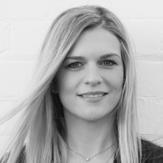
SALLY WEERTS
ARCHITECT
CODA STUDIO
DIRECTOR ARCADIA DESIGN STUDIO
Technology has broken down traditional boundaries of the office, and with that the delineation of work, rest and play. What have been the greatest gains you have seen from this change?
The first thing that comes to mind is the ease and ability to be agile in the way that I work – any time, any place. But more than that, the rapid advancement of technology we see today enables us all to consume design at rate that we never anticipated. This means that the inevitable juggle of life can sometimes disguise ‘work’ as ‘play’.
And what have been the greatest losses? For me the greatest loss has been the discipline to maintain sensible and healthy working hours. The notion of ‘work-life balance’ is a difficult concept to practice, much less master. Being able to work any time and any place also has its disadvantages in that work often creeps into the hours of the day (or night) when it wouldn’t normally. •
- 125 -
...
Do you think the blurring of lines between work, rest and play leads to working smarter or working harder (or more)? I’m yet to fully master the art of working smarter and I am aware there are numerous apps and programs that have been developed over the years to help us all be more efficient in all aspects of life. In the end, I feel those blurred lines really just lead to a cultural expectation that everyone should always be available, which inevitably requires us all to work harder (or more). Maybe the future will bring us an app that will help us all switch off from the alerts from our numerous devices.
In what ways, if any, do rest and play affect your work?
The opportunity to travel and see different parts of the world has offered so much to the practice of architecture globally. Being able to experience a place, its culture and buildings has enabled me to think outside of my own small town experiences in Perth.
Does your work affect your rest and play? If so, in what way?
My work would definitely impact the degree to which I can enjoy and be full immersed in the idea of ‘time off’. It could almost be mapped as a curve graph in that the further I get away from work (and access to internet), the more I can truly switch off. But then Einstein only every slept for four hours at a time to keep his brain engaged… so maybe it’s a good thing that I never go too far for too long.
Some projects by their nature invite a level of playfulness. Do you bring play (or rest) into other more sober projects? If so, how? I thinks it’s really important to remain humble in this business and for that reason I have never taken myself too seriously. Every project should be fun and an enjoyable experience and I would hope that my work represents that philosophy.
When you're not working, how do you rest or play?
This can be defined by many things but the easiest way to capture what I would describe as a leisure activity would be anything that doesn’t involve a computer screen. This could also then be further supported by wine, loud music, a good view and great company.
If you weren't working in your current profession, on what, how or where else would you like to work?
This is a difficult question to answer because I have never contemplated doing anything else. I am sure I’m just fitting the stereotype of every architect - ever… but I believe I have my dream job. If I had ever thought about doing something else I probably would have pursued that with just as much energy and determination. In saying that, I have always like the idea of being a set designer.
The intermingling of work, rest and playyour greatest outrage?
The introduction of smart phones. Particularly the ability to access emails
on a hand held device. It’s probably the single greatest innovation in enabling mobility in the way we work but that comes part in parcel with the temptation to treat every email as a matter of urgency! Bring back the days of the pager I say…
The intermingling of work, rest and playyour greatest delight?
The introduction of Instagram to the world of designers and architects. It’s still something that I think our profession is slowly discovering but I really do enjoy peeking into the world of other practitioners. It has become a guilty leisure activity of mine.
- 126 -
...
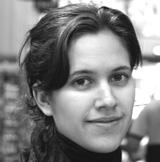 AMANDA HENDRY
AMANDA HENDRY
ARCHITECT MORLEY DAVIS ARCHITECTS
CHAIR AUSTRALIAN INSTITUTE OF ARCHITECTS WA EmAGN COMMITTEE
Technology has broken down traditional boundaries of the office, and with that the delineation of work, rest and play. What have been the greatest gains you have seen from this change?
The exchange of information done remotely. Exchange of ideas, support and dialogue with peers who are working in most corners of the globe (Asia, Europe, North America, South America) is easy and happens instantaneously.
And what have been the greatest losses?
Oversharing of information. When your work colleagues can see your holiday snaps in real time, is there any private and public separation anymore? We all need to consciously work out this balance for ourselves.
Do you think the blurring of lines between work, rest and play leads to working smarter or working harder (or more)?
Working harder, although I’m sure we all try for smarter. In this tough economic climate everyone is trying to prove their value and blurred boundaries can easily lead to ‘work’ taking up a larger piece of the pie.
In what ways, if any, do rest and play affect your work?
Rest and play offer valuable mental distance from work, necessary for that fresh take or new perspective on projects. I constantly see new takes on any challenging items first thing in the morning.
Does your work affect your rest and play? If so, in what way?
Certainly in travel, but I’m sure this applies to most of us. I feel grateful that this profession offers us the opportunity for any unrelated experiences and information to meaningfully contribute to our work.
Some projects by their nature invite a level of playfulness. Do you bring play (or rest) into other more sober projects? If so, how?
I’m currently working on a residential care facility project that has ‘celebration of life and whimsy’ as part of its core ideals. This typology has a very sobering aspect to it, so playfulness and lightness is being strongly championed.
When you're not working, how do you rest or play?
A fellow architect dragged me into the indoor rock climbing scene and it seems to attract the most amazingly interesting professionals and
individuals.
If you weren't working in your current profession, on what, how or where else would you like to work?
If I had an answer for this, I think I would currently be re-enrolling at university. I greatly admire practitioners who successfully combine practicing and research - this provides an aim for how I want to work.
The intermingling of work, rest and playyour greatest outrage?
When you receive work emails from consultants or colleagues who have their auto-reply emails set to say that they are on annual leave. It’s always great to receive these necessary responses but at what cost are we always responding immediately to items that crop up?
The intermingling of work, rest and playyour greatest delight?
Being involved in advocacy and volunteer work as Chair of EmAGN. It’s been a great ride so far. •
- 127 -
is there a place for playfulness in architecture?
The answer is an obvious ‘yes’ but, in my view, it should be confined to circuses, Luna Parks and showgrounds. In the general field of construction, which I consider to be the foundation of civilization, there is little place for playfulness, but there is certainly room for structural imagination and decoration. For structural imagination look at the work of Frei Otto, Pier Luigi Nervi, Felix Candela and Kenzo Tange. For decoration check the highly decorated buildings of Antoni Gaudi, the wonderful, glowing tile patterns on so many Muslim mosques and schools and the carved timbers on Japanese shrines and temples. Imagine the loss if Saint Basil’s in Moscow or the Florence Cathedral didn’t have their colours.
Applications should be thoughtful, not playful. To achieve great architecture, taste, proportion, sound structural approaches and elegant use of materials must be skilfully amalgamated. Great architecture comes from innate artistry, technical skill and an understanding of the potentialities of materials and effort. It does not come from game playing, however attractive that may be to some. Architecture is not a contest between the most messily jointed, complex and difficult to build structures, such as those the current doyen of sculptural architects Frank Gehry has managed to produce for the Louis Vuitton Foundation. Here we see rare and expensive materials and complex layouts so that the buildings are inefficiently planned, cost more than is reasonable and are a nightmare to maintain.
Author Peter Bruechle
Buildings must first meet the practical demands for which they have been constructed. They should be designed in such a way that it is clear how they are to be built and they should generally be built from materials that are reasonably available, compatible and that can be readily maintained. Importantly, they should enhance their surroundings.
Although I put meeting the practical demands of buildings first, there are other, more subtle demands on design architects. Some buildings need to create an atmosphere, an ambience that transcends practicality. Religious buildings, cathedrals, mosques and synagogues, and even Stonehenge come to mind. University buildings should not only provide space but also inspiration. Cambridge is an example. Architecture is a complex human activity and it requires practitioners who are conscientious, have a store of practical knowledge, understand the limitations of materials, and understand the construction process.
Architecture is both an artistic and a practical challenge. It requires imagination, understanding of structure, appreciation of proportion, ability to design for elegance and an understanding of what is required to provide both a suitable ambience and the practicalities of a building: light, climate control, circulation, maintenance and the frameworks necessary to provide power, water and effluent disposal. Architecture has to be detailed in such a manner that it will age gracefully. There is little room for
playfulness unless that is a requirement of the client. There is, however, room for decoration.
Good architects are well aware of all this of course, but such basic tenets are often being ignored by architects who now follow or create fashions. It seems to me that architecture has become a victim of a series of fashions that have spread throughout the world even though they are quite inappropriate.
Those architects who have abandoned taste, proportion, elegance, practicality and tradition in favour of strangely sculptured shapes, such as Jean Nouvel’s Paris Philharmonic, produce architecture that is difficult to build, extremely expensive and difficult to maintain. This impractical architecture is now given awards by assessing panels. If the Perth Arena was the best building in Australia in 2015 I despair - and the basement leaks.
I realise that as a structural engineer my views on architecture will not be taken too seriously by the profession, but I have been encouraged by the positive comments of several senior architects who have read my short book Egotecture? Although I am not an architect, I have worked closely with some fine architects both in Australia and overseas on award winning and leading edge buildings. I have the advantage of being able to stand back from, and not having to compete with, other architects. •
- 128 -



 Mondoluce is the sole importer and distributor for iGuzzini in Western Australia.
Mondoluce is the sole importer and distributor for iGuzzini in Western Australia.
































































































































 ROBERT SLAVICEK
PRINCIPAL SLAVICEK STUDIO
ROBERT SLAVICEK
PRINCIPAL SLAVICEK STUDIO
 DEBORAH BINET
DEBORAH BINET

 TANYA TREVISAN CHIEF OPERATING OFFICER AT TRG PROPERTIES ARCHITECT
TANYA TREVISAN CHIEF OPERATING OFFICER AT TRG PROPERTIES ARCHITECT
 ISLA McROBBIE PARTNER (PROJECTS INFRASTRUCTURE AND CONSTRUCTION) JACKSON
McDONALD
ISLA McROBBIE PARTNER (PROJECTS INFRASTRUCTURE AND CONSTRUCTION) JACKSON
McDONALD
 SUSAN KREEMER PICKFORD GENERAL MANAGER (WA) ENGINEERS AUSTRALIA
SUSAN KREEMER PICKFORD GENERAL MANAGER (WA) ENGINEERS AUSTRALIA
 BO WONG ART, ARCHITECTURE AND DESIGN PHOTOGRAPHER
BO WONG ART, ARCHITECTURE AND DESIGN PHOTOGRAPHER
 LUIZ AGUIAR DESIGN MANAGER JAXON CONSTRUCTION CHAIR AUSTRALIAN INSTITUTE OF ARCHITECTS WA BIM COMMITTEE
LUIZ AGUIAR DESIGN MANAGER JAXON CONSTRUCTION CHAIR AUSTRALIAN INSTITUTE OF ARCHITECTS WA BIM COMMITTEE

 AMANDA HENDRY
AMANDA HENDRY